Early Los Angeles Historical Buildings (1800s)
Historical Photos of Early Los Angeles |
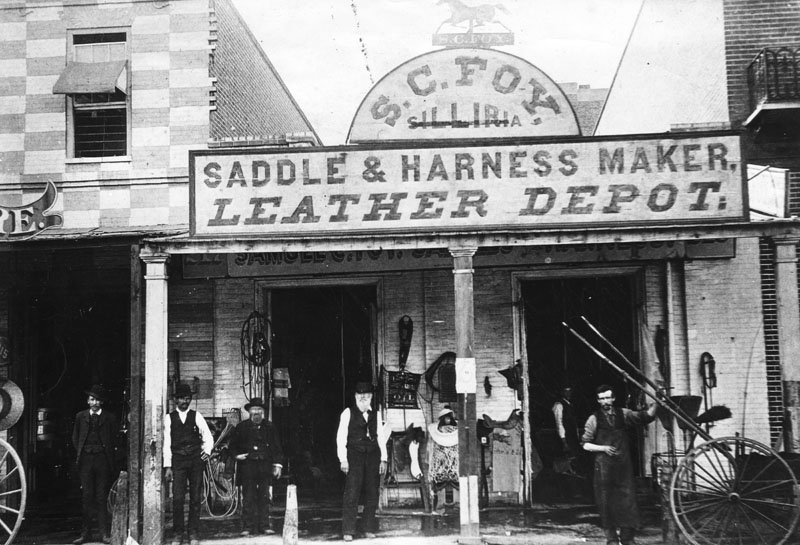 |
|
| (1860s)* - Exterior view of S. C. Foy saddlery shop, housed in a one-story, brick building with a portico. The store sign reads "Saddle & Harness Maker, Leather Depot" and has a silhouetted prancing horse on top. Tack and saddles are displayed on the front and several men are posing for the camera. |
Historical Notes Samuel Calvert Foy moved to Los Angeles in 1854 and operated a successful harness business at 217 Los Angeles Street, which was the oldest business establishment in the city at the time of his death. He also served as the city's Chief of Police for a time. In 1872, Foy built a house at the corner of Grasshopper (now Figueroa) and 7th Streets. The house was reportedly "the first three-story building in the city." At the time the Foys built their house, the site was considered to be "way out in the country." Foy's daughter, Mary Foy, was the city's first woman librarian from 1880-1884, a leader in the California Women's suffrage movement, a leader of the Democratic Party, and the first woman to be a member of one of the major parties' national committees.^* |
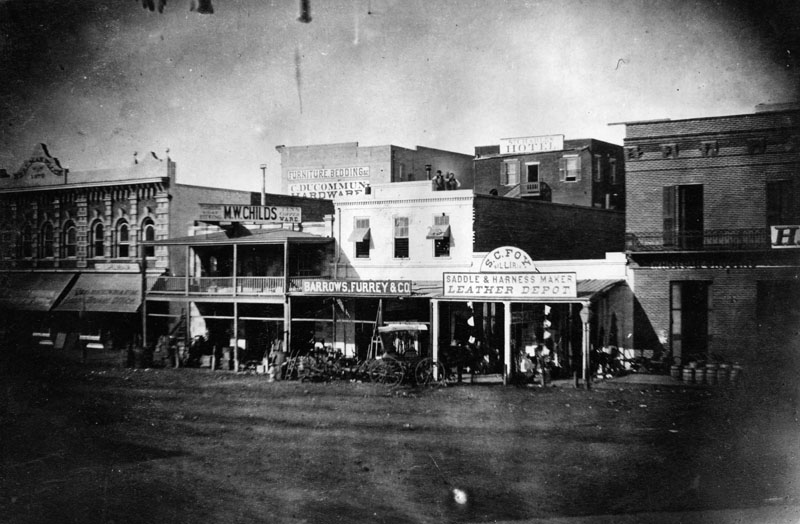 |
|
| (1870s)* - View of the west side of North Los Angeles Street, between Commercial and Arcadia streets. The Samuel C. Foy Leather Depot stands in the center-right. In the far left is one of the first two-story buildings built in Los Angeles, by I.W. Hellman in 1870. |
Historical Notes Isaias Wolf Hellman was a German-born American banker and philanthropist, and a founding father of the University of Southern California. On September 1, 1868, Hellman and Temple founded Hellman, Temple and Co., the fledgling city’s second official bank. In 1871, Hellman and John G. Downey, a former governor of California, formed the Farmers and Merchants Bank, which became Los Angeles' first successful bank. Hellman lent the money that allowed Harrison Gray Otis to buy the Los Angeles Times and Edward Doheny and Charles Canfield to drill for oil. Hellman was also a major landowner in Southern California and his holdings included numerous city lots and vast swaths of former rancho land. In 1871, he and a syndicate bought the 13,000-acre Rancho Cucamonga. In 1881, Hellman and members of the Bixby family purchased the 26,000-acre Rancho Los Alamitos (now home to Long Beach and Seal Beach). He also purchased the Repetto Ranch (now Montebello) with Harris Newmark and Kaspare Cohn. Hellman and Downey also bought up swaths of Rancho San Pedro from the Dominguez family. Hellman also owned much of Boyle Heights with William H. Workman. At his death in 1920, Hellman was considered the leading financier of the Pacific Coast. His son (I.W. Jr.) and grandson (Isaias Warren Hellman) later became presidents of Wells Fargo Bank; and the Union Trust Company was merged with Wells Fargo after his death. His original Farmers and Merchants Bank would later merge with Security First National Bank.^* |
Arcadia Block
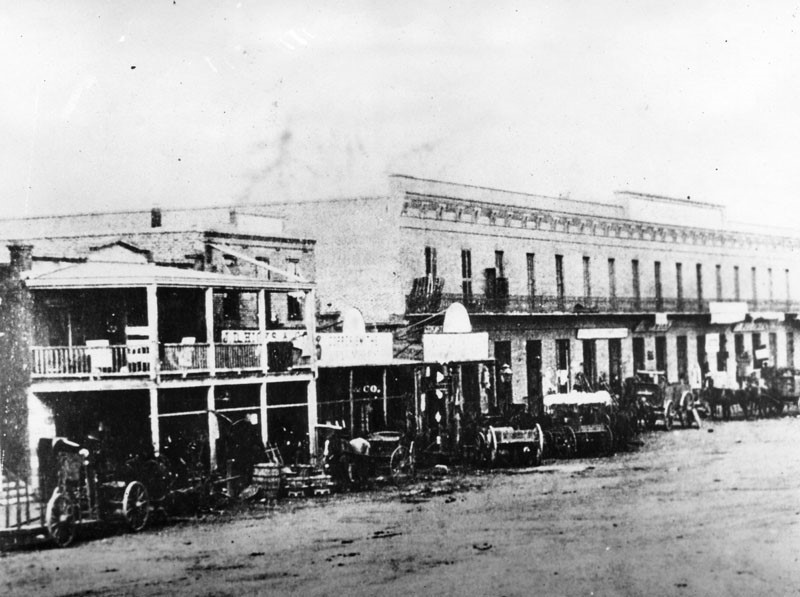 |
|
| (ca. 1870s) - View showing Don Abel Stearns' Arcadia Block, the first brick business building in Los Angeles, later demolished for the #101 Freeway. To its left is the Samuel C. Foy Building. Numerous horse-and-buggies are parked in front. |
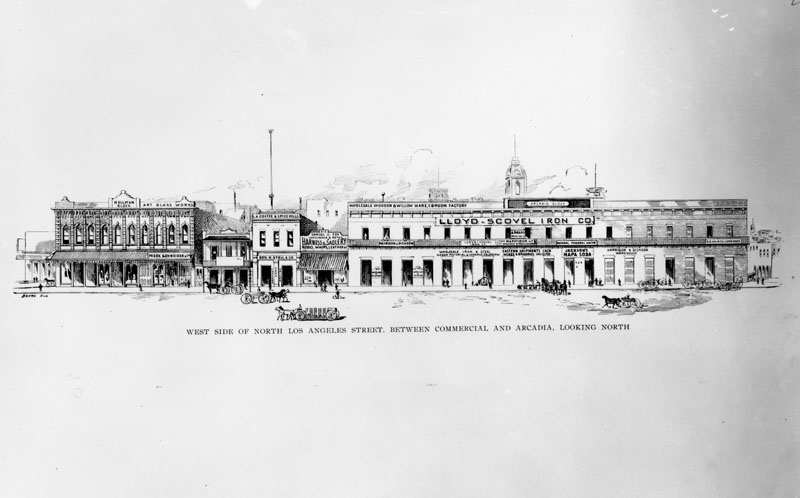 |
|
| (1896)* - An artist's drawing of the west side of North Los Angeles Street, between Commercial and Arcadia, looking north. Arcadia Block, on the right, is on the southwest corner of Los Angeles and Arcadia Streets. The three towers of Baker Block can be seen in the background. The Hellman Building is on the left, then Samuel C. Foy Building, Wholesale & Retail Harness & Saddlery at 315 North Los Angeles Street. |
* * * * * |
Abel Stearns Adobe
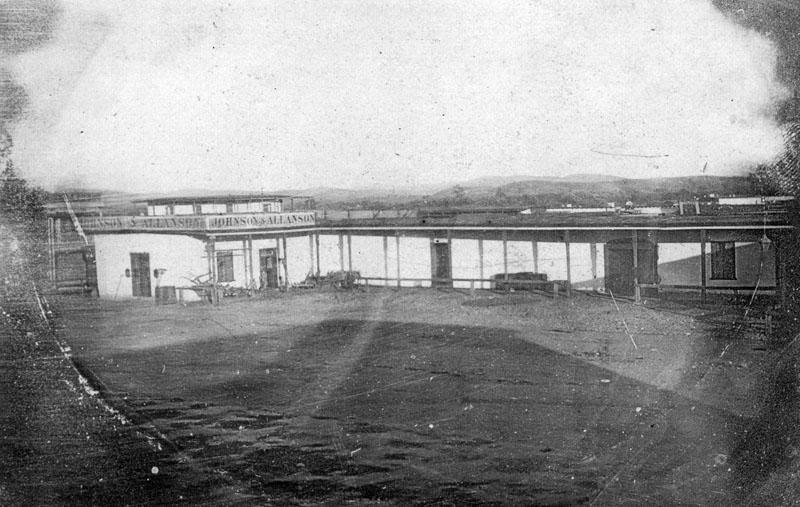 |
|
| (1857)* - View of Abel Stearns adobe known as "El Palacio", located on the southeast corner of Main and Arcadia streets. Stearns purchased the land from Francisco O'Campo and built his adobe. He gradually expanded the adobe from 1835-1838, and the home eventually became U-shaped with a wide-open cobblestone court, and contained a grand ballroom at least 100 feet long. At the time, it was the largest and most magnificent house in the pueblo, which the natives gave the name of "El Palacio de Don Abel", or simply "El Palacio". It became the site of the Baker Block in 1878. |
Historical Notes In 1829 Abel Stearns came to Monterey, California, then settled in Pueblo de Los Angeles, present day Los Angeles. He obtained a concession to build a warehouse in San Pedro. Later, he established a stagecoach route connecting San Pedro Bay with the Los Angeles pueblo. In 1831, he built a three-story flour mill on North Spring Street, Los Angeles. Soon Stearns became one of the most prominent and influential Californian citizens of the pueblo.^* |
 |
|
| (1857)* - Panoramic view of Abel Stearns adobe known as "El Palacio", located on the southeast corner of Main and Arcadia streets; four men stand scattered in the area, and two others sit in a horse-drawn carriage. Stearns purchased the land from Francisco O'Campo and built his adobe, gradually expanding the home over the years until it took on the proportions of a mansion - which the natives gave the name of "El Palacio de Don Abel", or simply "El Palacio". |
Historical Notes Abel Stearns represented Los Angeles under American military rule, 1848-1850. He was a delegate to the 1849 California Constitutional Convention, representing the district of Los Angeles; later he was California State Assemblyman, and a Los Angeles County Supervisor and Los Angeles City Councilman. In 1842 Stearns bought the 28,000-acre Rancho Los Alamitos between the Los Angeles and the harbor. However, there was a drought between 1862 and 1864 which was said to have resulted in the death of 50,000 cattle on Stearns land alone. Stearns mortgaged the rancho to Michael Reese, who then purchased it at a sheriff's sale and Reese's estate then sold it to John W. Bixby.^* |
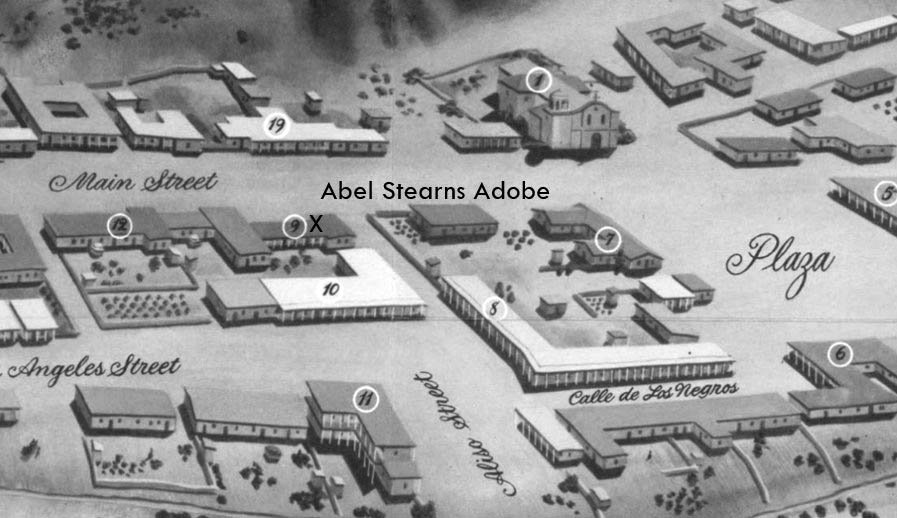 |
|
| (ca. 1850)^** - Photo of a sketch showing the LA Plaza and surounding area as it appeared in 1850. The Abel Stearns Adobe is located on the southeast corner of Aliso and Main streets and is marked with an X and the No. 9. The map is based on the 1849 Ord Survey. |
Historical Notes In 1878, the Baker Block would be built on the same site as the Stearns Adobe. |
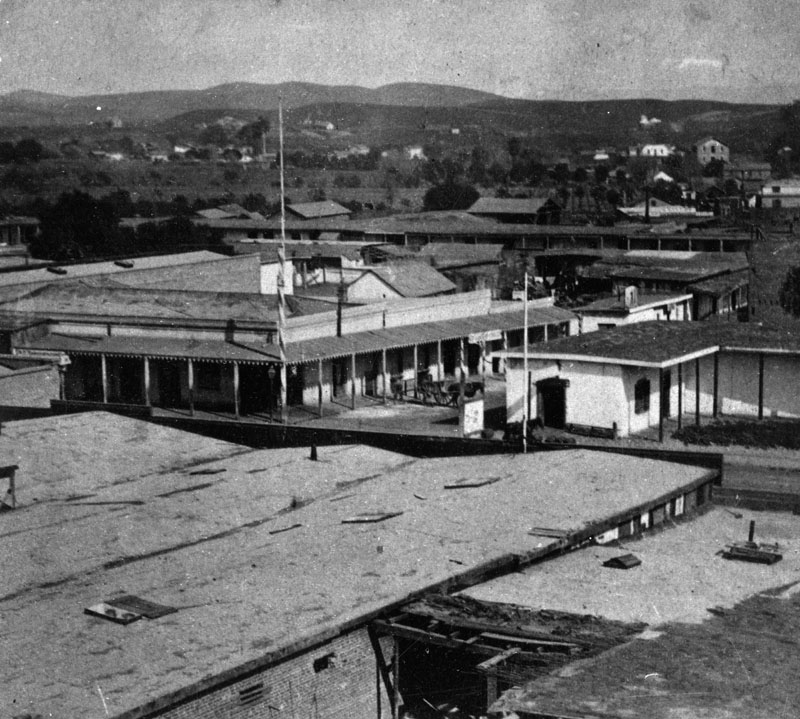 |
|
| (1871)* - View looking northeast at the intersection of North Main Street and Arcadia Street (previously Aliso Street). On the right (southeast corner) stands the residence of the wealthy merchant, trader, and government official, Don Abel Stearns. A number of low-lying adobe and brick buildings are seen in this panoramic view. |
Historical Notes The Abel Stearns residence was a virtual mansion at the time, with fourteen beautifully-decorated rooms. It was the social center of the pueblo. Later it became the site of the Baker Block.* In 1872, the section of Aliso Street between Main and Los Angeles streets was renamed Arcadia Street. |
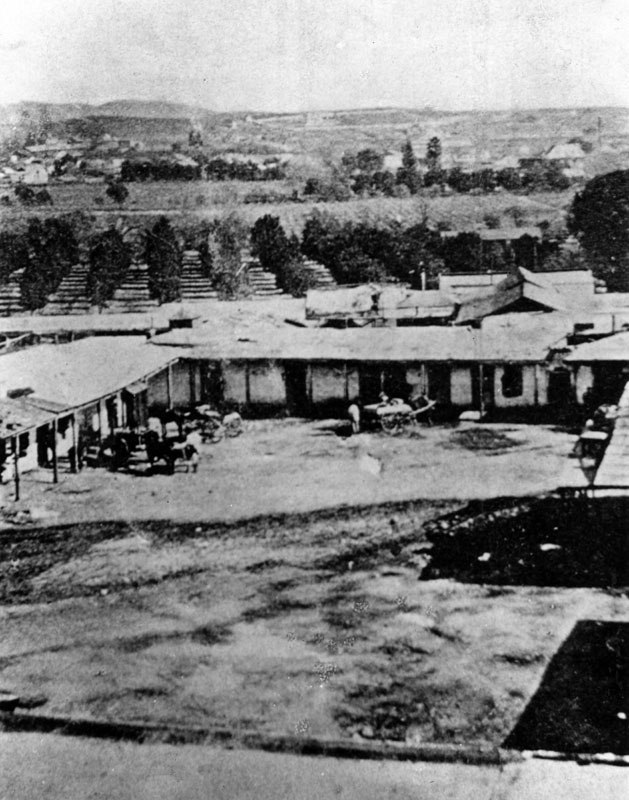 |
|
| (1875)* - View looking east at the Abel Stearns adobe, with an orchard directly behind it, located on the southeast corner of Main and Arcadia (formerly Aliso) streets. Note how the adobe has been expanded since 1857 as shown in the previous photos. |
Historical Notes In 1858, Abel Stearns constructed a two-story business block on Los Angeles Street nearby and called it Arcadia Block. It was named after an important person in his life - his wife. Arcadia Bandini, born in 1823, was the daughter of prominent ranchero Juan Bandini. She came to be regarded as one of the most beautiful belles of Los Angeles and was just 14 when she married 40-year-old Abel Stearns, who had come west from Massachusetts and acquired Southern California's largest land-cattle empire. Stearns built a home for his bride one block south of the Plaza--the community's central gathering area--and the house, called El Palacio (as seen above), became the social hot spot. In 1872, one year after his death, Arcadia Street was dedicated in honor of Stearn's wife, Arcadia.^*^ |
* * * * * |
LA Plaza and Early Water Reservoir
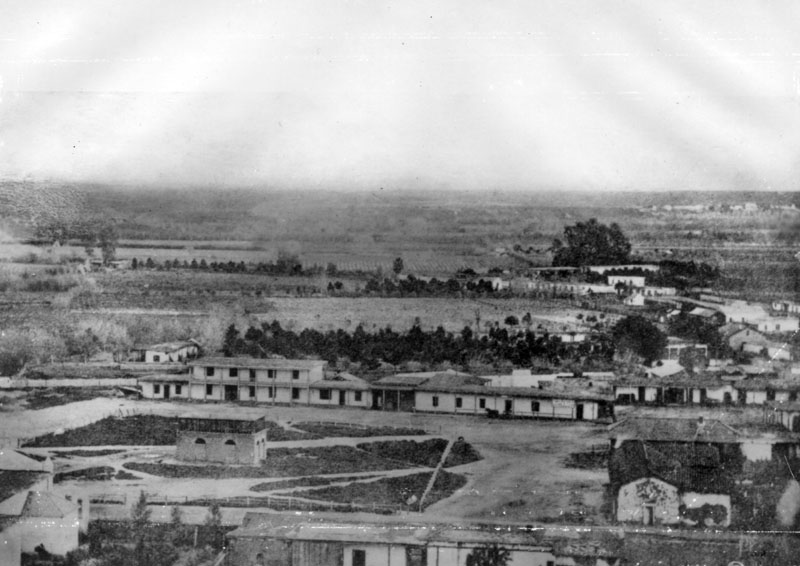 |
|
| (ca. 1858)** - This is the earliest known close-up photograph of the Los Angeles Plaza. There is a square main brick reservoir in the middle of the Plaza, which was the terminus of the town's historic lifeline: the Zanja Madre ('Mother Ditch'). The reservoir was built in 1858 by the LA Water Works Company. |
Historical Notes The site of the Plaza today is not the original location. It is the second, third, or maybe even the fourth. One of the earlier plots is believed to be around where the current Pershing Square sits. It’s also thought that at least one of the first three was washed away in a flood. The current Plaza dates from as early as 1815.^#^# When early settlers arrived at the Los Angeles River by way of Mission Road, they picked as a nearby gathering point a huge sycamore (upper right-center of photo) that gave them shelter and became a landmark, "El Aliso." That Spanish word for sycamore was later used to name the road carved out near the river (Aliso Street in 1854).^*^ |
.jpg) |
|
| (ca. 1860)* - One of Los Angeles' first water reservoirs was the brick structure shown in the center of the Plaza. The adobe directly behind was owned by Augustin Olvera. The 3-story building behind was the Sisters of Charity Hospital.* Click HERE to see more Early LA Water Reservoirs. |
Historical Notes In 1857, the city granted William Dryden a franchise to deliver water to homes through a system of wooden pipes beneath the streets. Dryden incorporates the Los Angeles Water Works Company and then erects a forty foot water wheel to lift water from the Los Angeles River to the city's main ditch, the Zanja Madre. He then constructed a large brick and wood storage tank (as seen above) in the center of the City Plaza to better manage the city’s water supply. Click HERE to see more in LA's Early Water Works System. |
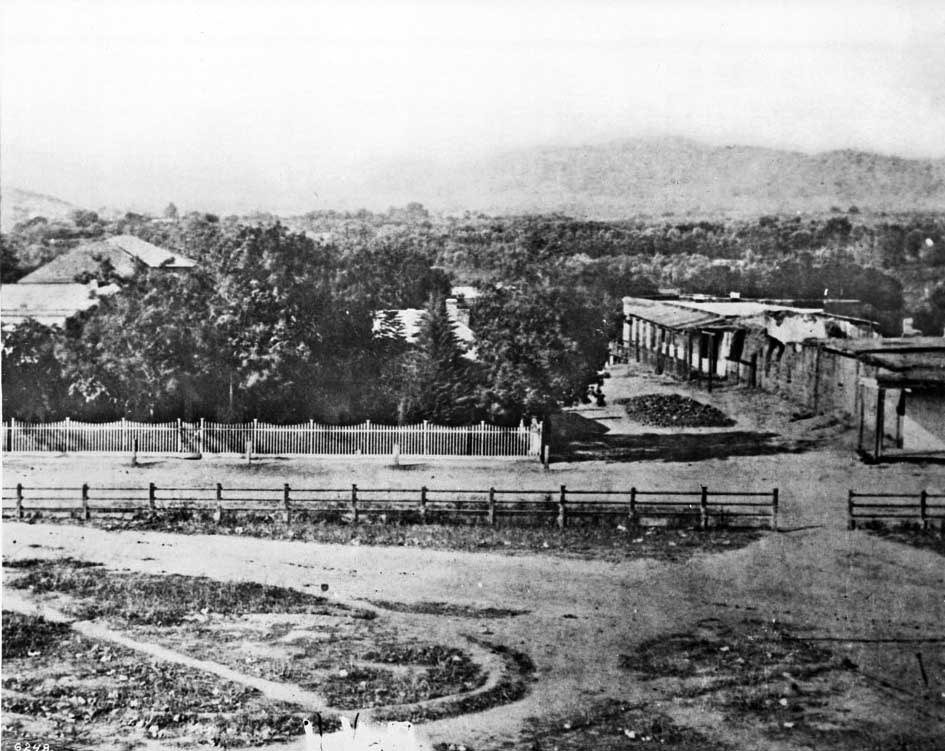 |
|
| (ca. 1869)^^* - Photograph of the Los Angeles Plaza and the entrance to Wine Street looking north from the Pico House. The Avila Adobe is visible on Wine Street (renamed Olvera Street in 1877). The Olvera Adobe can also be seen on the right. |
Historical Notes Don Francisco Avila, a wealthy cattle rancher and one-time Mayor of the pueblo of Los Angeles, built the Avila Adobe in 1818. The Avila Adobe, presently the oldest existing residence within the city limits, was one of the first town houses to share street frontage in the new Pueblo de Los Angeles.* |
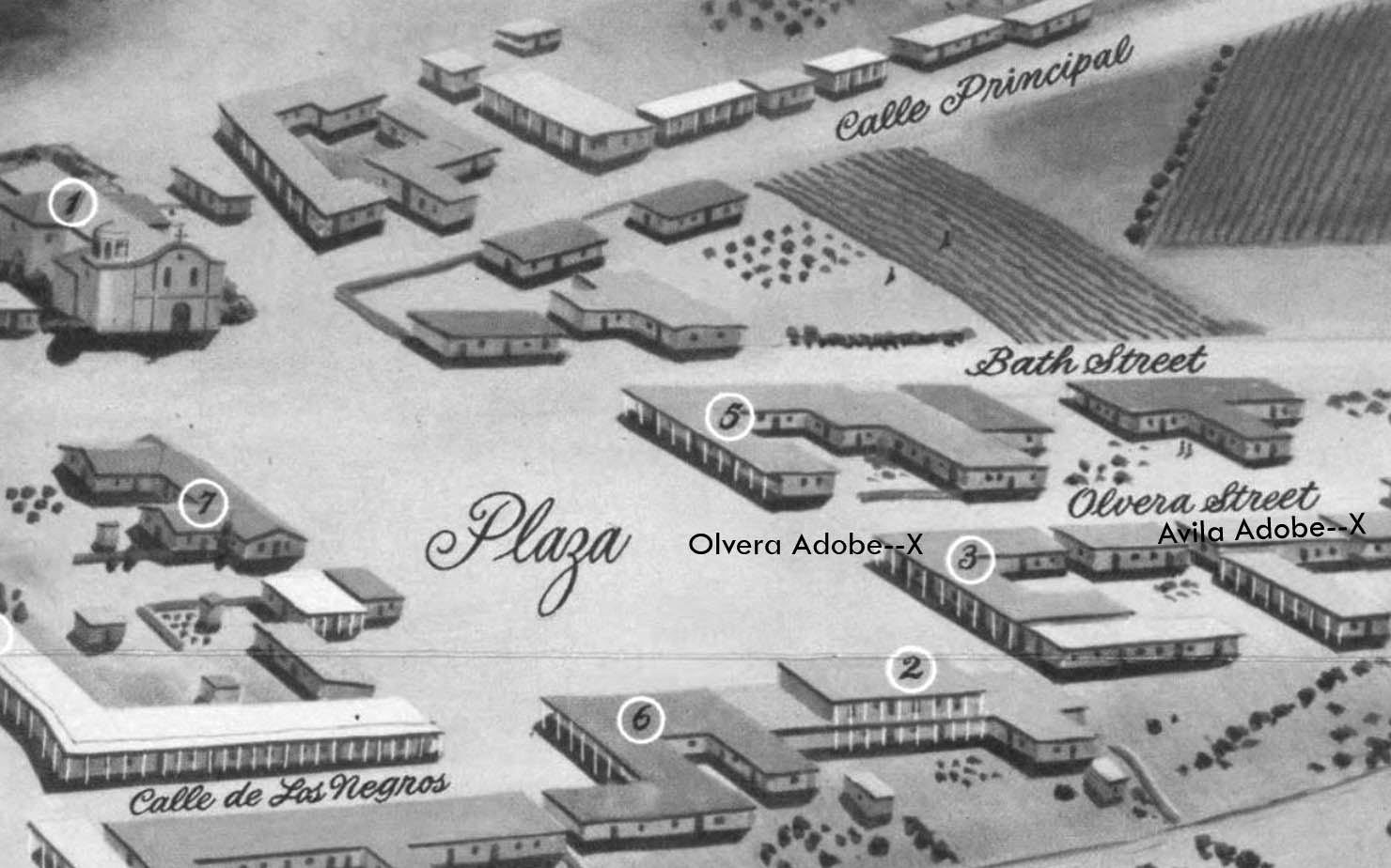 |
|
| (1850)^** - Map view looking northwest showing the LA Plaza and surrounding area as it appeared in 1850. To the right can be seen Olvera Street (Wine Street until 1877) at its intersection with the Plaza, with both the Olvera Adobe and Avila Adobe locations marked with an X. The Plaza Church is in the upper left corner. |
* * * * * |
Plaza Church (Mission Nuestra Senora de La Reina de Los Angeles)
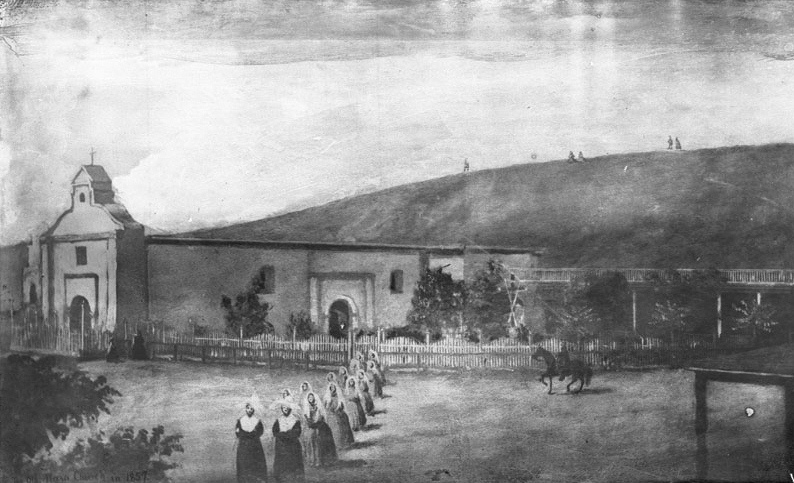 |
|
| (1857)^^* - Photograph of a drawing (by a young lady pupil of Sister's School) of the Los Angeles Plaza Church with a group of 14 nuns processing in the foreground. A wooden picket fence extends from the church at left to the right. A horseman prances nearby (at right). Two people stand near the church entrance (at left). A few other people are visible on the bare hilltop behind. Drawn in 1857. |
Historical Notes The 'Church of Los Angeles' was founded on August 18, 1814 by Franciscan Fray Luis Gil y Taboada. He placed the cornerstone for the new church in the adobe ruins of the original "sub-station mission" here, the Nuestra Señora Reina de los Ángeles Asistencia (founded 1784), thirty years after it was established to serve the settlement founding Los Angeles Pobladores (original settlers).*^ |
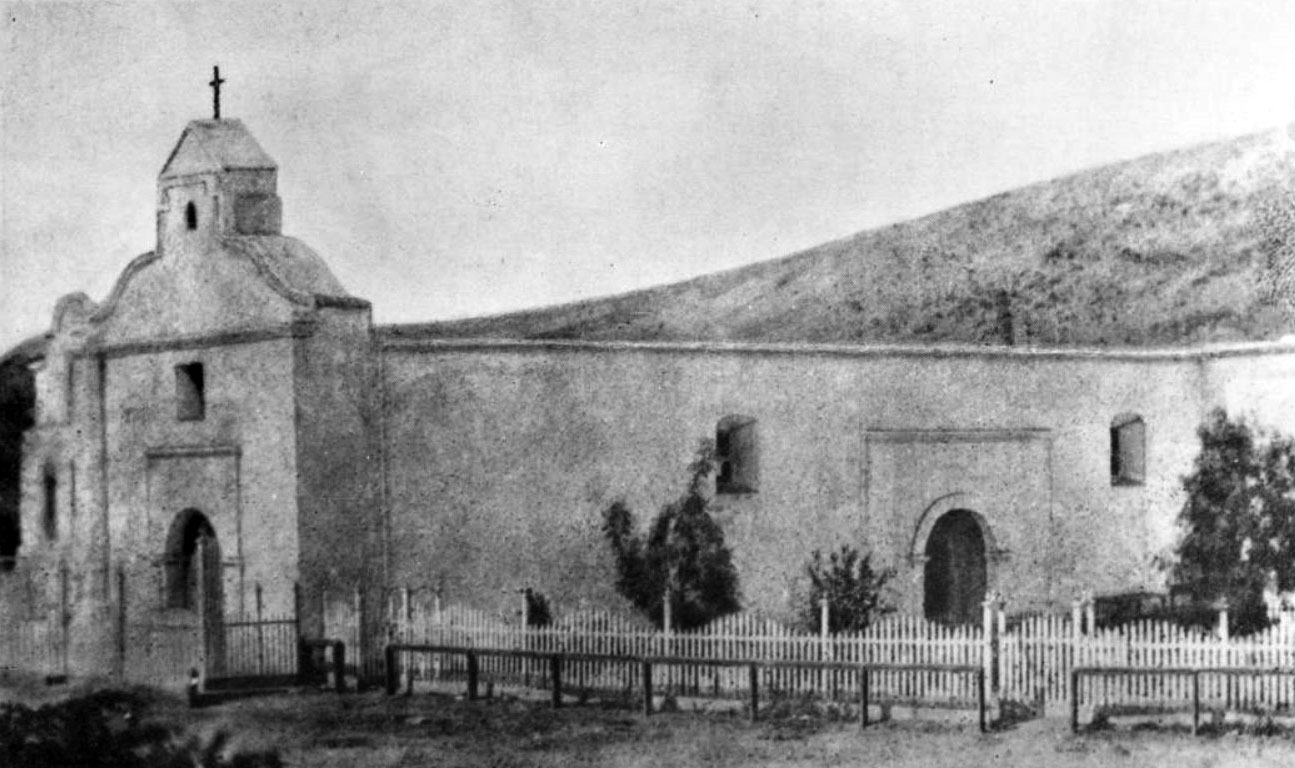 |
|
| (1860)^^ - Photograph of a lithograph from Benjamin Nayer's diary depicting the exterior of the Plaza Church in Los Angeles, 1860. |
Historical Notes The completed new structure was dedicated on December 8, 1822. A replacement chapel, named La Iglesia de Nuestra Señora de los Ángeles - for Mary, mother of Jesus or "The Church of Our Lady of the Angels" - was rebuilt using materials of the original church in 1861. The title Reina, meaning "Queen," was added later to the name. For years, the little chapel, which collected the nicknames "La Placita" and "Plaza Church," served as the sole Roman Catholic church in emerging immigrant Los Angeles.*^ |
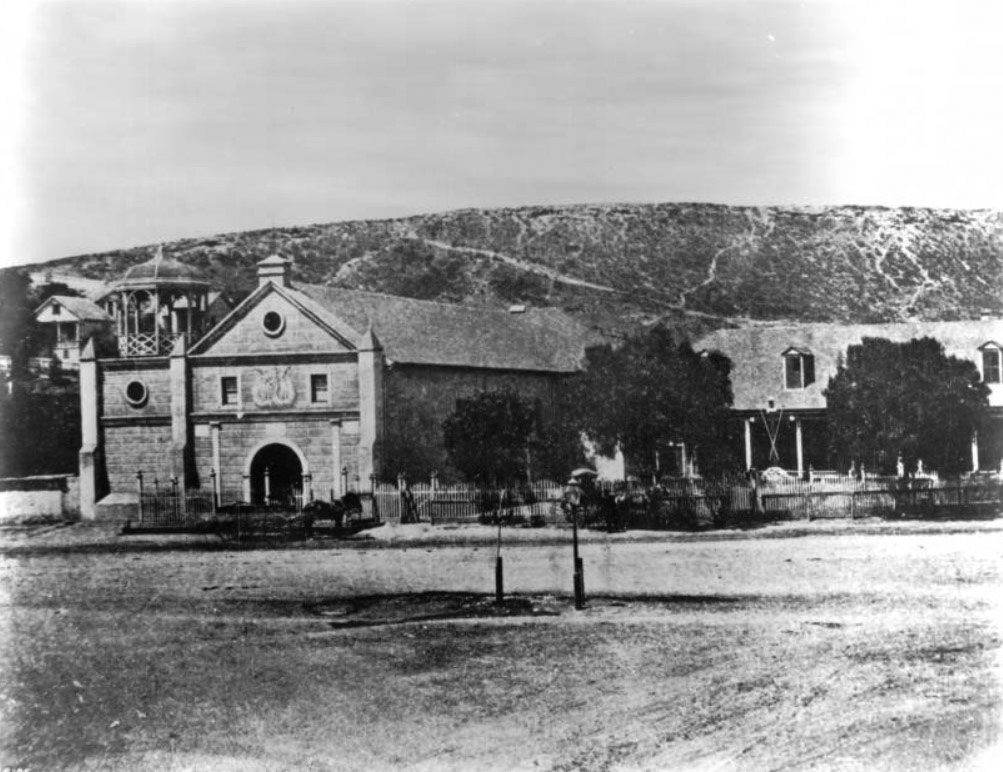 |
|
| (1870s)^^* - Exterior view of the Plaza Church or Mission Nuestra Senora de La Reina de Los Angeles. In front of the church is a fence that encloses the yard (at right). Three trees in the yard hinder the view of the building in the background. Two horse-drawn carriages are parked in front of the church and near the fence. |
Historical Notes The original 1822 -built "Church of Our Lady of the Angels" incoporated a three-bell campanario, or "bell wall" which was replaced by a gazebo-like structure (seen above) when the Church was rebuilt in 1861. The "bell wall" or "bell tower" would once again return when the Plaza Church was repaired/remodeled circa 1901.^* |
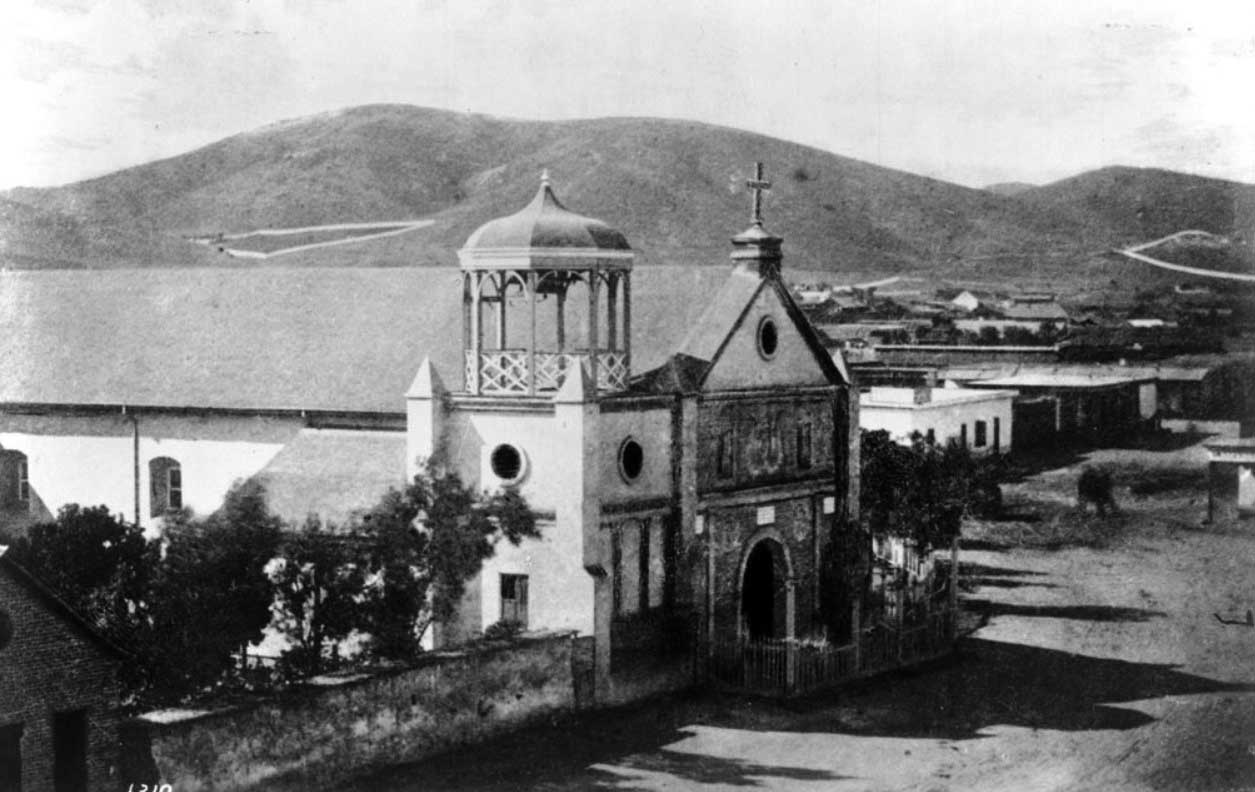 |
|
| (1870)^^* - View of the 'Old Plaza Church" with its gazebo-like roof structure. Note the bare hills in the background. Chavez Ravine, over the gazebo on the left, is where Dodger Stadium is today. |
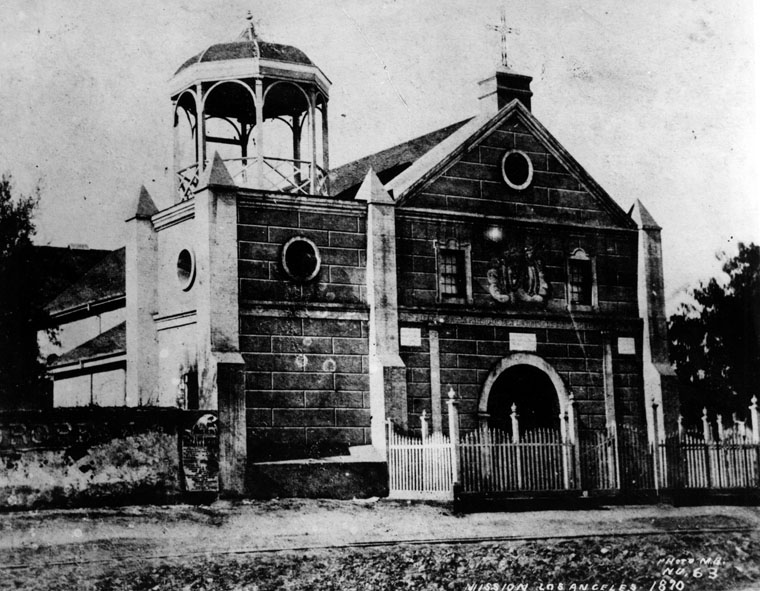 |
|
| (1870)* - Close-up view of the 'Old Plaza Church' (Mission Nuestra Senora Reina de Los Angeles) as it appeared in 1870. The three-story church features corner buttresses with spire-like tips. |
.jpg) |
|
| (ca. 1871)* - View across the Los Angeles Plaza where three people are seen posing for the photograph. The Plaza Church and the Cape House Restaurant are seen in the background. In the far background can be seen Fort Moore Hill. The Plaza was landscaped in 1871 and has served since that date as a public park. |
Historical Notes Fort Hill (also known as Fort Moore Hill) was a prominent hill overlooking the pueblo of Los Angeles. Its commanding view of the city made it a strategic location. Fort Moore was an historic U.S. Military Fort during the Mexican–American War. Its approximate location was at what is now the Hollywood Freeway near the intersection of North Hill Street and West Cesar Chavez Avenue, downtown. The hill on which it was built became known as Fort Moore Hill, most of which was removed in 1949 for construction of the freeway. The hill was located one block north of Temple Street and a short distance south of present day Cesar Chavez Avenue, between the Los Angeles Civic Center and Chinatown.^* |
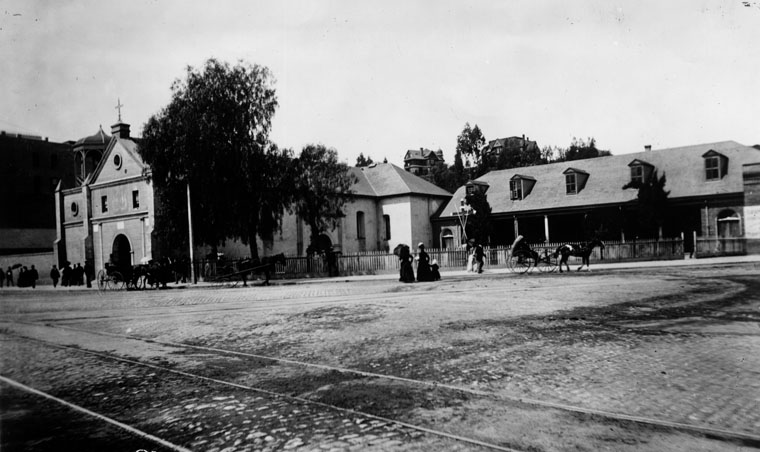 |
|
| (1885)* - Plaza Church and an adjoining building as they appeared in 1885. This was the parish church for Los Angeles and was never a mission. Streetcar tracks are seen in the foreground. |
.jpg) |
|
| (ca. 1885)^^* - Panoramic front view of the Los Angeles Plaza Church. There is an open octagonal cupola on the church roof to the left of the cross at the roof ridge. An adjacent building and large tree are behind a wooden picket fence. The street is cobbled with streetcar tracks. |
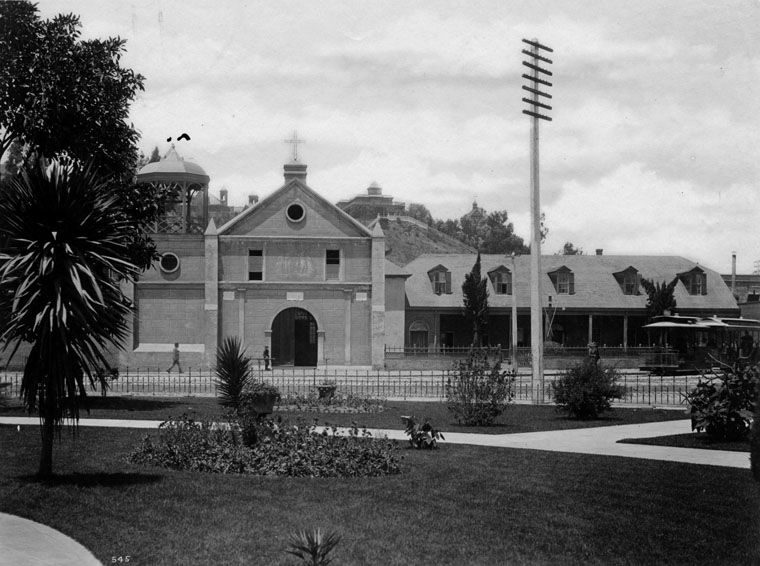 |
|
| (ca. 1887)* - Exterior view of Plaza Church seen from the plaza, across the street. A trolley can be seen on the right side of the photo. In the background can be seen the Banning House sitting on top of Fort Moore Hill. |
Historical Notes The Plaza Church or Mission Nuestra Señora Reina de los Angeles (Church of Our Lady the Queen of the Angels) was considered an asistencia ("sub-mission") of Mission San Gabriel Arcángel. Priests from Mission San Gabriel divided their time between the mission and the Asistencia site, but ultimately the installation was never granted mission status and the missionaries eventually abandoned the site. ^* |
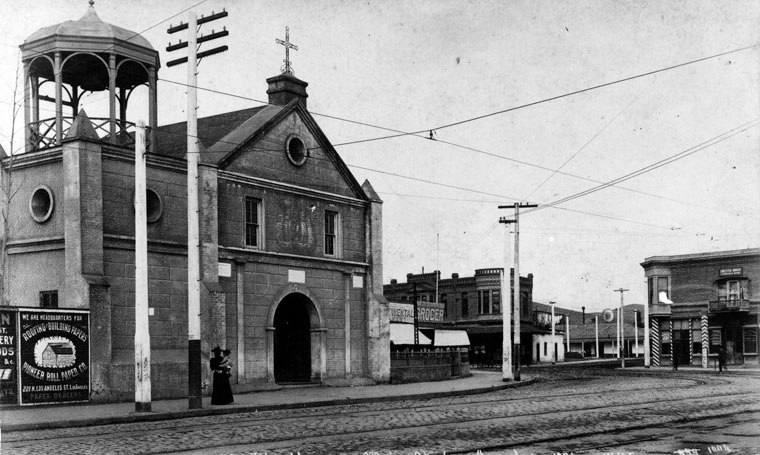 |
|
| (1894)* - Plaza Church as seen by looking north from Pico House on Main Street. This was the parish church for Los Angeles and was never a mission. A woman is seen holding a small child in front of the church. |
Historical Notes The surrounding area was named El Pueblo de Nuestra Señora la Reina de los Angeles del Río de Porciúncula ("The Town of Our Lady the Queen of the Angels on the River Porciúncula", which is the present-day City of Los Angeles). A chapel, La Iglesia de Nuestra Señora Reina de los Angeles, was later erected and dedicated on December 8, 1822, and for years served as the sole Roman Catholic church in the Pueblo. It is the oldest church in the city of Los Angeles.^* |
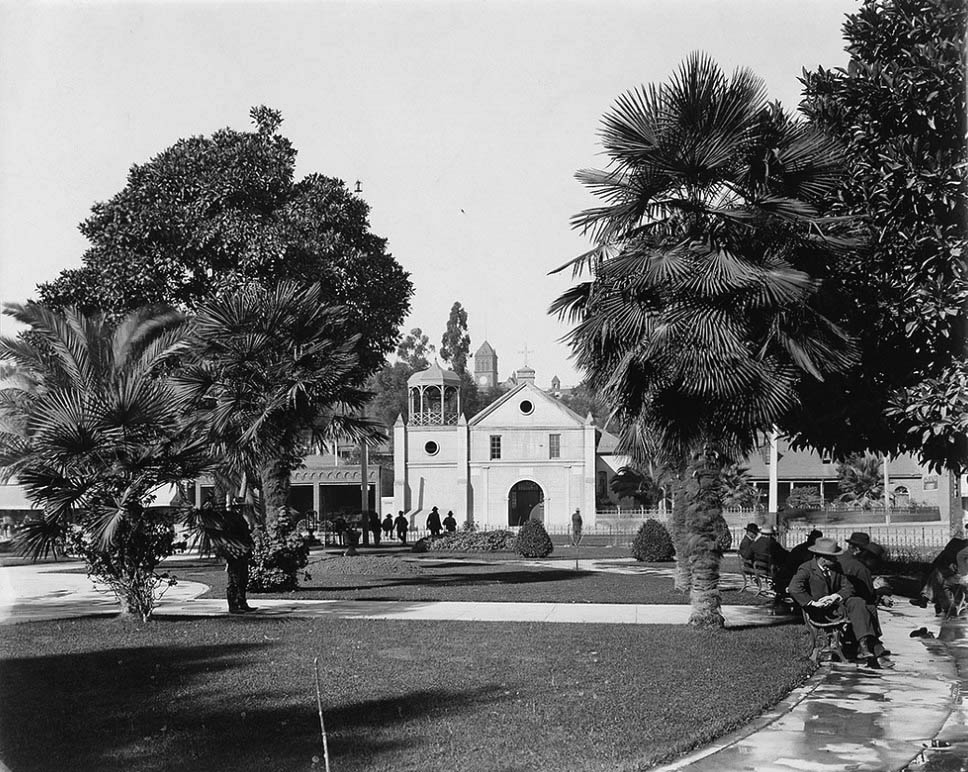 |
|
| (ca. 1900)#*^^ - View of the Old Mission Church from across the LA Plaza. Several men are seen relaxing on the Plaza's benches. In the background on top of Fort Moore Hill stands Los Angeles High School. |
Historical Notes The new Los Angeles High School (seen behind the Plaza Church) replaced the original one that was built in 1872, at the former site of Central School on what was then known as Poundcake Hill, at the southeast corner of Fort Street (later Broadway). This second location atop a hill was completed in 1891 and LAHS moved in. It was an enormous, for then, building. The new high school was built on part of the site of the abandoned Fort Moore Hill Cemetery, the first Protestant cemetery in Los Angeles, which was spread over the slopes of the hill. Early buildings commissioned to house the Los Angeles High School were among the architectural jewels of the city, and were strategically placed at the summit of a hill, the easier to be pointed to with pride. One of the school's long standing mottos is "Always a hill, always a tower, always a timepiece." ^* |
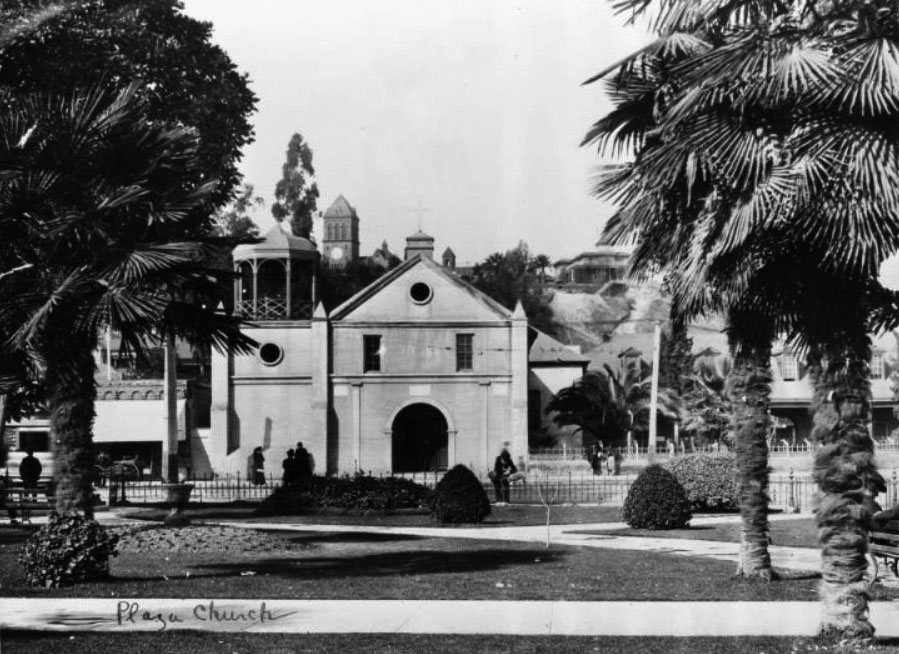 |
|
| (ca. 1900)^^* - Closer view of the Old Plaza Church as seen from the Los Angeles Plaza. The clock tower of Los Angeles High School can be seen in the background. |
Historical Notes This would be one of the last photos taken of the Plaza Church with its gazebo-like tower. It would soon be replaced with a "bell wall" similar to the one it had prior to 1861.^* |
 |
|
| (ca. 1901)^*# - Front view of the Old Mission Church with its newly installed "bell wall", similar to the one it had prior to 1861. There is a clear view of Los Angeles High School (2nd location, built in 1891) up on Fort Moore Hill and its relative relationship to the Plaza and the Plaza Church. |
Before and After
 |
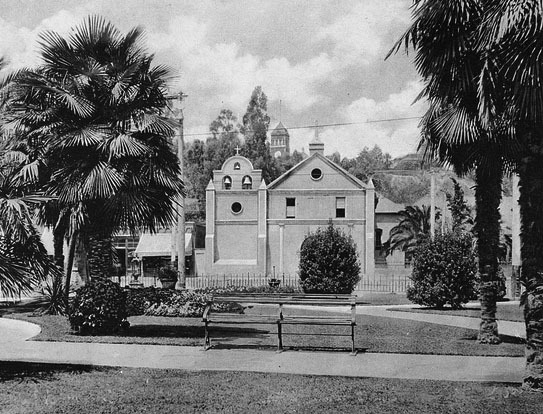 |
|
| (ca. 1900)^^* - Old Mission Church with "Gazebo Tower" |
(ca. 1901)^*# - Old Mission Church with "Bell Tower" |
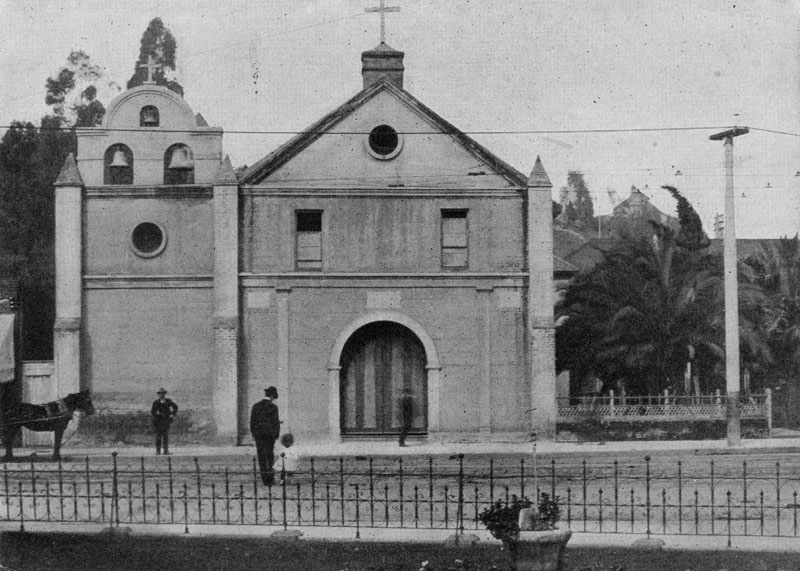 |
|
| (ca. 1901)* - View of the 'Old Plaza Mission' (Plaza Church) with its new 3-bell tower. A man and child can be seen crossing the street heading toward the church. |
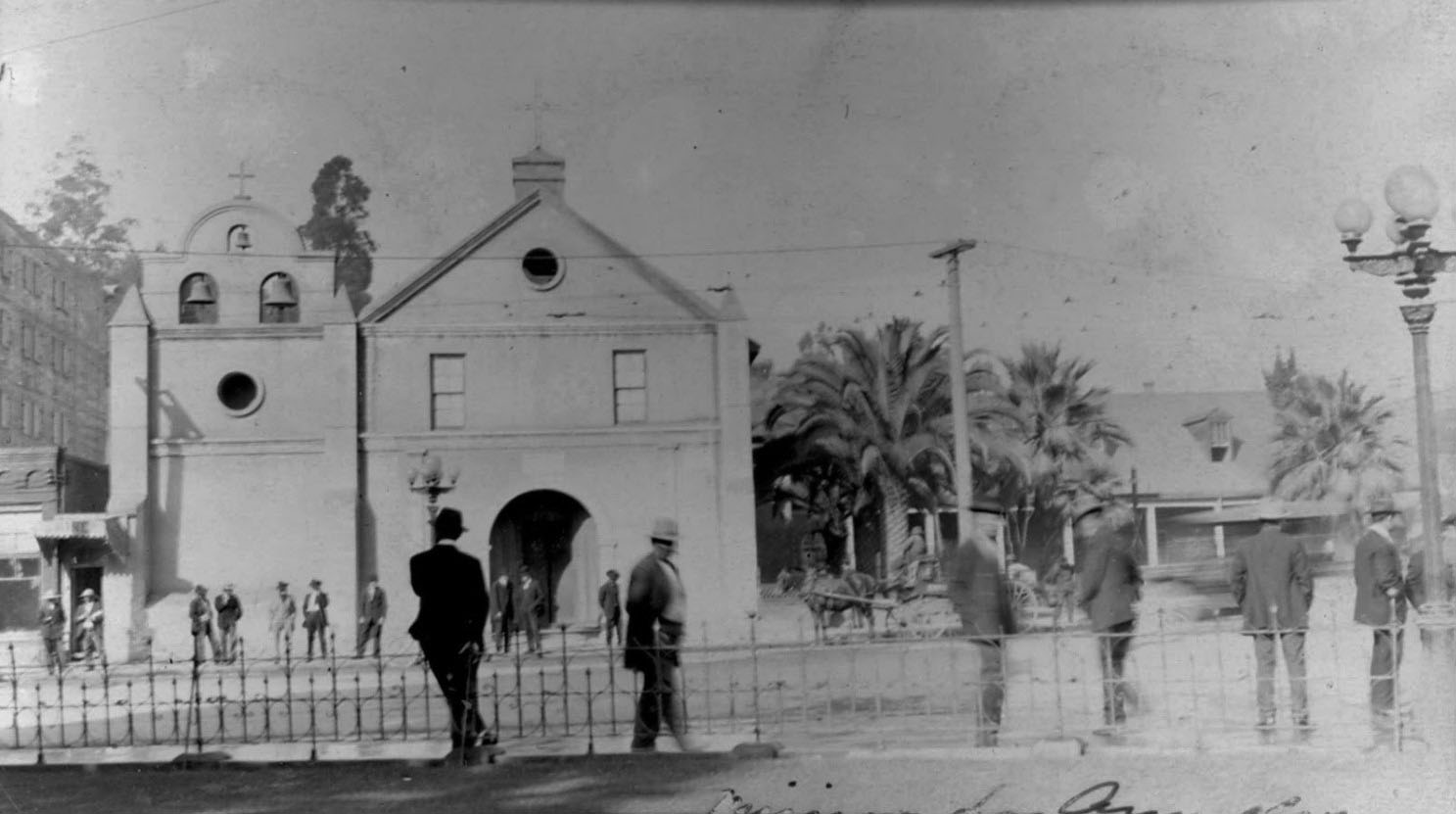 |
|
| (ca. 1902)^^# - View showing a group of well-dressed men standing on the edge of the LA Plaza and also across the street in front of the Old Plaza Church. There is a horse-drawn wagon parked by the curb near the church with a streetcar passing by. |
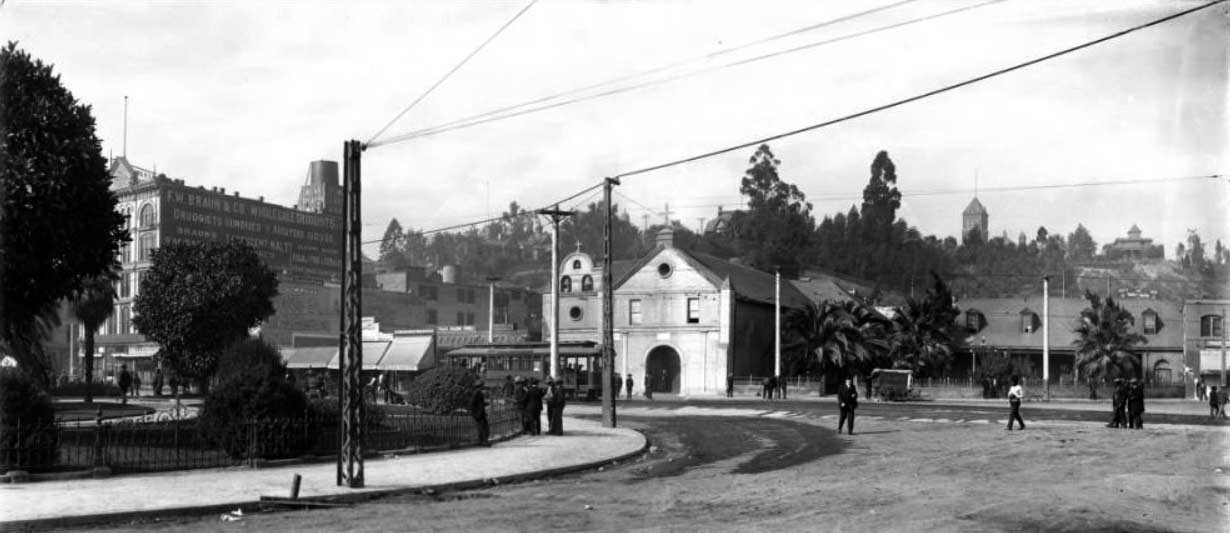 |
|
| (ca. 1905)^^* - Panoramic view of the Los Angeles Plaza, looking west. The F.W. Braun Building, Plaza Catholic Church, and shops along Main Street are visible in the background. Men are sitting, standing or moving about near the church, plaza and along Main Street. An electric streetcar is passing on Main Street carrying about a dozen passengers. Rocks and other forms of debris litter the dirt road. Utility lines and utility poles run along the streets. |
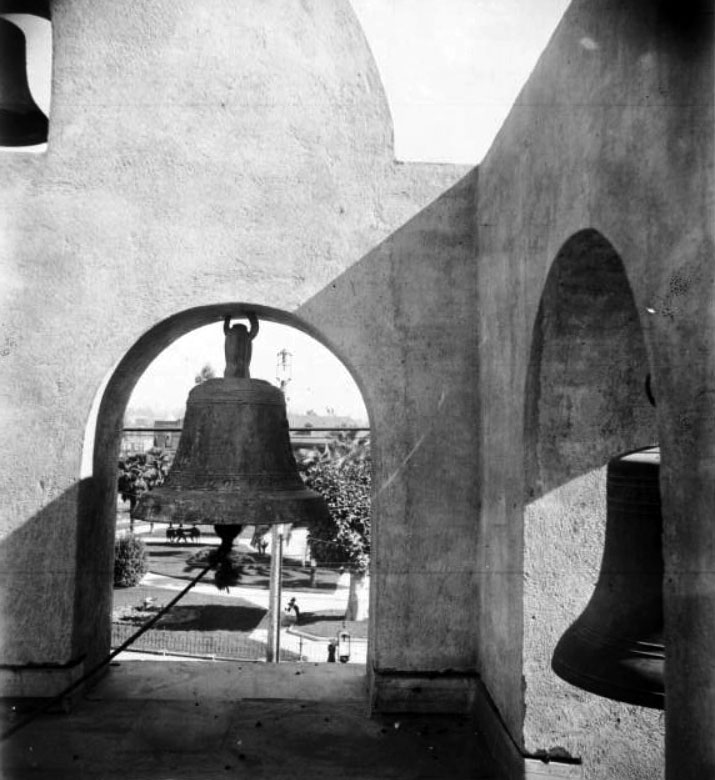 |
|
| (ca. 1910)^^* - View of the bells in the Los Angeles Plaza Church tower. Through one of the tower openings can be seen sidewalks, trees and people in the Plaza. |
Historical Notes The Plaza Church bells were cast by Paul Revere's apprentice George Holbrook. The bells bear inscriptions that read: "Across the street from the Plaza and to the west is the Old Plaza Church (535 Main St.), first established in 1784 as a chapel. The oldest religious structure in Los Angeles, this 1822 building is also known as the Church of Our Lady the Queen of the Angels. Originally built as a simple adobe by Franciscan Padres with the labor of local Native American Indians, it took an additional 40 years to construct the whole church. This Catholic Church now features some fine modern additions, including a tile mosaic of The Annunciation, created by artist Isabel Piczek in 1981. The interior displays ornate designs of wrought iron and gold leaf. A collection of religious canvases adorn the alter, and murals grace the ceilings. Today, Our Lady Queen of Angels serves as an active church of the Archdiocese of Los Angeles." ^^* |
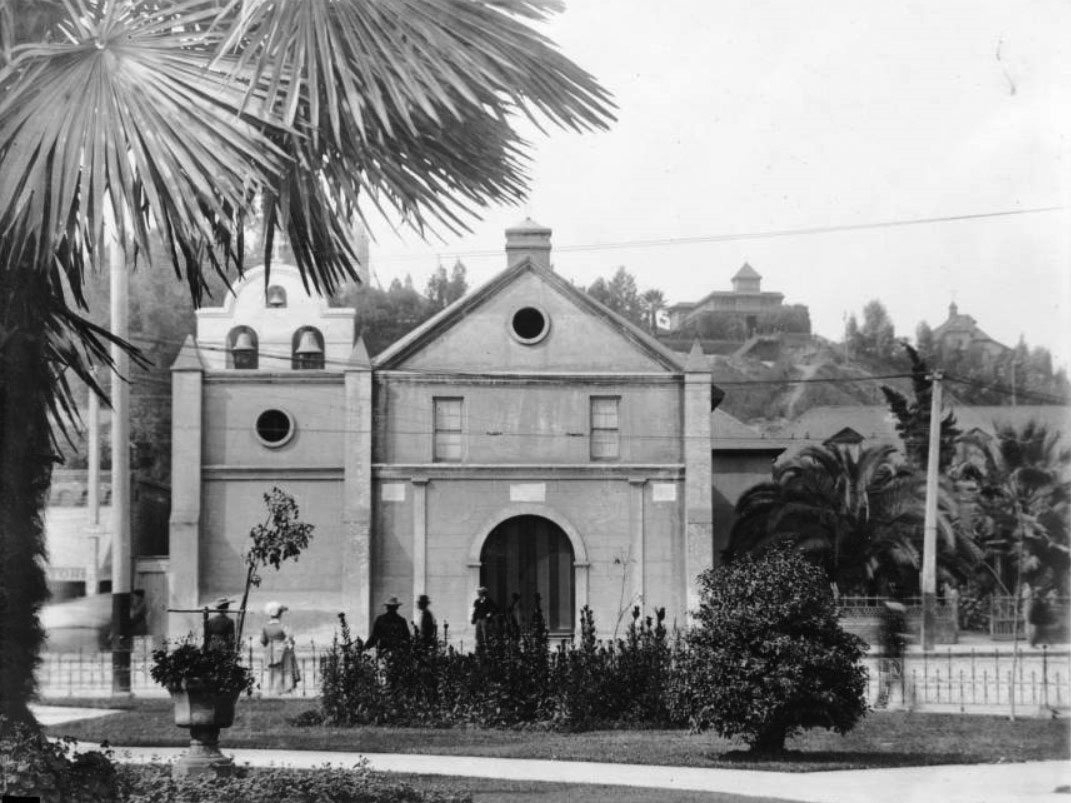 |
|
| (ca. 1915)^^* - View of the Old Plaza Church, showing what appears to be a new bell tower. Four churchgoers are seen behind a wrought-iron fence in front of the chapel. In the background on top of Fort Moore Hill can be seen the Banning House. |
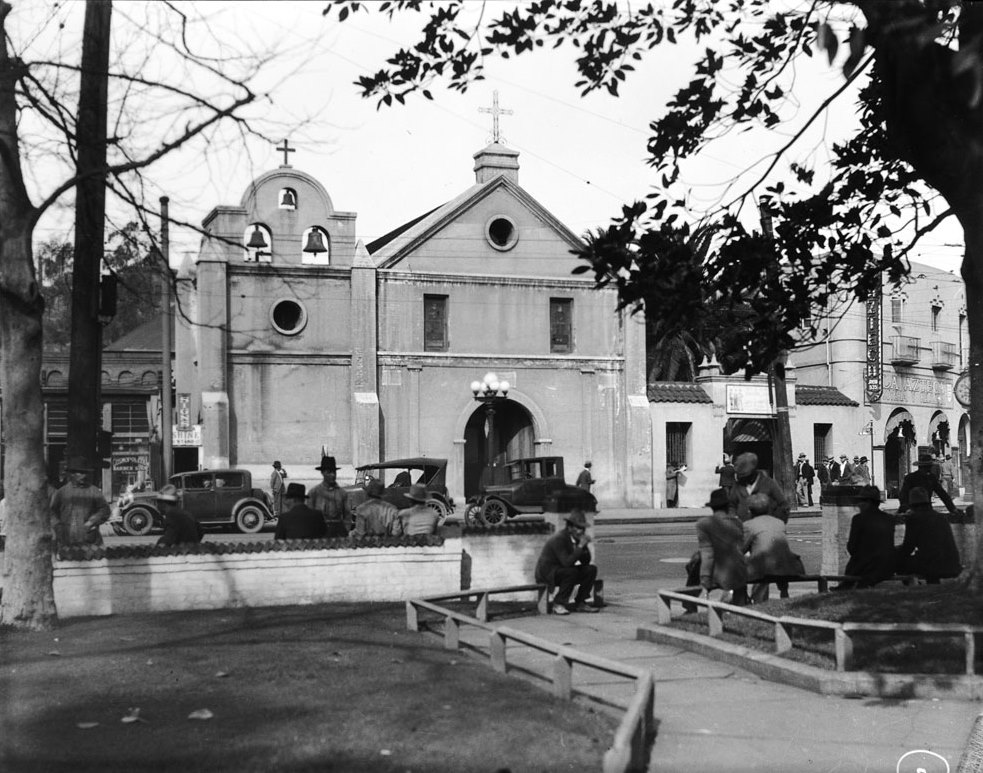 |
|
| (ca. 1920s)^^* - View of the front of the Old Plaza Church as seen from the L.A. Plaza across the street. Early model cars are seen parked in front of the church. |
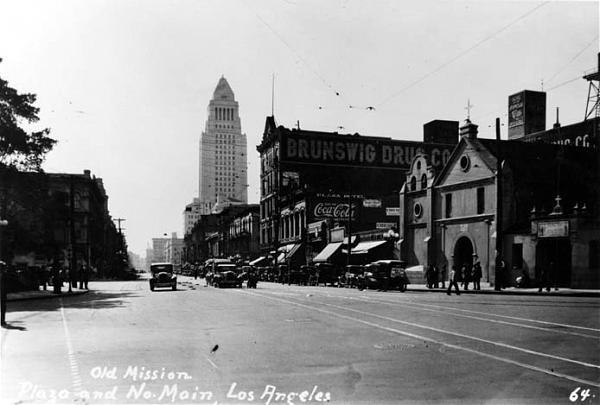 |
|
| (ca. 1928)^* - View looking south on Main Street showing the newly constructed City Hall standing in the background (corner of Temple and Main streets) with the Brunswig Building and Old Plaza Church at right. |
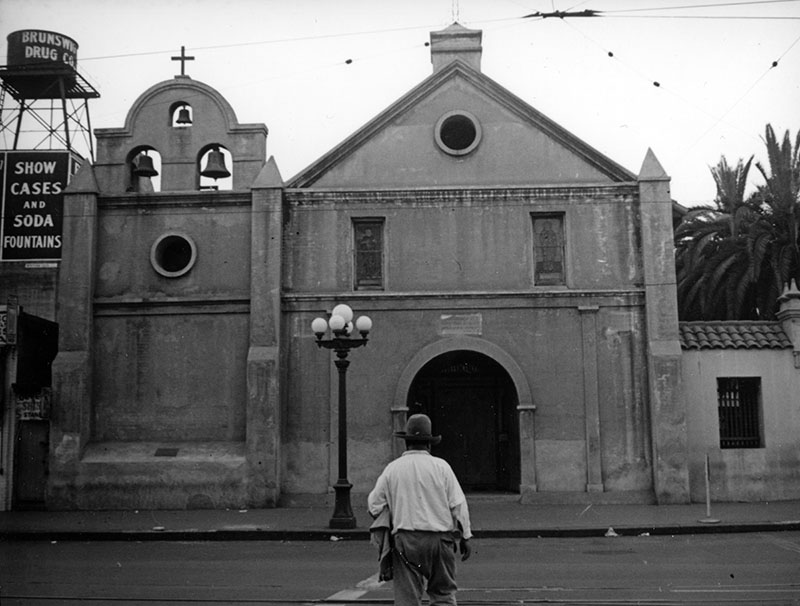 |
|
| (ca. 1937)** - A man is crossing Main Street directly outside of La Plaza Church. Signage on a water tower (upper left) promotes the nearby "Brunswig Drug Co." Photo by Herman J. Schultheis |
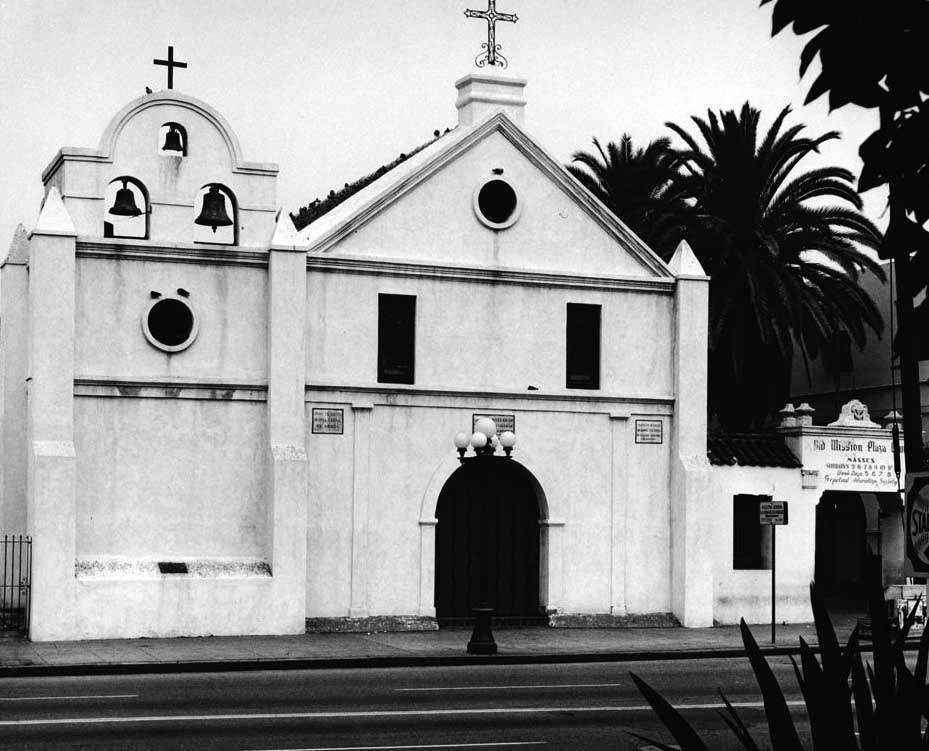 |
|
| (1970s)^^* - View showing the Old Plaza Church as it appeared in the 1970s. |
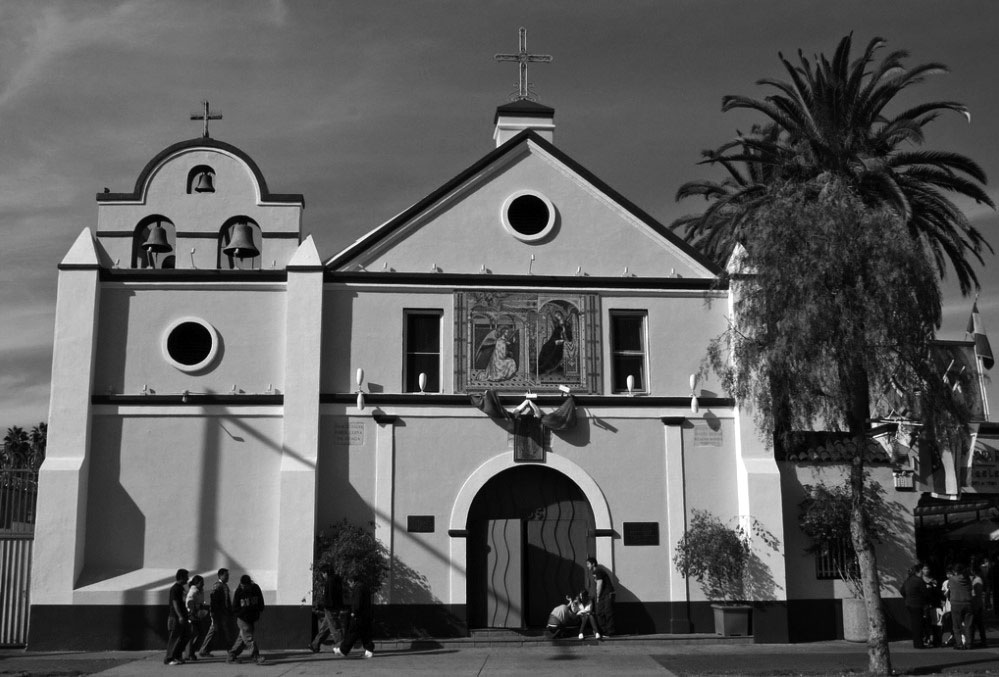 |
|
| (2008)++# – View of the Old Plaza Church as it appears today. |
Historical Notes The 'Old Plaza Church' was one of the first three sites designated as Historic Cultural Monuments by the City of Los Angeles, and has also been designated as a California Historical Landmark No. 144.^* Click HERE to see the complete listing of California Historical Landmarks in L. A. |
Click HERE to see more in Early Views of the LA Plaza |
* * * * * |
Bella Union Hotel (later Clarendon and then St. Charles Hotel)
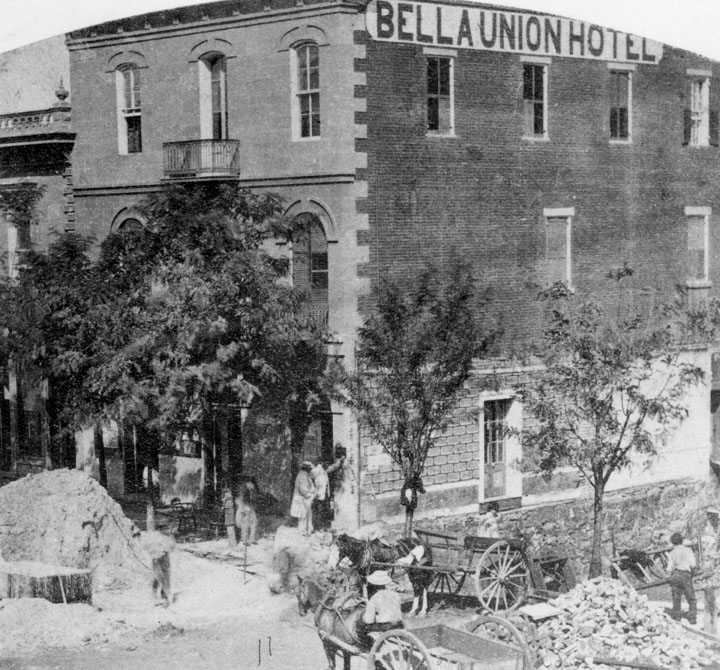 |
|
| (1865)* - The Bella Union Hotel which later became the St. Charles. This is a view of two sides of the hotel in which the front is mostly obscured by trees. Mounds of dirt and debris from construction lie in front and to the side of the building. |
Historical Notes The Bella Union Hotel was considered the first hotel in Los Angeles. It became the Clarenden in 1873 and the St. Charles in 1875. Constructed in 1835 as the home of Isaac Williams, a New England merchant who moved to Los Angeles three years earlier, the one story adobe became the last capitol of Alta California during the Mexican era when Governor Pio Pico purchased it for his office. After the conquest of Los Angeles by American forces in 1847, the building was used by Lt. Archibald Gillespie, who commanded the occupying forces. Later it housed American troops, and after they left, it became a saloon. By early 1850, the building was operating as the Bella Union Hotel. Later that year, it became the county's first courthouse and beginning in 1858, it was the region's transportation hub. The Overland Mail Company operated by John Butterfield (the founder of American Express) rented space for a station until it built new quarters in 1860 at Second and Spring--the present location of Mirror Building. The Wells, Fargo and Company also had their office here and Phineas Banning operated coaches to Wilmington and San Bernardino from the hotel. ##^* |
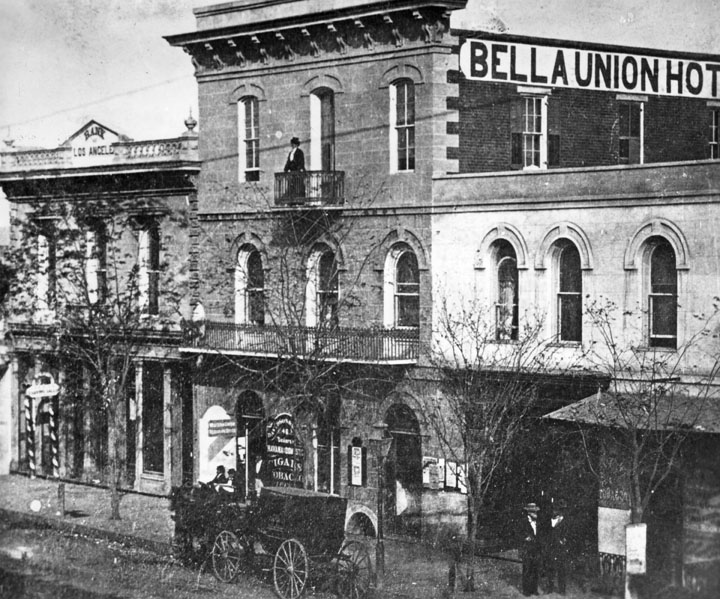 |
|
| (ca. 1867)* - The Bella Union at 314 N. Main St. later became the St. Charles Hotel. To the left is the original home of Farmers and Merchants Bank, later merged into Security Pacific Bank. Standing on the balcony is Mrs. Margarita Bandini Winston. |
Historical Notes Dr. J.B. Winston was one of the owners of the Bella Union Hotel. His wife, Mrs. Margarita Bandini Winston (seen on the balcony), was the sister of Arcadia Bandini Baker. #* |
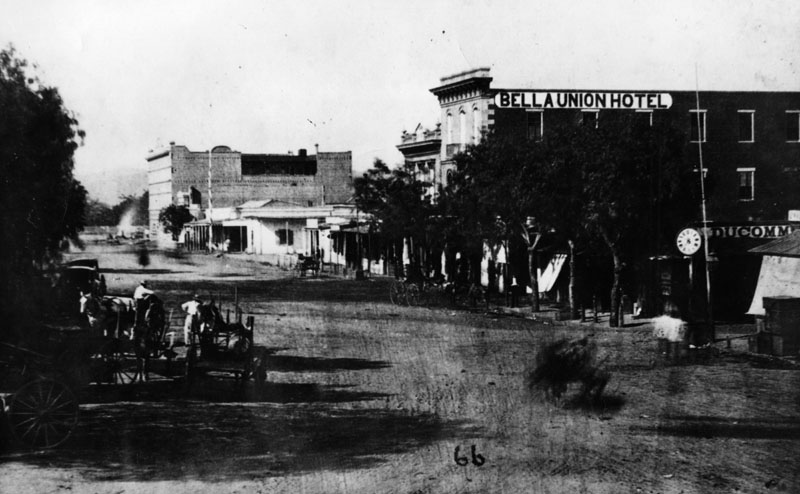 |
|
| (ca. 1870)* - View of North Main Street taken after erecting Pico House, but before completion of Merced Theater. The Bella Union Hotel can be seen at right-center of photo. |
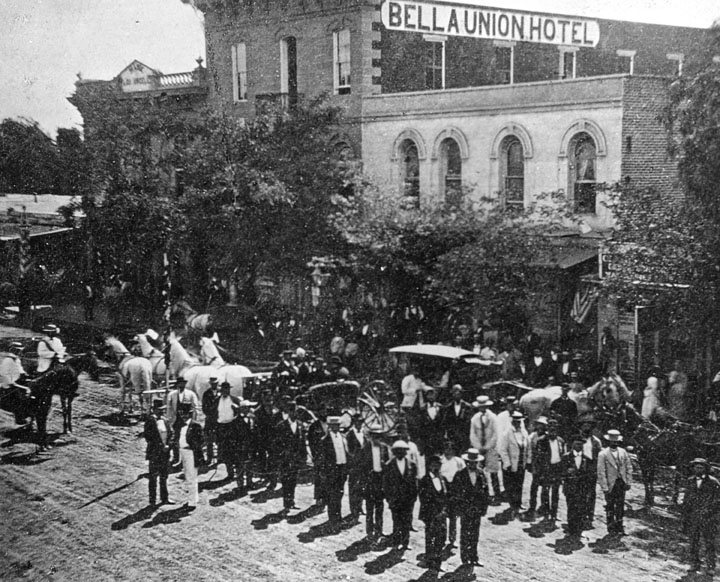 |
|
| (1871)* - A 4th of July parade on North Main Street of the Veterans of the War of 1812. Men are seen in two lines standing in the street, horses and carriages waiting and people on the sidelines. The Bella Union Hotel in the background is partially obscured by trees. |
Historical Notes The area in front of the the Bella Union Hotel was long used as a social and political center.* |
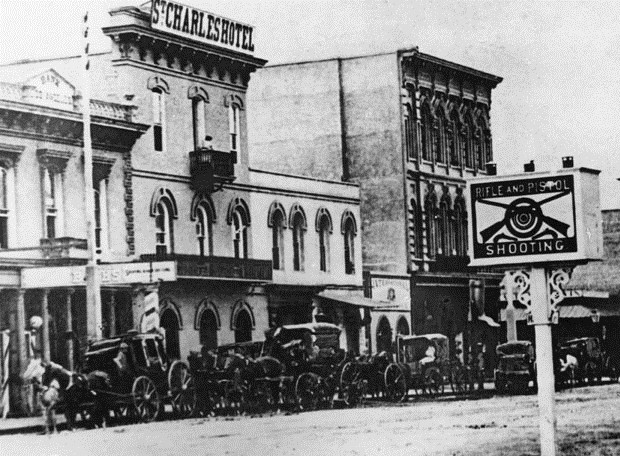 |
|
| (ca. 1875)* - Exterior view of the St. Charles Hotel, originally the Bella Union Hotel. Horses and buggies are lined up along the street. In the foreground a sign reads, “Rifle and Pistol Shooting,” a reminder that Los Angeles was a Western frontier town. |
Historical Notes The Bella Union Hotel became the Clarenden in 1873 and the St. Charles in 1875. |
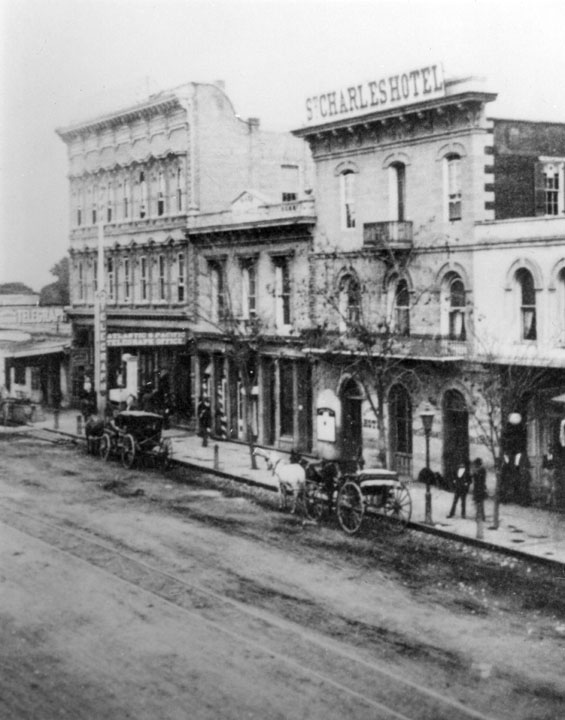 |
|
| (1880)* - View showing the St. Charles Hotel, originally the Bella Union Hotel. To the left (north) stands the Farmers and Merchants Bank (previously the Pico Building). Further north is the 3-story Grand Central Hotel, built in 1876. |
Historical Notes Located on the east side of the historic 300 block of North Main Street, the Bella Union Hotel building lasted until the 1940s when the entire block was demolished to make way for the extension of Aliso Street. Today, the Hollywood Freeway (Route 101) runs under where LA's first hotel once stood. The Bella Union Hotel (Claredon/St. Charles) site was designated as California Historical Landmark No. 656. |
Click HERE to see more in Early Views of the Historic 300 Block of N. Main Street |
* * * * * |
Lafayette Hotel (later Cosmopolitan and St. Elmo)
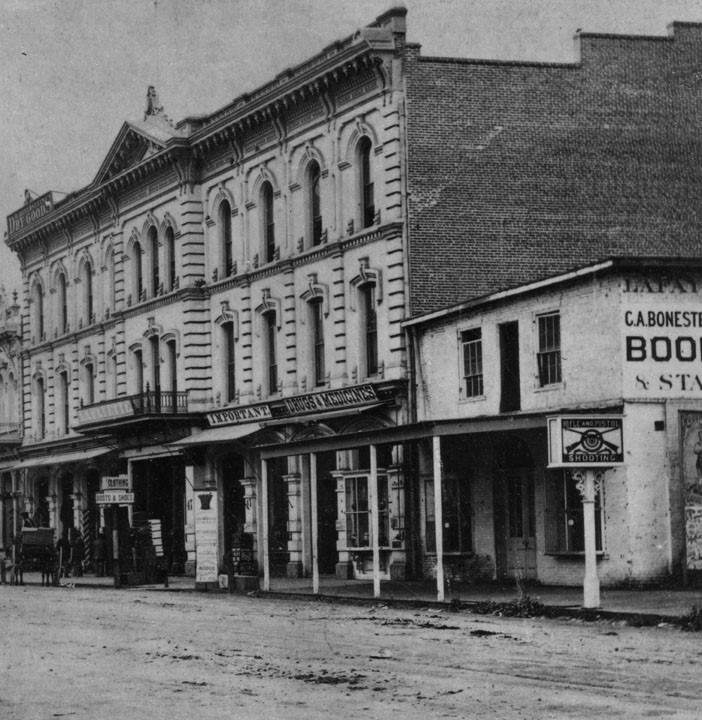 |
|
| (ca. 1870s)* - View of the La Fayette Hotel, located on the west side of Main Street opposite of the St. Charles Hotel. The same "Rifle and Pistol Shooting" sign can be seen here but from a different angle. |
Historical Notes The Lafayette Hotel was built sometime in the early 1850s. The second city hotel after the Bella Union (the U.S. Hotel was the third), it was renamed the Cosmopolitan Hotel and then became the St. Elmo. The Lafayette was located on Main Street near Temple, and in the 1870s was known as the best hotel in Los Angeles.*#* |
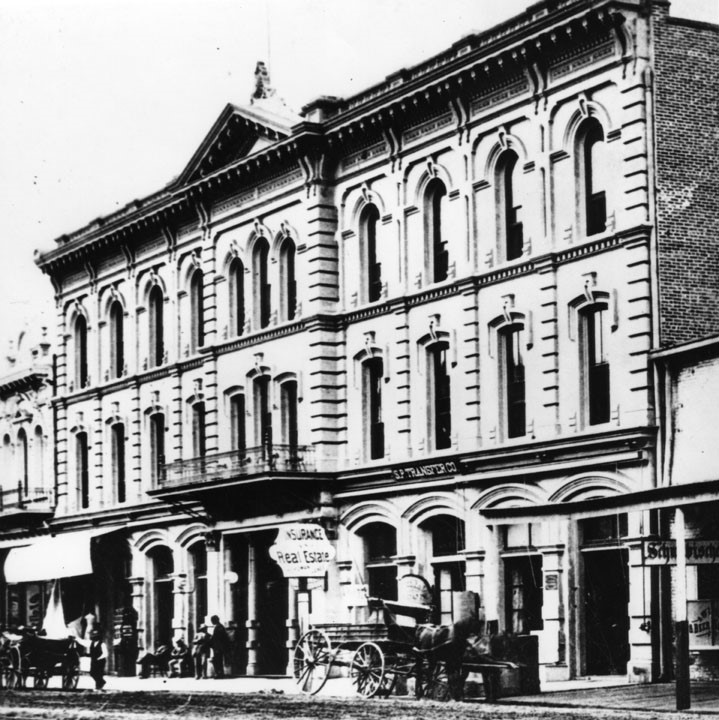 |
|
| (ca. 1880)* - Closer view of the La Fayette Hotel. Several men sit and stand in front of the hotel entry way. The street is unpaved and two horses and carriages are seen in front of the building, one near the "Insurance and Real Estate" sign. |
Historical Notes The Lafayette Hotel became the "Cosmopolitan" circa 1882.* |
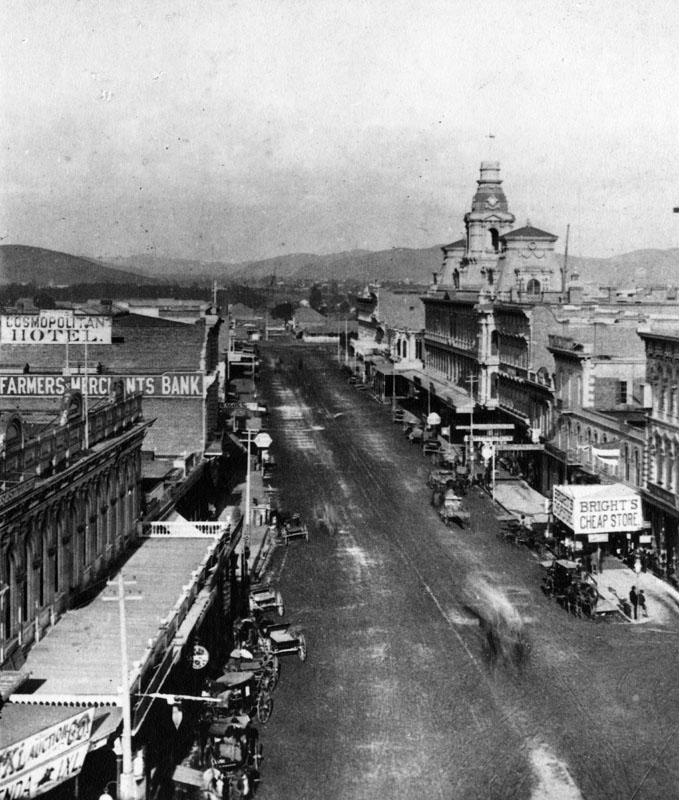 |
|
| (1882)* - View looing north on Main Street, with the Downey Block on the left, followed by the second location of the Farmers and Merchants Bank from June 15, 1874, to October 29, 1883, followed by the Cosmopolitan (previously Lafayette) Hotel. On the right is the Ducommun Building, Bella Union-Clarendon-St. Charles Hotel, Pico Building (the first home of Farmer's and Merchants Bank), the Grand Central Hotel, and the Baker Block (with towers). |
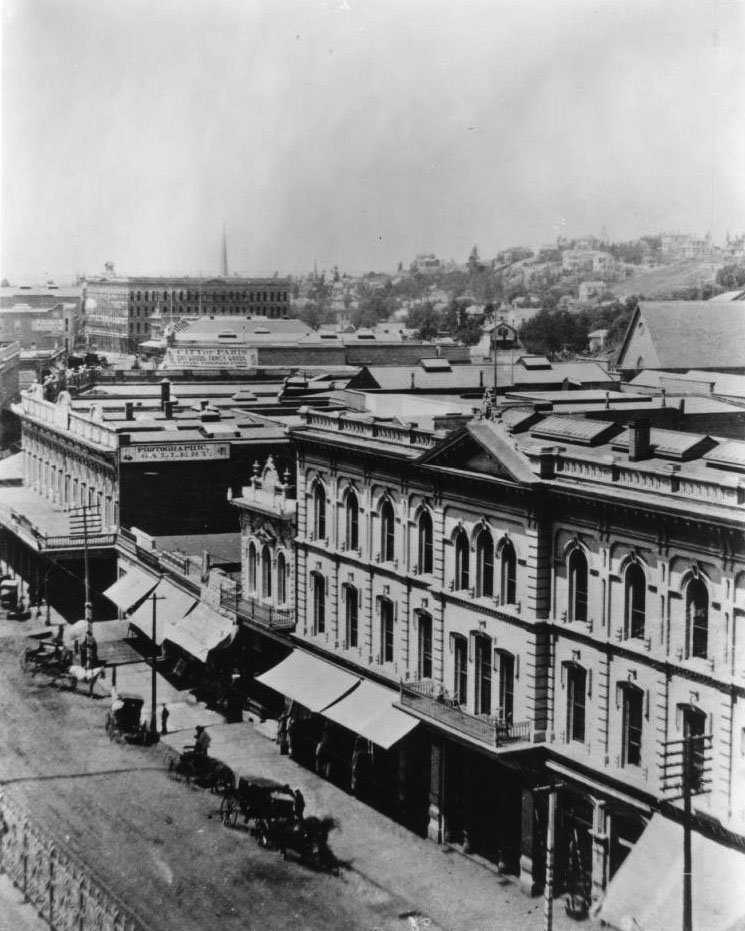 |
|
| (ca. 1888)^^* - View looking northeast showing the west side of Main Street. The Cosmopolitan Hotel (formerly the Lafayette Hotel; subsequently the St. Elmo Hotel) can be seen in the lower right corner. The Downey Block, on the northwest corner of Main and Temple streets, is seen at center-left. There are several horse-drawn vehicles parked on the street in front of the buildings. |
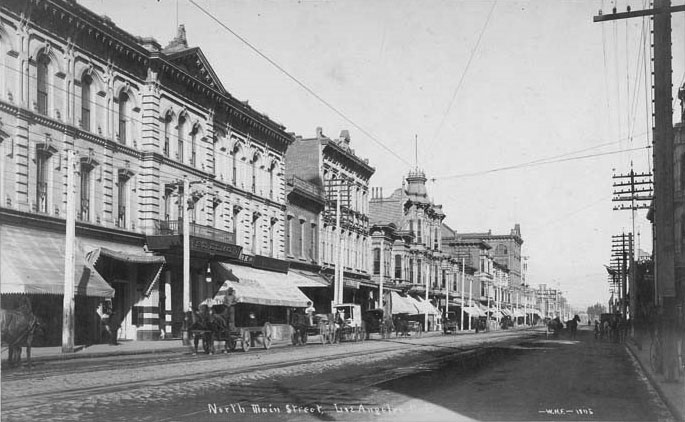 |
|
| (ca. 1890)^## – View looking north on Main Street showing the Cosmopolitan Hotel at left. |
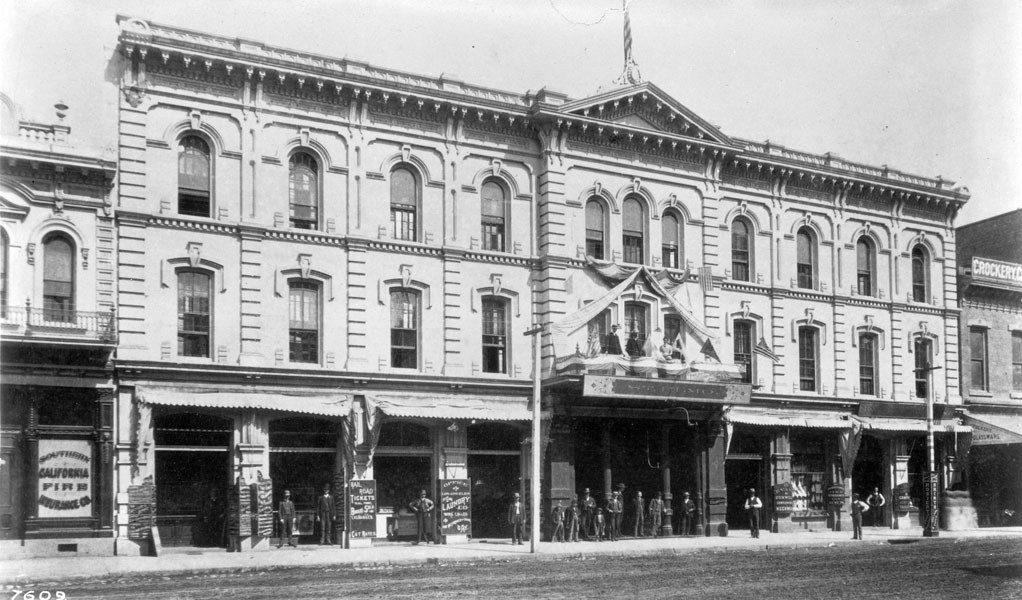 |
|
| (ca. 1890)^^* - View showing the front of the Cosmopolitan Hotel on Main Street. Note that the people standing on the sidewalk and front balcony appear to be posing for the photographer. |
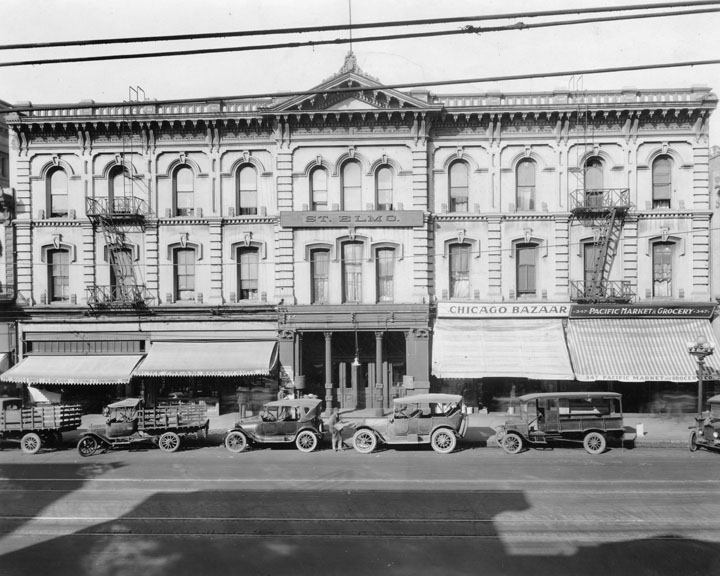 |
|
| (1920)* - View showing the St. Elmo Hotel (formerly the LaFayette and Cosmopolitan). Here the hotel is viewed from across the street, with a line of cars parked at the curb in front of the various ground floor businesses. |
* * * * * |
Wilmington Exchange Building
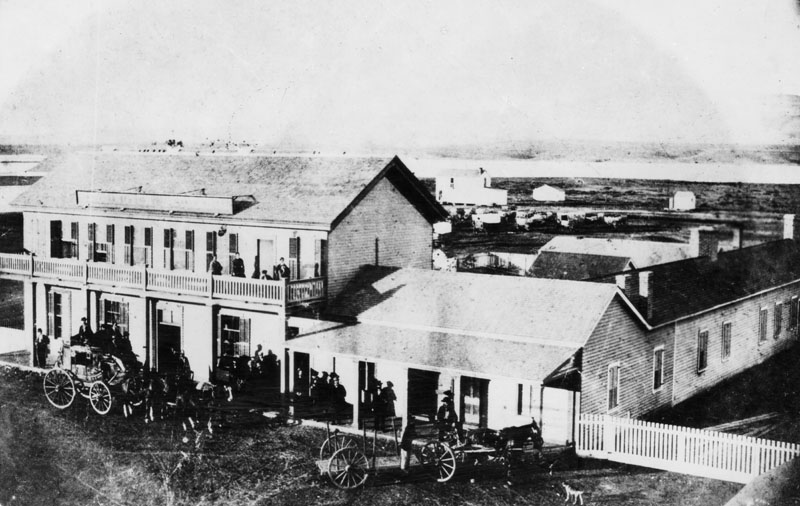 |
|
| (ca. 1865)* - View of the Wilmington Exchange building, hotel and stage station to Los Angeles before the railroad on Canal Street (now Avalon Boulevard). In the front of the hotel is a 4-horse stagecoach with passengers. |
Historical Notes In 1863, the Wilmington Exchange Hotel was built and was the first hotel in Wilmington. Phineas Banning’s first Wilmington home was the single-story building attached to the hotel (as seen above).^**^ Banning also owned a stagecoach line with routes connecting San Pedro to Salt Lake City, Utah and to Yuma, Arizona, and in 1868 he built a railroad to connect San Pedro Bay to Los Angeles, the first in the area.^* |
Click HERE to see more in Early Views of San Pedro and Wilmington |
* * * * * |
Workman Brothers Saddlery
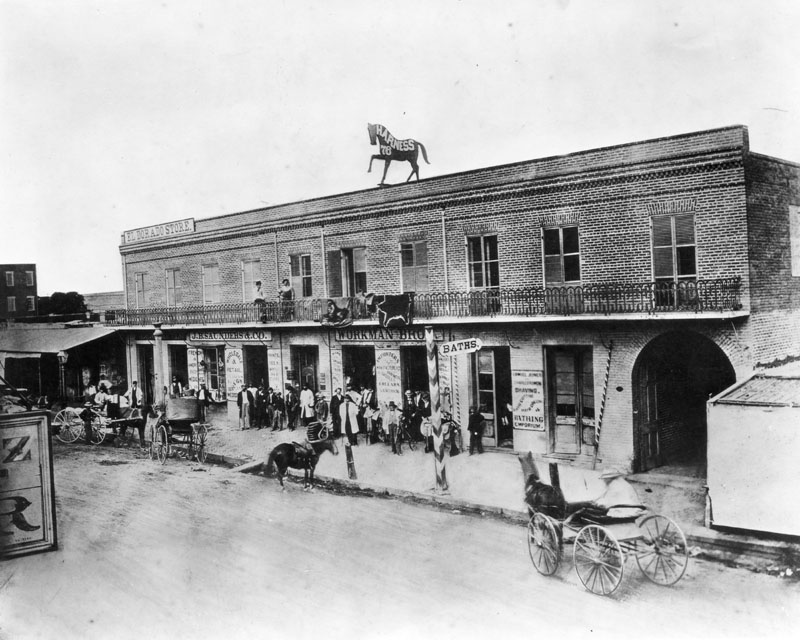 |
|
| (1868)* - View of Workman Brothers Saddlery shop located in a two story, brick commercial building on Main Street between Commercial and Reguena. The shop has J.B. Saunders retail store on one side and a bathing emporium on the other. A large silhouetted sculpture of a prancing horse sits atop the building. |
Historical Notes The first marriage in Los Angeles city history in which both persons had "Anglo" surnames was in September 1845, of William Workman's daughter Antonia Margarita Workman to Pliny Fisk Temple (Francisco P. Temple or F.P.T ). The Temples had eleven children, eight living into adulthood. William Workman and John Rowland organized the first wagon train of permanent eastern settlers, which arrived in Southern California on November 5, 1841. Together they owned and developed the 48,790-acre La Puente Rancho. Workman began this adobe home in 1842 and remodeled it in 1872 to resemble a manor house in his native England. He also established 'El Campo Santo,' this region's earliest known private family cemetery.^* The Workman home and family cemetery have been designated California Historical Monument No. 874. Click HERE to see more California Historical Landmarks in LA. |
* * * * * |
Temple Block
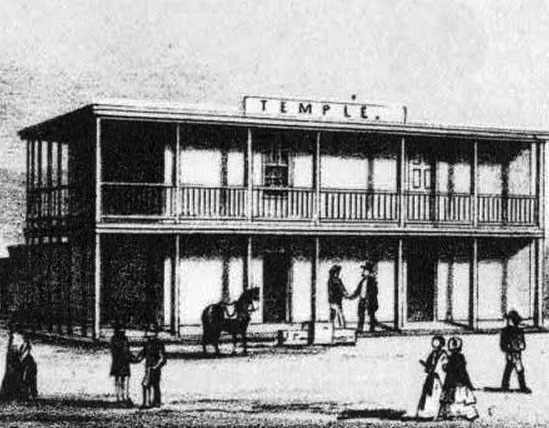 |
|
| (ca. 1850s)*^# - Sketch of John Temple’s original two-story adobe at the intersection of Spring, Main and Temple, which became known as Temple Block. |
Historical Notes In 1827, Jonathan Temple moved to the Pueblo de Los Angeles, where he opened the pueblo's first store, a business he operated for almost thirty years. Temple Street (Los Angeles) was developed by him as a modest one-block dirt lane in the 1850s.^* |
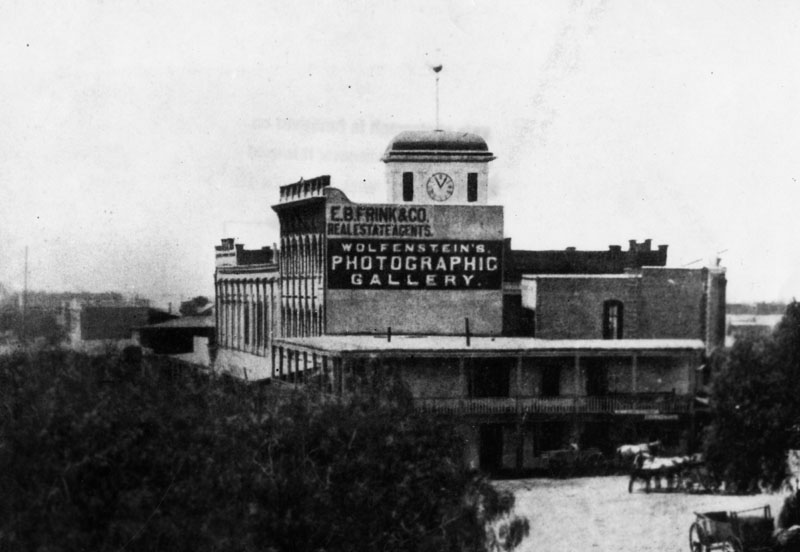 |
|
| (ca. 1872)* - Temple Block exterior view looking south toward Temple Street from some point on the Main Street side of the buildings. John Temple's original two-story adobe can be seen as part of the Temple Block. |
Historical Notes The view above shows John Temple's 1858 Clocktower Market/Courthouse building and the first three buildings on the rest of Temple block. The original Temple Block structure is the two-story adobe at front (see previous photo) at the intersection of Spring, Main and Temple. It was demolished by FPF Temple ("Tempelito"), John's half-brother, to build the new Temple Block building in 1871. "Temple Block" seems to be used to identify all of these buildings and also, only the one in front, facing the intersection (whether the old adobe Temple Block or the new Italianate Temple Block).^*# |
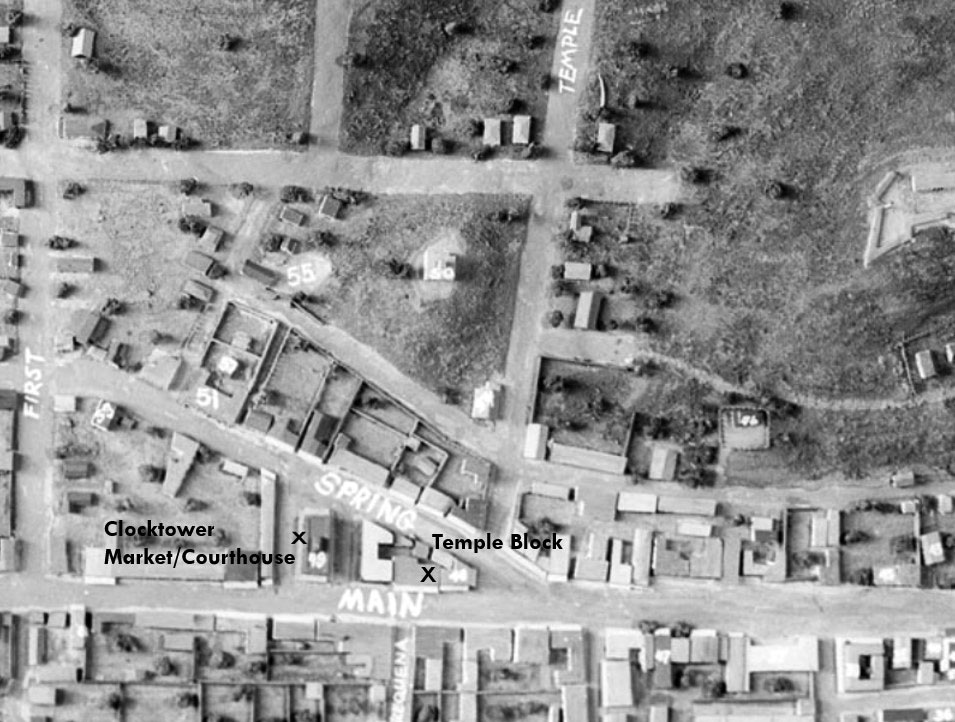 |
|
| (n.d.)^^* - Temple Square (Temple Block) appears at the bottom-center of this photograph of a model of old Los Angeles. John Temple's 1858 Clocktower Market/Courthouse building is also identified. This would become the future site of the current City Hall. |
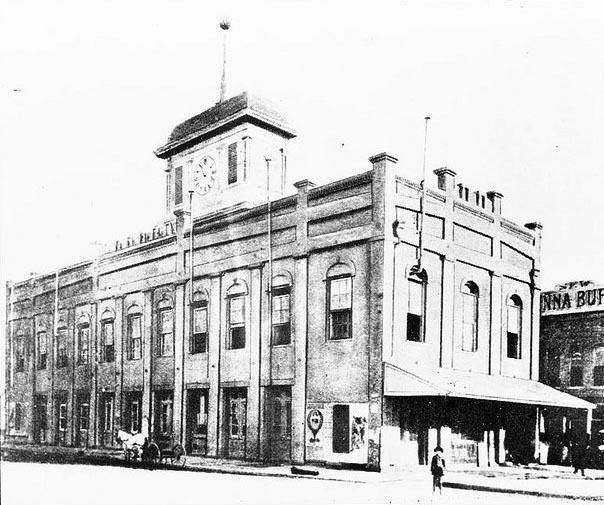 |
|
| (1858)^^ - Photograph of an exterior view of the old City Hall building in Los Angeles. The two story building is long and narrow and has rows of large windows. A small cupola with a clock sits on the roof. |
Historical Notes Jonathan Temple was one of Los Angeles’ first developers, constructing such landmarks as the original Temple Block and the Market House, which later served as city and county administrative headquarters, contained the county courthouse, and featured the first true theater in southern California. He also served as the first alcalde (or mayor) of Los Angeles after capture of the pueblo by the United States during the Mexican-American War and served on the first American-period common (city) council. In 1849, after Los Angeles was ordered by California's military governor to conduct a survey, but couldn't pay for the work, Temple paid for the Ord Survey out of his own funds, and then was repaid by the sale of lots created in the survey.^* |
 |
|
| (1860s)* - Three men stand at the top of the stairs in front of the old County Courthouse. This was actually LA's 5th courthouse location. |
Historical Notes The County Courthouse, which later became the Bullard Block, stood on the site of the new City Hall. It became the seat of government in the early American period.* |
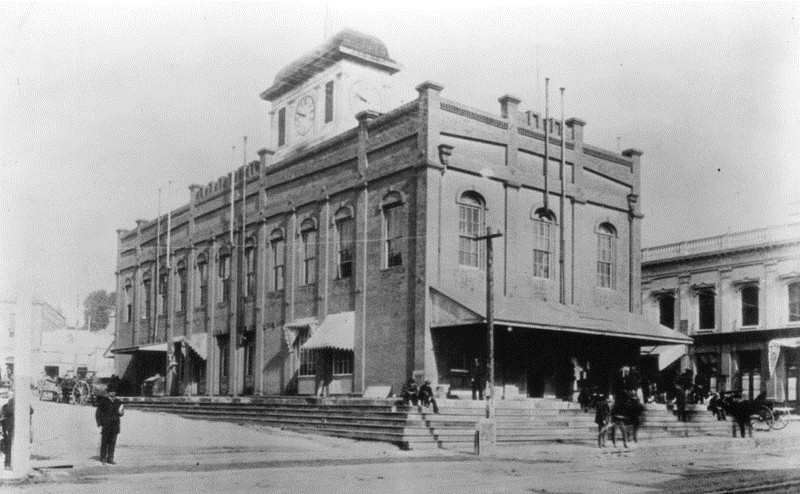 |
|
| (ca. 1869)* - The old County Courthouse, originally built by John Temple in 1858 as a marketplace and theater. |
Historical Notes The first floor of the building was used as a marketplace for a number of years, and the second floor was the first theater in Los Angeles. The building was briefly occupied by Los Angeles City Hall in 1861, but was mostly used by the County as a courthouse between 1861 -1891. The County leased the building for 8 years before purchasing it for $25,000 in 1869. |
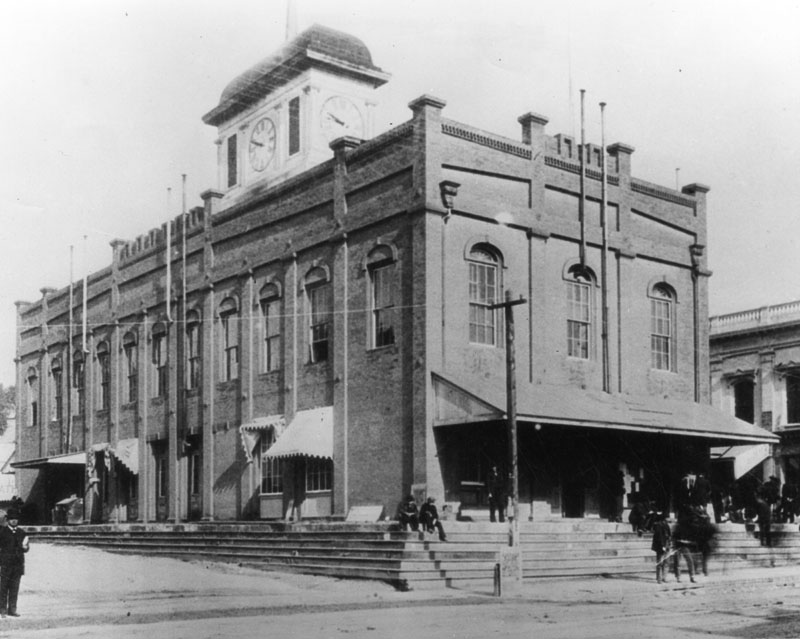 |
|
| (ca. 1869)* - Closer view (same photo as above) of the Clocktower Courthouse. Originally built by John Temple in 1859 for a city market. It was leased to the county in 1861 and then purchased by the county in 1869. |
Historical Notes Famous pioneer lawyers and judges used the courtrooms of this building, which gave way in 1891 to the Red Sandstone Courthouse . Witnesses and attorneys, rather than crowd into the stuffy courtrooms of this Courthouse, sat in the shade of the building or in some office nearby, while waiting their turn. At the right moment the bailiff poked his head out of a window and yelled for the man wanted—calling the name three times at the top of his voice and with “esquire” appended. #^^# |
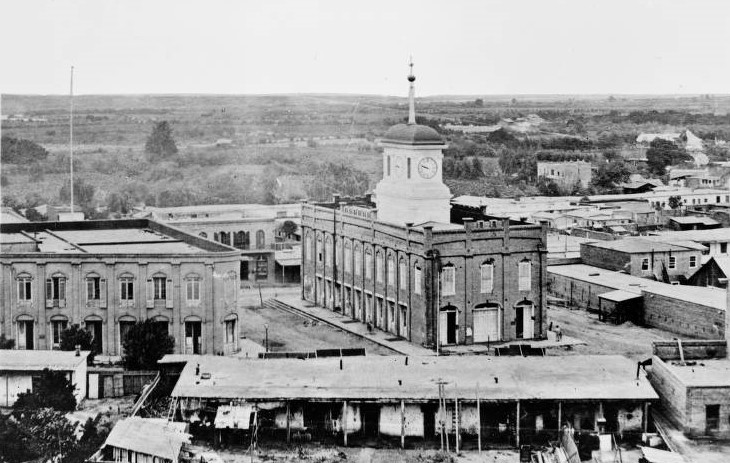 |
|
| (1869)#^ - View looking east at the old LA County Courthouse located in the Temple Block. It was the County's 5th courthouse location. Market Street ran between Main and Spring on the north side of the Clocktower Courthouse building, and Court Street did the same on the south side. |
|
Through more than 150 years the county has used at least eight buildings as its county courthouse. All have been situated within a mile of each other in downtown Los Angeles south of the original plaza in what has for the past 80 years been called the Civic Center. ◆ The first county courthouse was in the adobe Bella Union Hotel, where court was held in rented rooms from 1850 to 1852. |
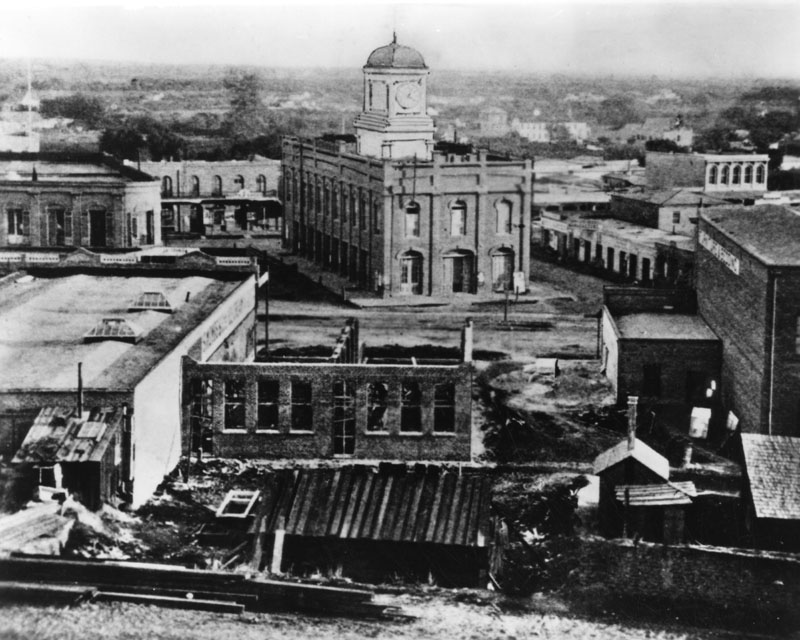 |
|
| (1876)* - View toward the old Courthouse built by John Temple for market and theater, looking east. Spring Street is on the west, Main on the east, and Market on the north and Court on the south. |
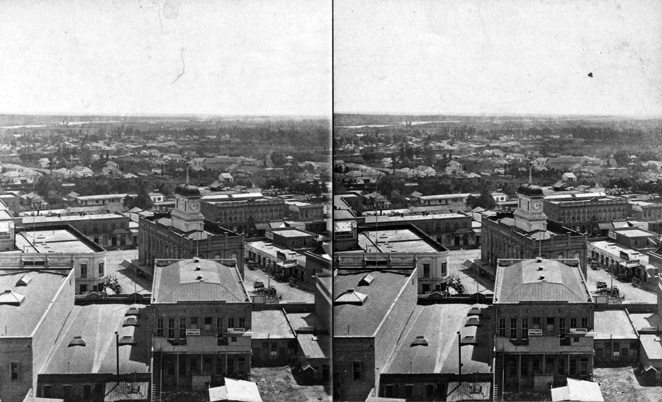 |
|
| (ca. 1881)^## - Stereoscopic view of the old Courthouse and surrounding buildings. The building was occupied as a court between 1861 and 1891. The LA river can be seen in the background. Note: Temple Block would become the site of today's City Hall. |
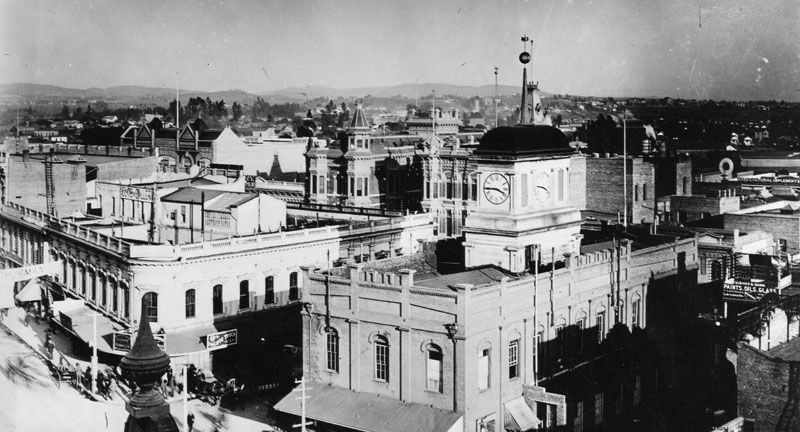 |
|
| (1885)* - View showing the Temple Block and surrounding area in 1885. The intersection of Market and Spring streets is at lower left. |
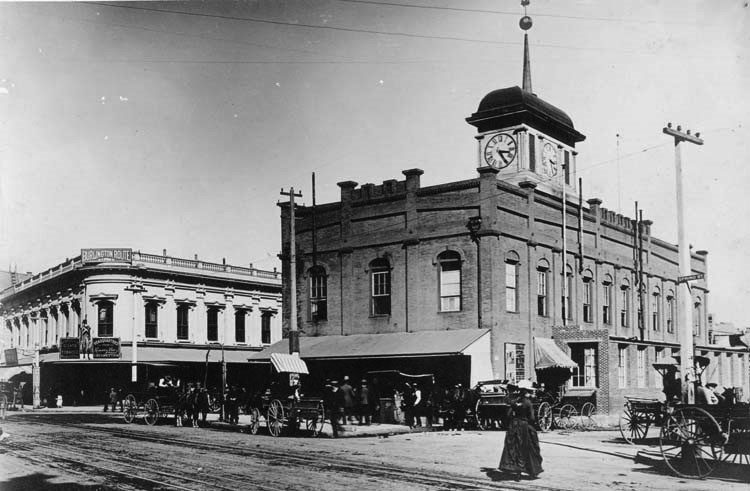 |
|
| (1880s)+^ – View looking northeast showing the Los Angeles County Courthouse with its clock tower. The corner of the courthouse closest to the camera is on the southwest corner of Spring and Court streets. |
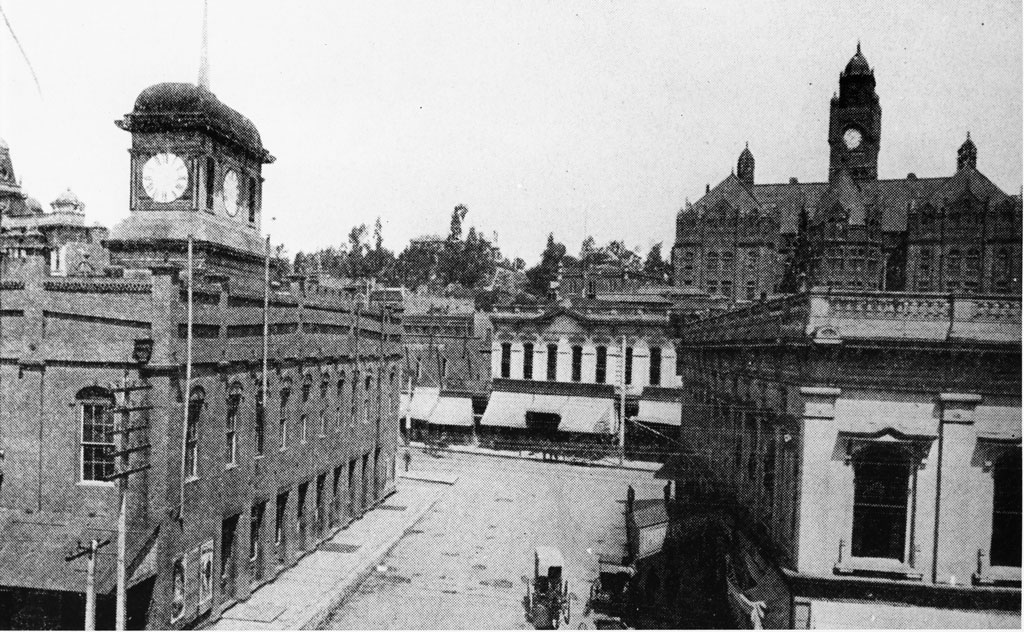 |
|
| (ca. 1891)^*# - View of Market Street looking west from the cupola of the United States Hotel, soon after the construction of the New Courthouse on Pound Cake Hill (background). The old market and Courthouse of Temple Block can be seen at left. |
Historical Notes Temple Block would become the site of today's Los Angeles City Hall. |
Click HERE to see 'From Temple Block to City Hall' |
* * * * * |
Downey Block
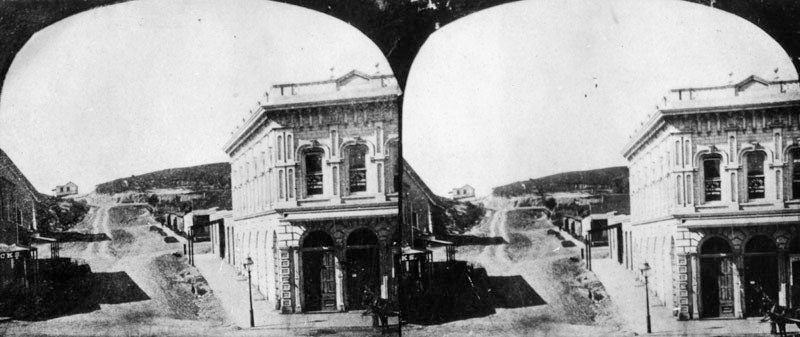 |
|
| (ca. 1870)* - Stereographic card showing an unpaved Temple Street, looking west from Main Street. In the right foreground is the Downey Block located on the northwest corner. |
Historical Notes Construction on the Downey Block began in 1869. It was named for John Gately Downey, a pharmacist who served as the governor of California for two years (1860-1862) before becoming a real estate developer. Downey was also one of the founders and first president of Farmers and Merchants National Bank. The city of Downey was named in his honor after he subdivided his land holdings there and converted them into farms.* |
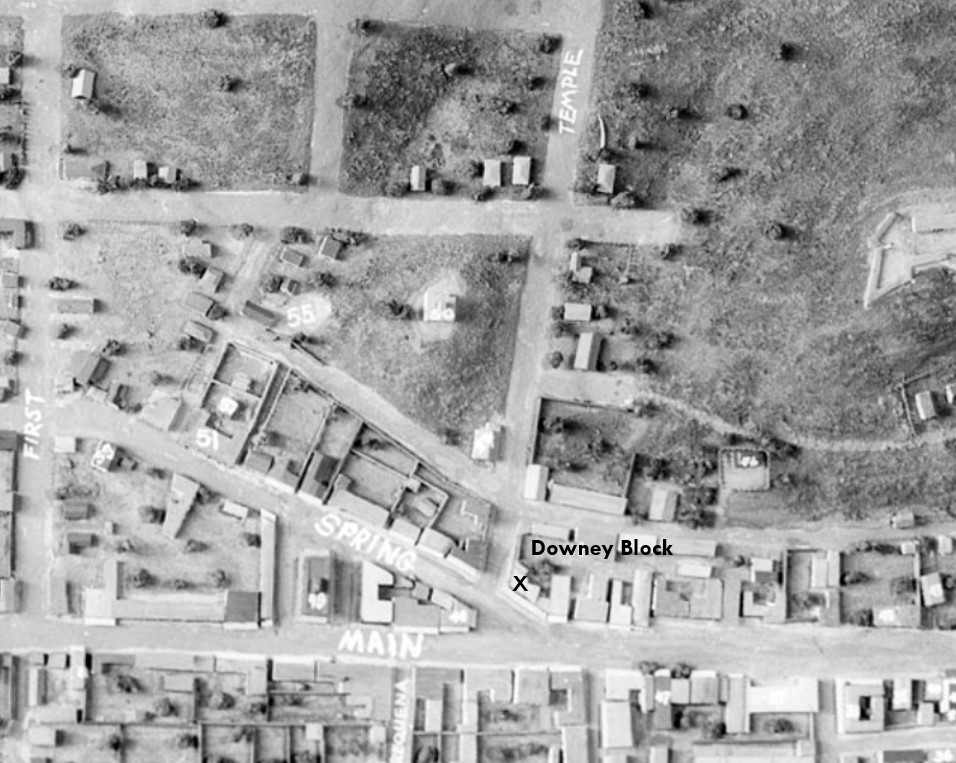 |
|
| (n.d.)^^* - Downey Block was located on the northwest corner of Main and Temple streets, highlighted at the bottom-center of the above model of old Los Angeles. |
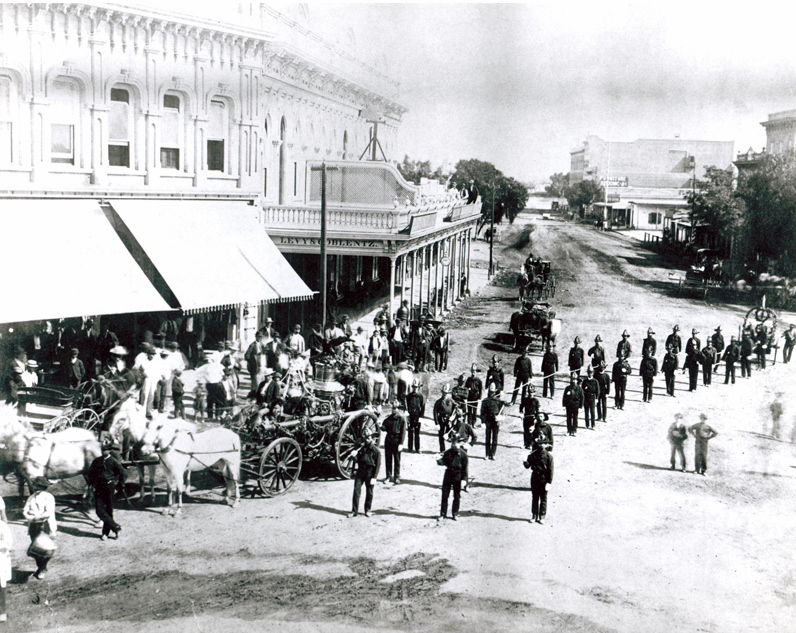 |
|
| (1871)^^* - View looking north on Main Street showing the Los Angeles Fire Department (volunteers) marching by the Downey Block on the left. This was civic parade in L.A., July 4, 1871. |
Historical Notes Photo caption reads: "The first Fire Company was organized on September 30, 1871. The boys are out celebrating the First Anniversary of the occasion with a parade. This is the first known picture taken of the Fire Company. The camera was pointing North from Main and Spring Streets. The Pico House can be seen in the background. The buildings back of the fire engine are on the present site of the Federal Building." |
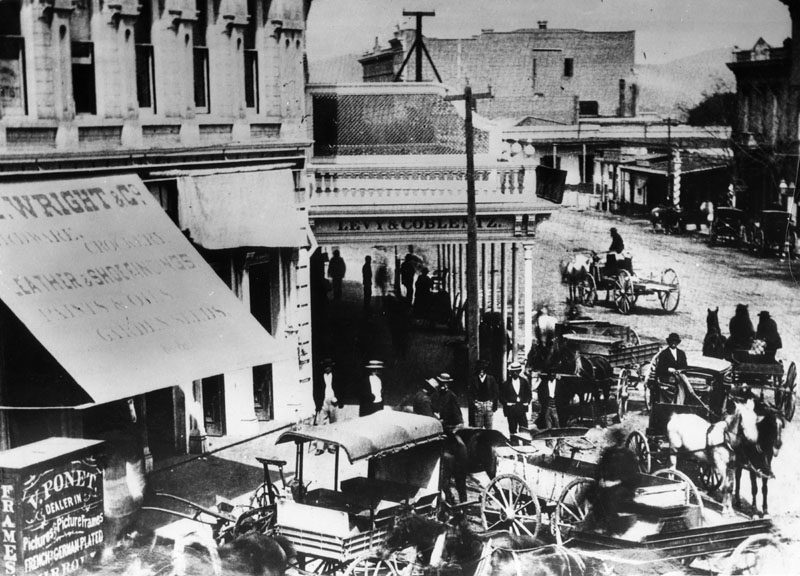 |
|
| (ca. 1871)* - A closer view of the corner of Main and Spring Streets, looking north from Temple Street, showing the Downey Block. Several horse-drawn vehicles are on the street as well as pedestrians milling around. |
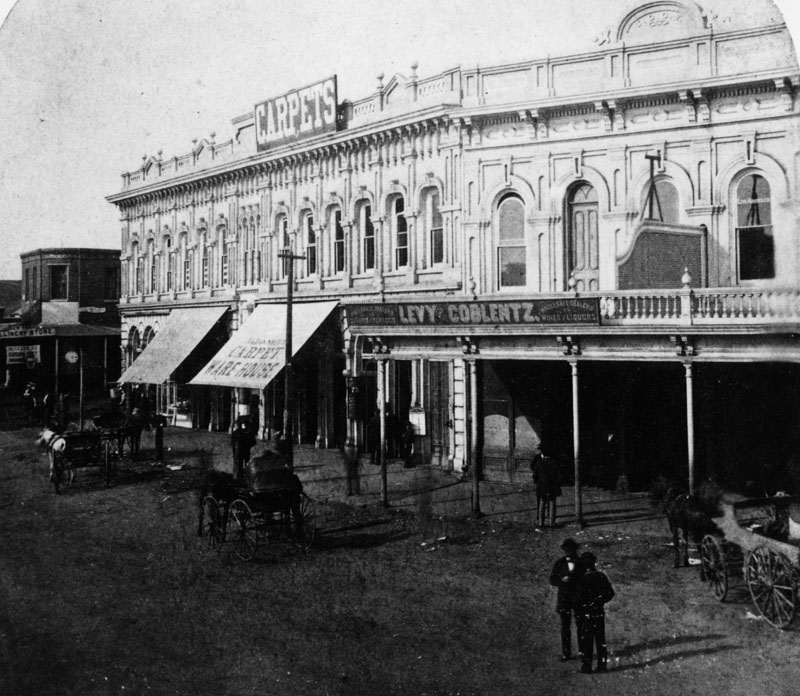 |
|
| (1875)* - View showing the North Main Street side of the Downey Block. Two well-dressed men are standing on the dirt road in front of the building. |
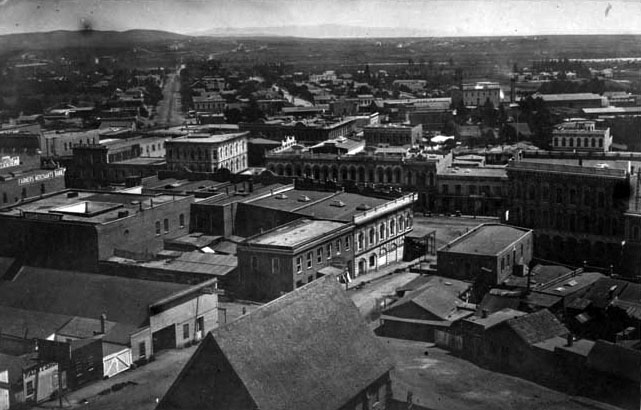 |
|
| (1870s)^## - View looking northeast from the top of Poundcake Hill showing the Downey Block (center) at Temple and Main streets. The building with the pitched roof in the foreground is St. Athanasius Episcopal Church. Acroos the street is the Temple Street Stables (lower-left). Also seen is the Temple Block at center-right. The Los Angeles River runs horizontally across the top of the photo and the wide street at upper left is Aliso Street where the 101 Freeway runs today. |
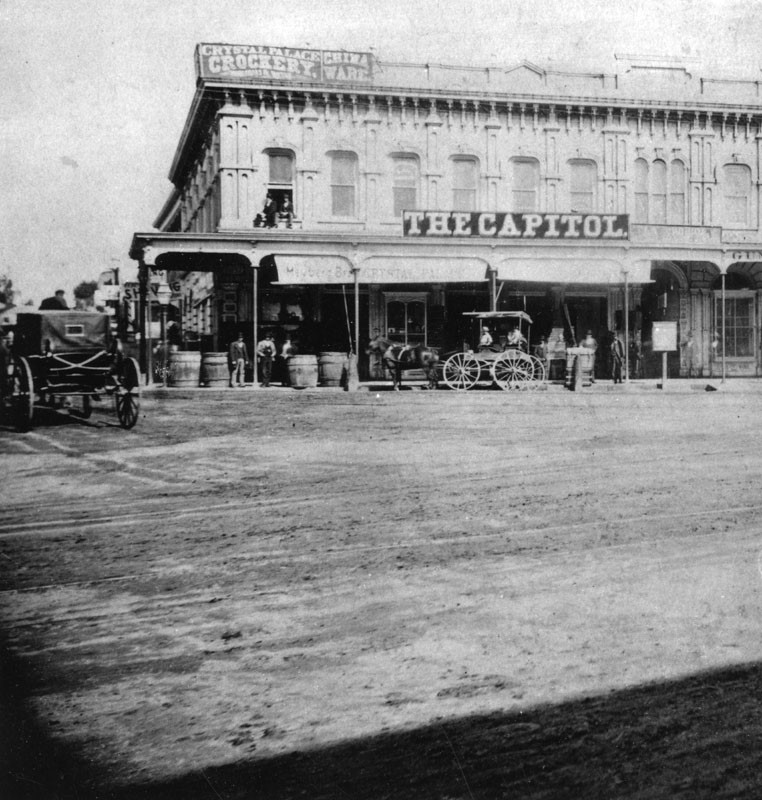 |
|
| (1880s)* – View of the Downey Block located on the northwest corner of Temple and Main streets as seen from the front of Temple Block. The two-story building has a large sign over the portico that reads: THE CAPITOL. Two men are sitting on the window ledge at upper left-center below another sign that reads: Crystal Place Cookery - China Ware. A horse and buggy is parked in front of the building while another appears to be moving west on Temple. |
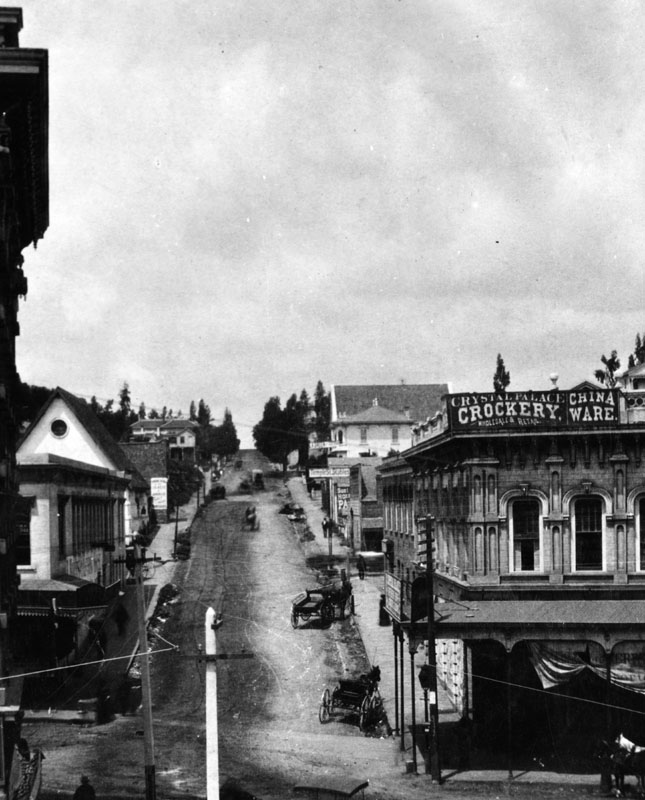 |
|
| (ca. 1884)* - View of an unpaved Temple Street, looking west as seen from the second floor of the Temple Block on Main Street. Horse-drawn carriages and wagons are parked along the street. In the right foreground is the Downey Block, housing the Crystal Palace, wholesale and retail sellers of crockery and china ware. Behind it is the Temple Street Stables. At left-center with ptiched roof and circular window is the St. Athanasius Episcopal Church located ate the southwest corner of Temple and New High streets. Poles strung with electric/telephone wires are seen in the foreground. |
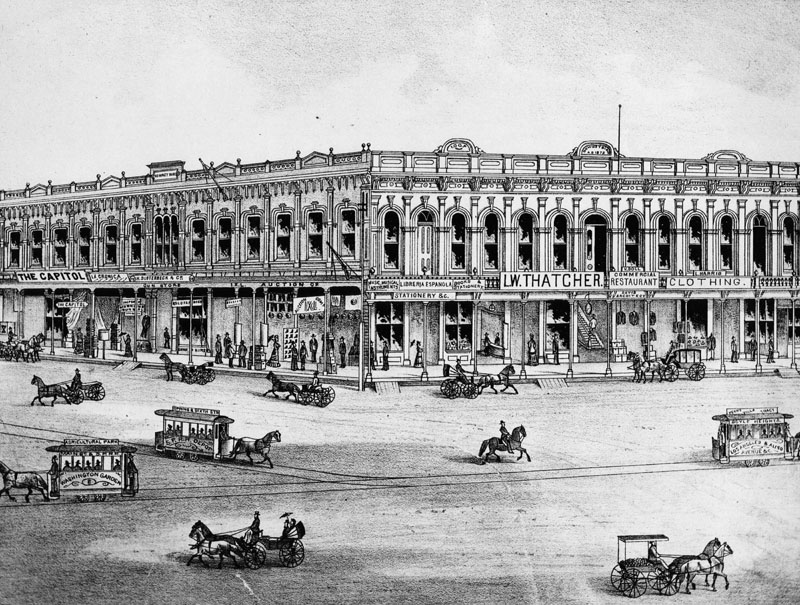 |
|
| (ca. 1880s)* - Drawing of the Downey Block on the northwest corner of Main and Temple Streets. Various horse-drawn vehicles are seen on the street, including horse cars to Agricultural Park/Washington Garden, Spring & 6th Streets/S.P.R.R. Depot, and Boyle Heights/Los Angeles and Aliso Avenue/Perry Villa Tract. |
Historical Notes Various businesses were housed in the Downey Block building, including The Capitol, La Cronica, H. Sloterbeck & Co. gun store, I.W.L. Auction Co., Libreria Espanola, L.W. Thatcher, Commercial Restaurant, Davis Architect, and L. Harris Clothing. Stairs lead up to the second floor, on which the Los Angeles Public Library was housed from 1872 to 1889.* |
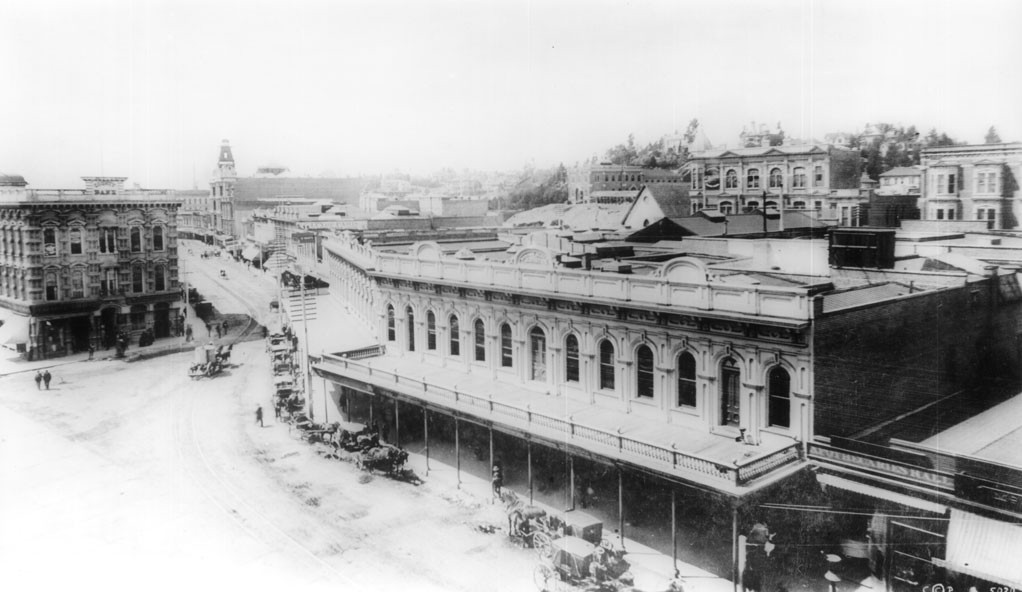 |
|
| (1887)^^ - View of the Downey Block showing a multitude of horse-drawn carriges and wagons that are 'parked' along the curb. |
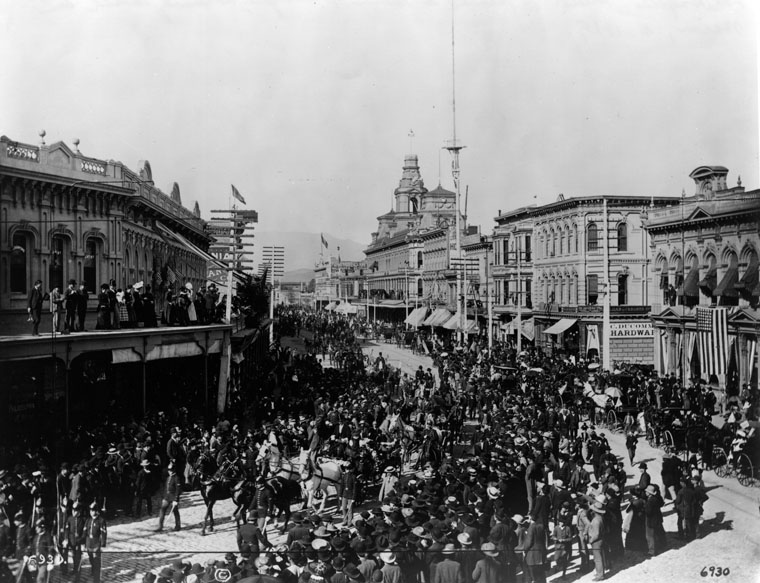 |
|
| (ca. 1889)* - A parade on Main and Temple streets, looking north, in front of the Downey Block. Crowds of spectators flood the street but make way for a horse-drawn carriage escorted by police officers holding sabers. More spectators look from the second-story balcony. |
Historical Notes The above photo provides a good view of the 300 block of North Main Street which was an important part of Los Angeles history as early as the mid-1800s. It was considered the uptown commercial heart of the old city and was always buzzing with activity. Click HERE to see more in Early Views of the Historic 300 Block of N. Main Street Also seen above is the City's new 150-foot tall electric light pole, first put into service in 1882. Click HERE to see more in Early Los Angeles Streetlights. |
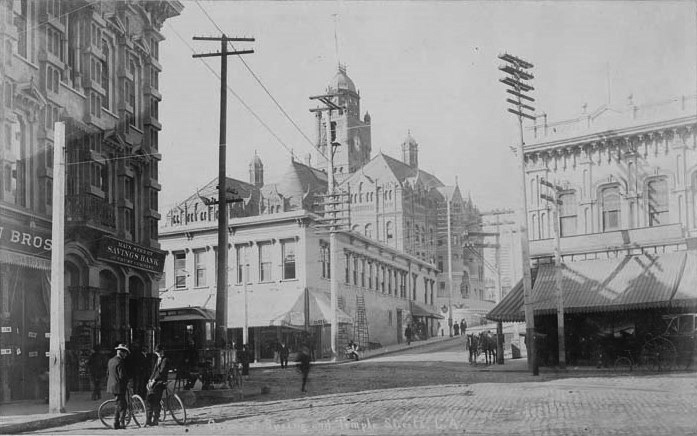 |
|
| (1891)^## - View looking west from the corner of Spring and Temple streets with the Downey Block at right (N/W corner of Main and Temple). The Temple Block is on the left behind the two men leaning on their bicycles and the LA County Courthouse (built in 1891) is in the distance (S/E corner of Broadway and Temple). |
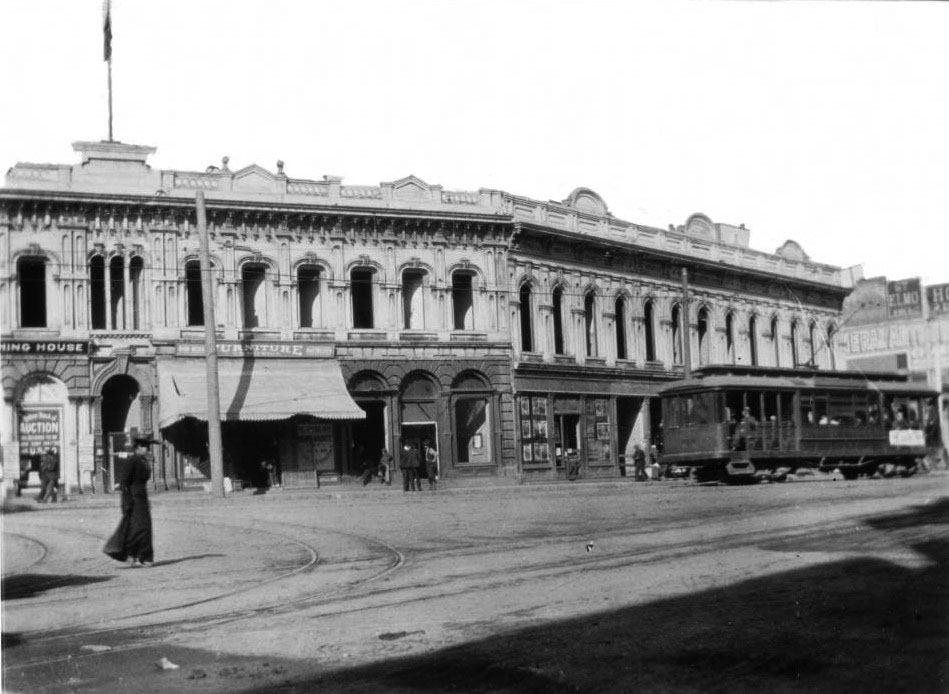 |
|
| (1900)^^* – View looking northwest showing the Downey Block on the northwest corner of Main and Temple streets. There is a streetcar in the street in front of the building at right, and several pedestrians can be seen as well. |
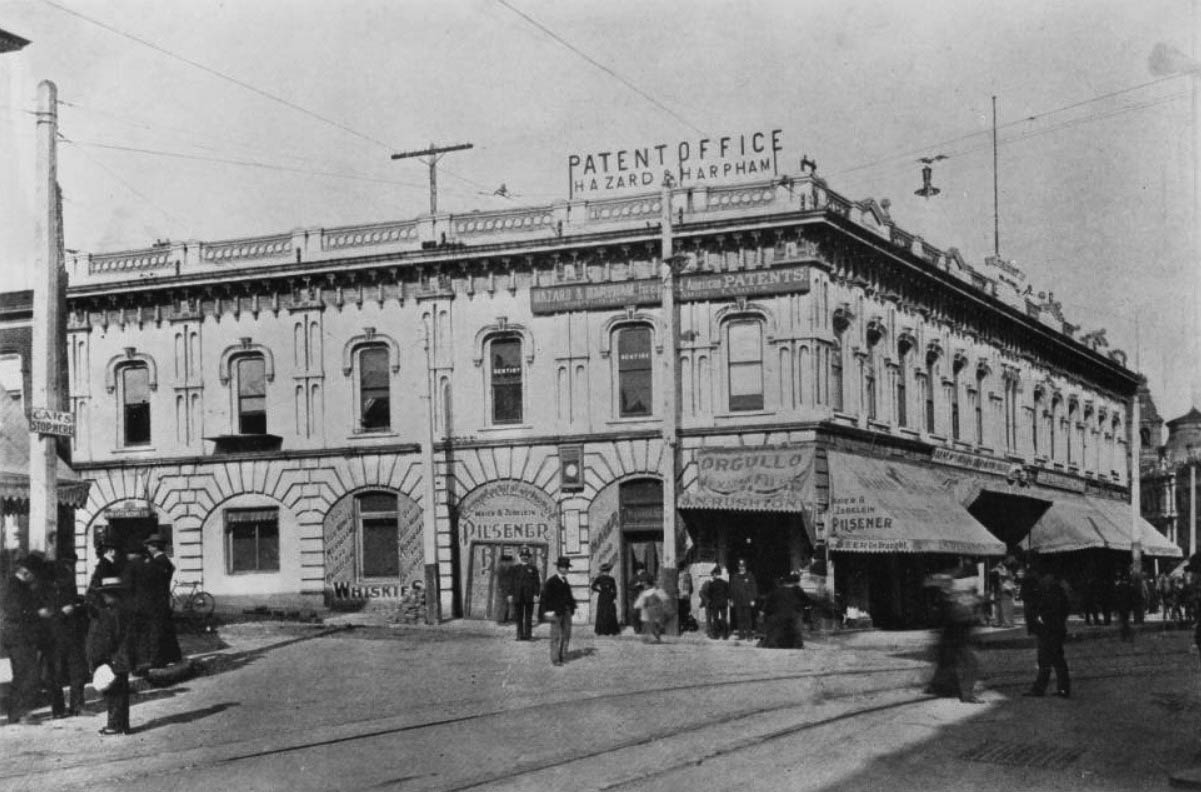 |
|
| (ca. 1904)^^* – View looking north showing the Downey Block on the corner of Spring Street and Temple Street. Men and women stand along the sidewalks and in the street in front of the Romanesque Downey Block, a building which houses several commercial interests; The Hazard and Harpham Patent Office advertises on the top floor, while signs on the bottom floor advertise all types of alcoholic beverages. |
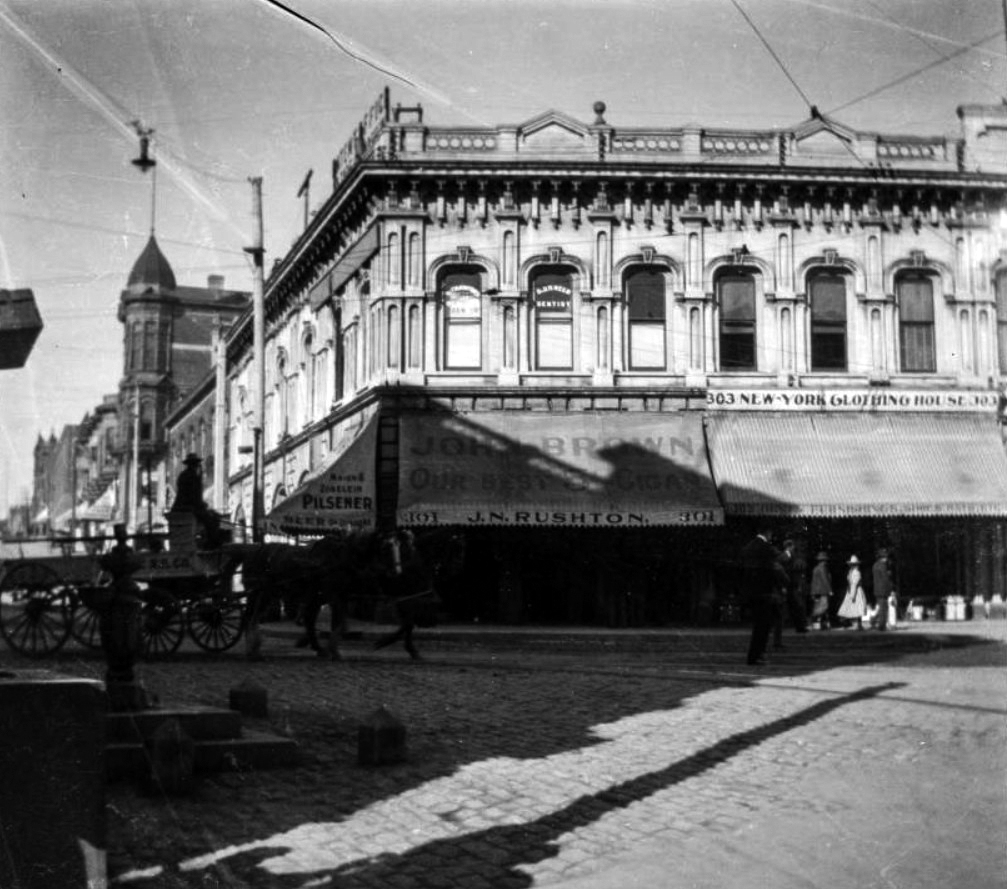 |
|
| (ca. 1904)#^ - Image of the corner of Temple Street and Main Street in downtown Los Angeles showing the Downey Block building, with cobblestone streets and horse-drawn wagon. View is looking west with Temple Street on the left. The fountain in the left foreground stands in front of the Temple Block. The awnings and windows of the Downey Block storefronts have signs including: "Dr. Crawford, Dentist" "Dr. U.D. Reed, Dentist" "Maier & Zobelein Pilsener, Beer on Draught" "John Brown Our Best 5 Cigar... 301 J.N. Rushton" at 301 N. Main Street, and "303 New-York Clothing House." The edge of Hazard and Harpham Patent Office can be seen attached to upper floor of building in upper left of image. |
Historical Notes The Downey Block was demolished in 1904. Since then the corner has been the site of two Federal Buildings: the Federal Building and Post Office (1910 - 1937) and the Federal Courthouse and U.S. Post Office Building (1940 - Present). |
* * * * * |
Pico House
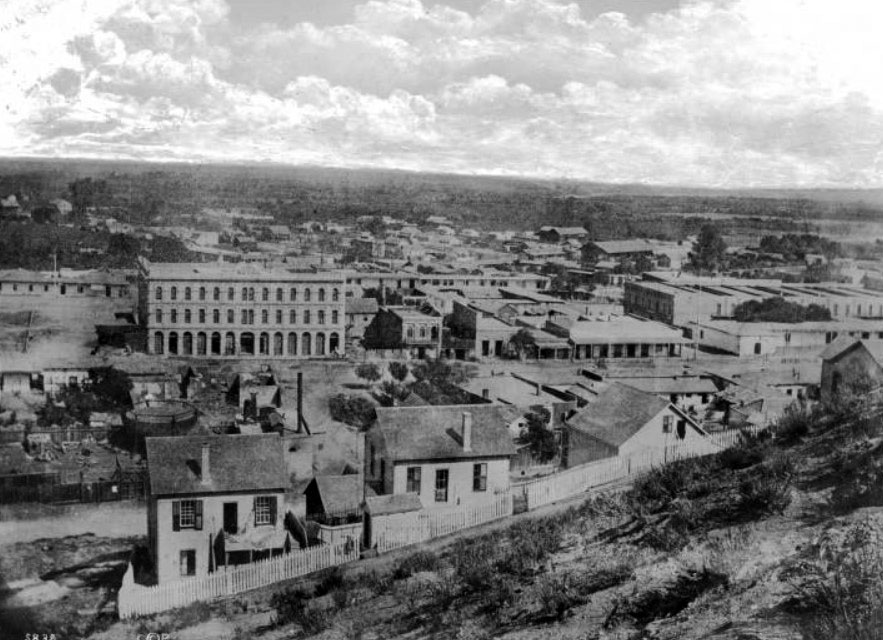 |
|
| (1869)^^* - View showing the Pico House, Masonic Temple and the Plaza area from a hill overlooking Spring Street and Main Street, Los Angeles, December 1, 1869. In the foreground is a community of small houses. Just beyond the community is the Pico House, which faces Main Street. The Plaza is to the left of the Pico House. The Masonic Temple (or Hall) stands several buildings to the right of the Pico House. A majority of the buildings in view are residential houses. |
Historical Notes Pío de Jesús Pico (May 5, 1801 – September 11, 1894) was the last Governor of Alta California (now the State of California) under Mexican rule. In 1868, he constructed the three story, 33-room hotel, Pico House (Casa de Pico) on the old plaza of Los Angeles, opposite today's Olvera Street. In 1821 Pico set up a tanning hut and dram shop in Los Angeles, selling drinks for two Spanish bits (US 25 cents). His businesses soon became a significant source of his income. By the 1850s Pico was one of the richest men in Alta California. In 1850 he purchased the 8,894-acre Rancho Paso de Bartolo, which included half of present day Whittier. Two years later, he built a home on the ranch and lived there until 1892. It is preserved today as Pio Pico State Historic Park. Pico also owned the former Mission San Fernando Rey de España, Rancho Santa Margarita y Las Flores (now part of Camp Pendleton), and several other ranchos for a total of over one half-million acres, or 800 mi². ^* |
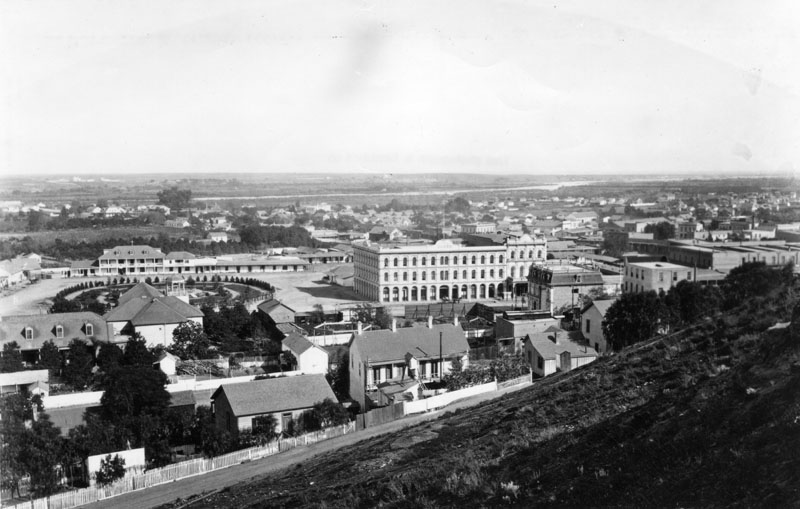 |
|
| (1876)* - Panoramic view of the Los Angeles Plaza in 1876. The Pico House is the prominent 3-story white building at the center of the photo. The LA River can be seen in the background. |
Historical Notes At the time of its opening in 1870, it was the most lavish hotel in Southern California. Even before 1900, however, it began a slow decline along with the surrounding neighborhood, as the business center moved further south. After decades of serving as a shabby flop house, it was deeded to the State of California in 1953, and is now a part of El Pueblo de Los Angeles State Historic Monument. It is used on occasion for exhibits and special events.^* |
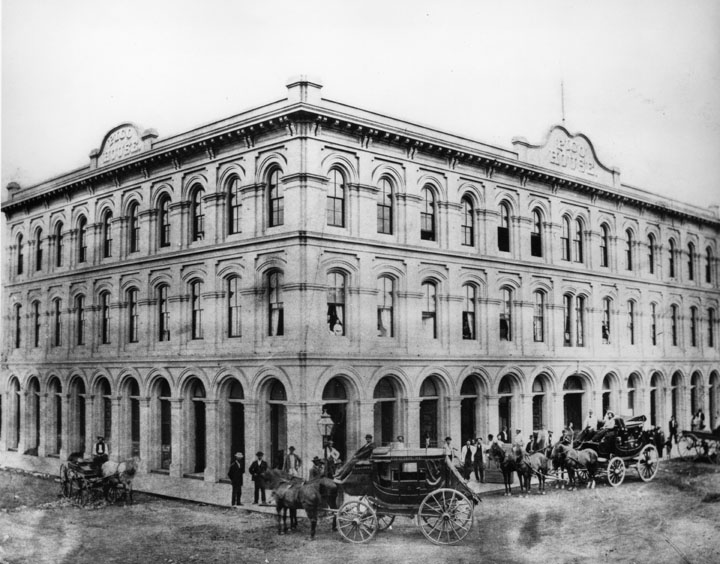 |
|
| (1875)* - The Pico House, built by Pio Pico 1869-70. Several men are standing on the sidewalk while a stage coach and two other horse-drawn wagons are parked in front of the hotel. |
Historical Notes The Pico House was designated California Historical Landmark No. 159 (Click HERE to see more in California Historical Landmarks in Los Angeles). |
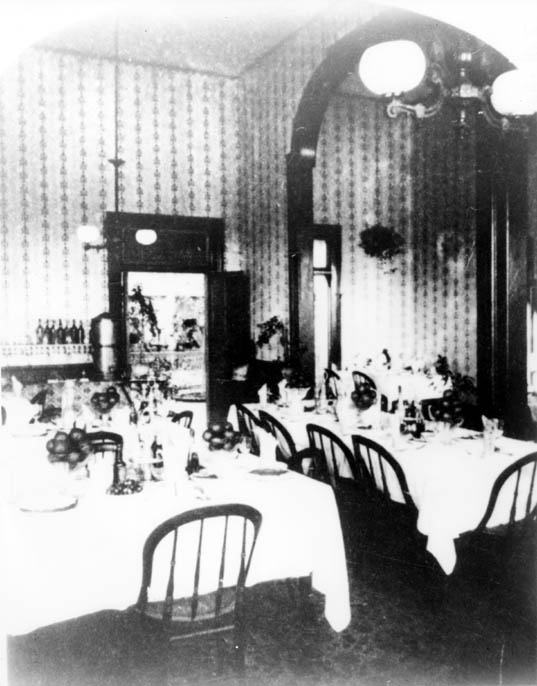 |
|
| (late 1800s)**#^ - View of the Pico House dining room circa late 1800s. |
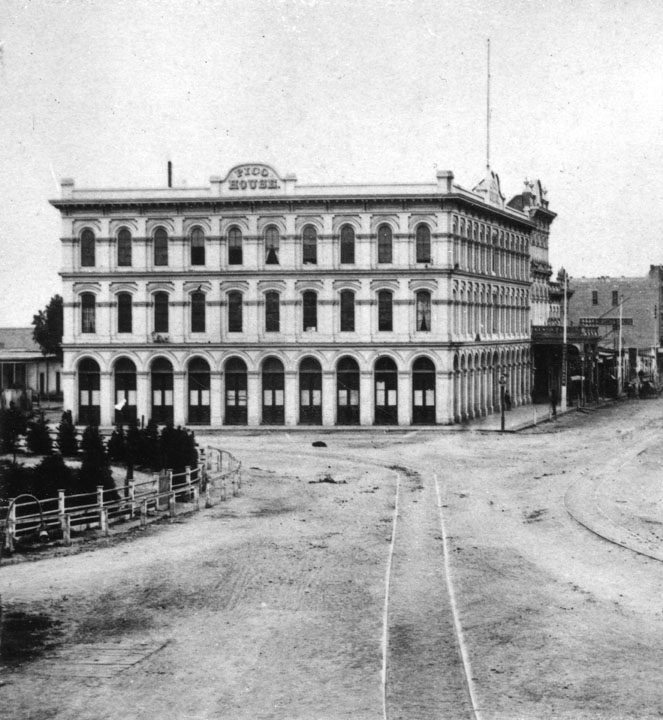 |
|
| (1878)* - The Pico House, sometimes called "Old Pico House" was built by Pio Pico in 1869-70. Seen here from the Main St. entrance of the Plaza. The road in front and to the side of the building is dirt, and a set of tracks runs down the middle. |
.gif) |
|
| (n.d.)*#^ - Map of Historic Sites in and near the Plaza Area. The Pico House sits on the southeast corner of Main and Republic, across from the Plaza. |
Historical Notes Map of Historic Sites in and near the Plaza Area. On this map, streets which no longer exist are shown in a light grey, and/or labeled in italics. The approximate locations of the 101 freeway and its ramps are shown in a darker grey. Buildings which no longer exist are outlined with dotted lines.*#^ Click HERE to see more in Early Views of the LA Plaza |
* * * * * |
Merced Theater
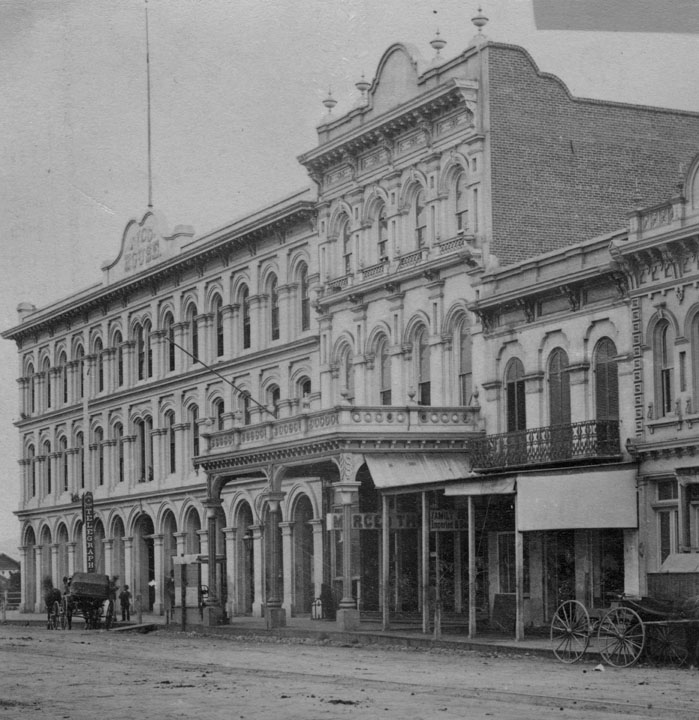 |
|
| (1870s)* - The Merced Theater sits between the Pico House, and the Masonic Lodge. This was the "first business block on Main Street". |
Historical Notes The Merced Theatre, erected in 1870 on North Main Street next to the Pico House, was the first building built expressly for theatrical purposes in Los Angeles. It was built by William Abbot, a cabinetmaker, and named in honor of his wife Merced Garcia.*^* The theater was built in an Italianate style and operated as a live theater from 1871 to 1876. When the Woods Opera House opened nearby in 1876, the Merced ceased being the city's leading theater. Eventually, it gained an "unenviable reputation" because of "the disreputable dances staged there, and was finally closed by the authorities." ^* |
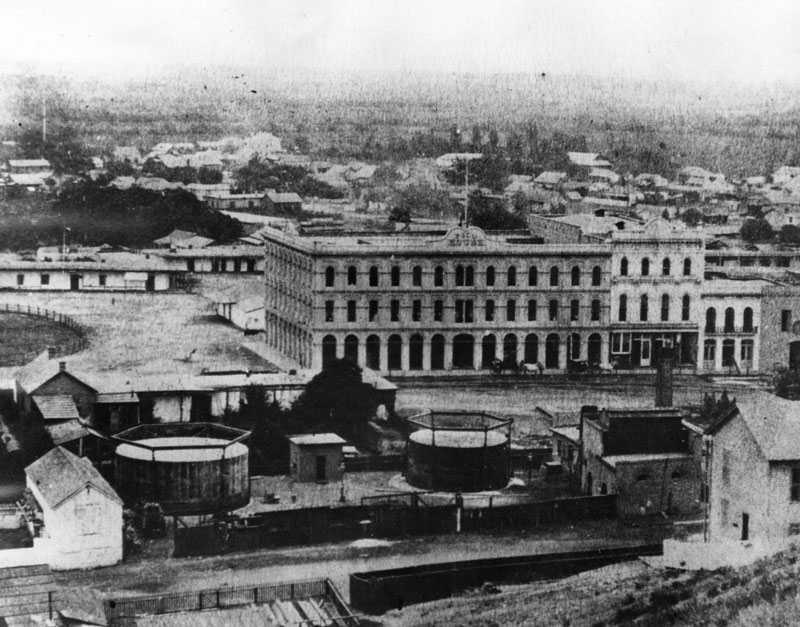 |
|
| (ca. 1876)* - Main Street and Plaza showing the Pico House, the Merced Theater, and the Masonic Lodge. The first gas works can also be seen in the foreground; the tanks were built in 1867, the Pico House and Merced Theater in 1870 and the Masonic Lodge in 1865. |
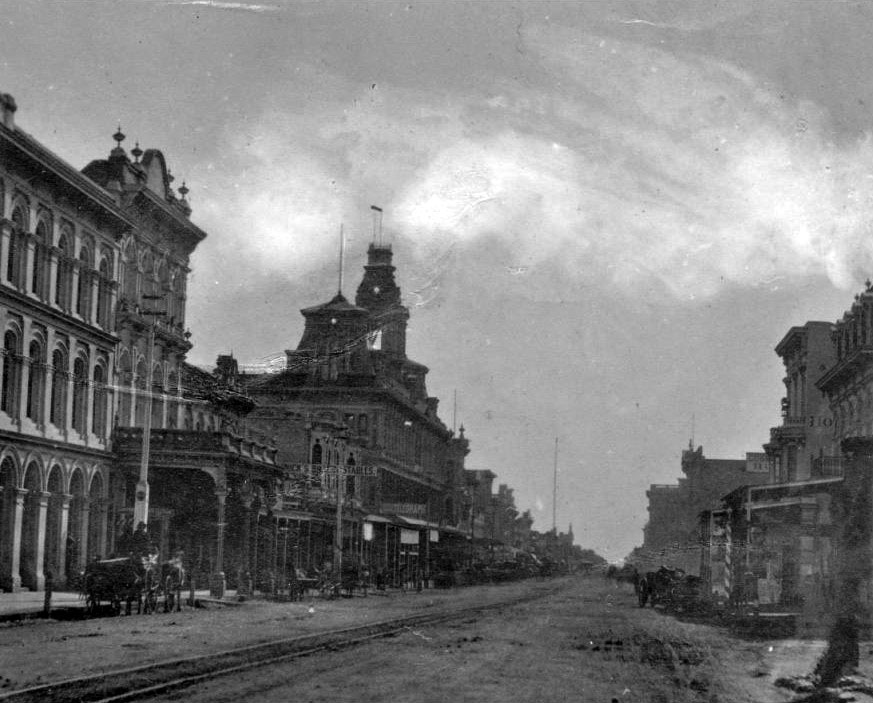 |
|
| (ca. 1878)^^* - View of Main Street looking south. A horse-drawn wagon with two men in it is parked in front of the Pico House near the Merced Theatre on the left. The road is unpaved and a streetcar track runs down the middle. Both sides of the street are lined with imposingly large buildings. At center on the left side of the street is an especially big building topped by three prominent towers (Baker Block ). Most of the other buildings are somewhat Romanesque, with large columns and archways dominating their facades. Click HERE to see more in Early Views of the Historic 300 Block of N. Main Street. |
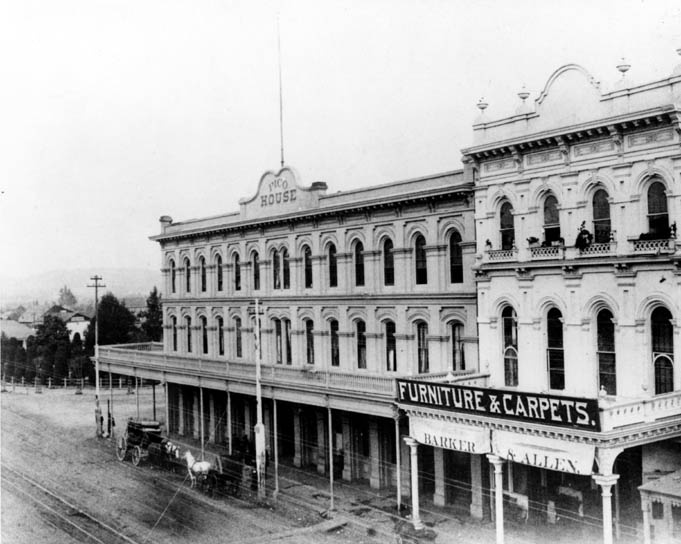 |
|
| (1890s)**#^ - View of Main Street looking northeast. The Plaza, Pico House, and Merced Theater are visible. A sign above the theater reads “Barker & Allen, Furniture & Carpets.” A stagecoach and horse-drawn wagon are parked in front of the Pico House. |
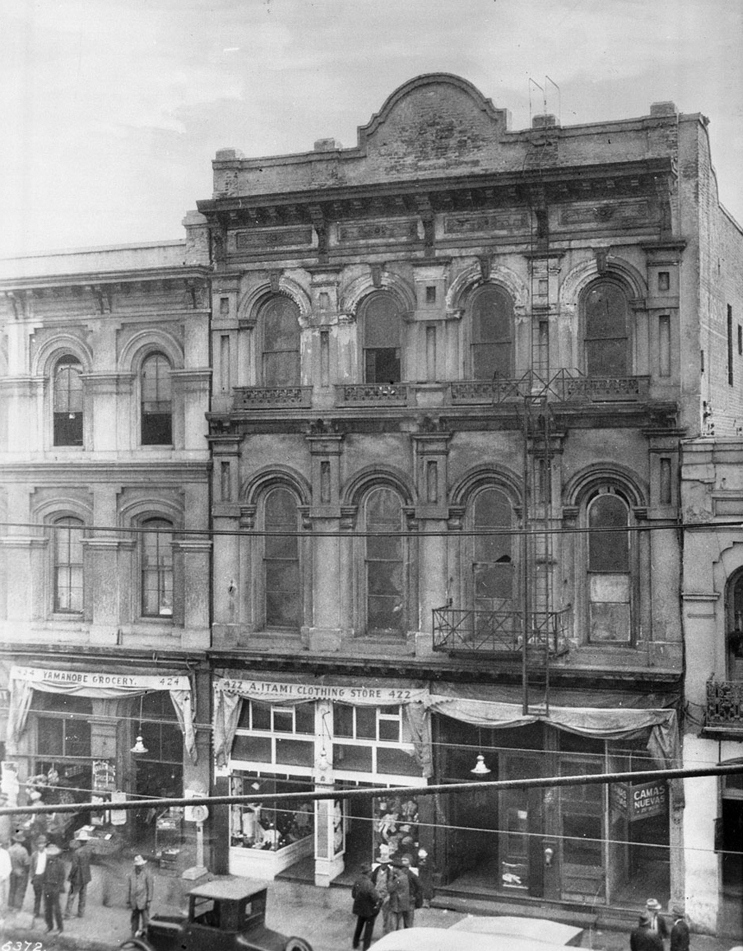 |
|
| (ca. 1909)^^* - Photograph of the Teatro Mercedes (or Merced Theatre). Below the Romanesque architecture of the three-story building, a crowd of pedestrians stand in front of the Japanese shops at ground level which read "A. Itami Clothing Store" and "Yamanobe Grocery". An early model automobile is partially visible in the foreground. |
Historical Notes The Merced Theater, completed on December 31, 1870, opened its first professional engagement on January 30, 1871. It was "used later as an Armory, then again as a Fire Engine house".^^* |
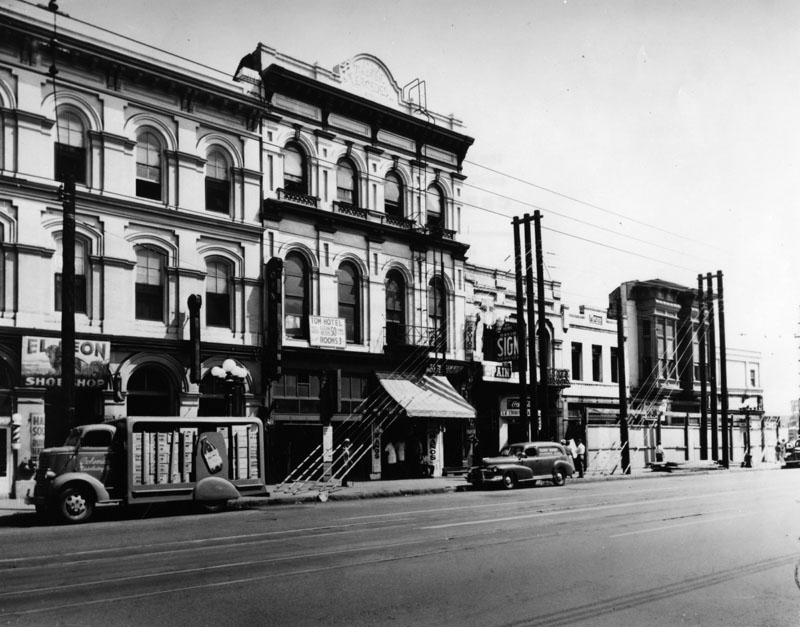 |
|
| (ca. 1945)* - Exterior view of front of the Merced Theater and businesses to the left and right down the street. Signs can be seen for a barber shop, a shoe shop, the Tom Hotel and others. To the left of the Merced is a portion of the Old Pico House. |
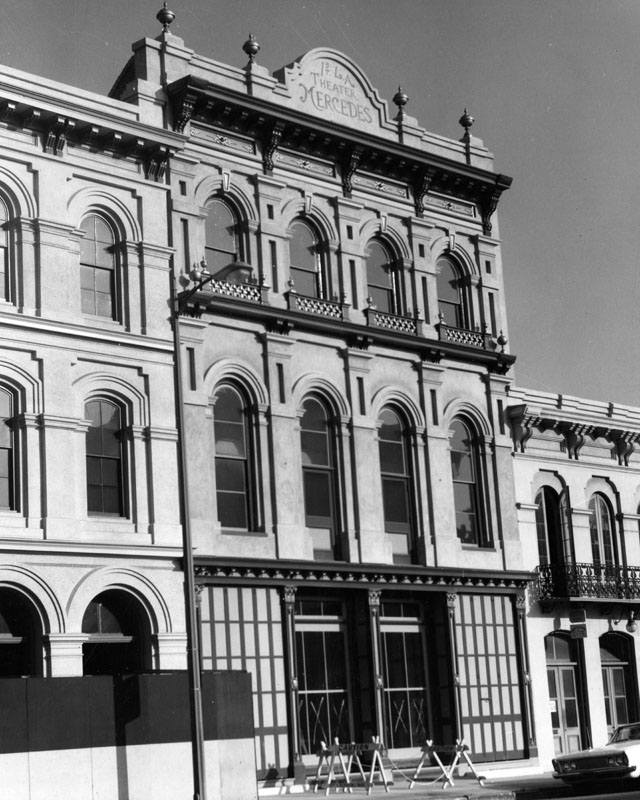 |
|
| (1968)* - View showing the front of the Merced Theatre. At the very top reads, "1st L.A. Theater Mercedes." On the left is the Pico House. Photo by William Reagh |
Historical Notes Ezra F. Kysor designed the Italianate theater, built in 1870 by William Abbott and named for his wife. It opened on January 30, 1871 and is the oldest surviving theater in Los Angeles.* The Merced Theatre was dedicated as California Historical Landmark No. 171. Click HERE to see more in Early Views of the LA Plaza |
* * * * * |
.jpg) |
|
| (1868)^^* - Left panel of a panoramic photograph/sketch of downtown Los Angeles looking east from Bunker Hill with each property annotated and listed at top. The photographer, S. A. Rendall, can be seen standing in his own photo (#14). |
Historical Notes The above photo was taken from a section of Bunker Hill called "Poundcake Hill", the future site of the old Los Angeles High School (1873) and later the location of Los Angeles' second County Court House (1891). It was this time that Los Angeles began growing faster than anywhere in the country. By 1870, the City's population increased to 5,730, a 350% jump from when it was incorporated as a municipality in 1850. By 1900, LA's population would mushroom to over 100,000 people.^* |
.jpg) |
|
| (1868)^^* - Right panel of a panoramic photograph/sketch of downtown Los Angeles looking east from Bunker Hill with each property annotated and listed at top. The location of the camera was at the top of a hill called ‘Poundcake Hill’ the future site of Los Angeles High School (1873) and the 2nd L.A. County Court House (1891). |
Historical Notes S. A. Rendall, the photographer of the amazing panoramic photo seen above, is mentioned in a 1911 publication titled: OUTPOST – Preserving Historical Data by W. S. Broke. “Remembering that no city in the United States has had a rate of growth commensurate with that of Los Angeles, the preservation of historical data becomes of pressing importance. Much of the photographic material illustrating the early life of the city has been preserved but as far as can be ascertained little of this immediately available for all comers. … There does not appear to have been any systematic attempt to preserve photographs of the city prior to the early 80s. The late S. A. Rendall, whose children now reside in Los Angeles, was a photographer who did much toward preserving the appearance of the early Los Angeles—the city of the ‘60s and ‘70s. What has become of most of his negatives is not known, although they would be of immense historical value were they now available. Perhaps the best thing that he left behind is a bird’s eye view of Los Angeles taken in 1868 from the site of the present court house. This photograph is the property of George W. Hazard, who has it covered by copyright, and who has it on sale. It is a remarkable photograph in every way.” #** |
* * * * * |
Los Angeles High School
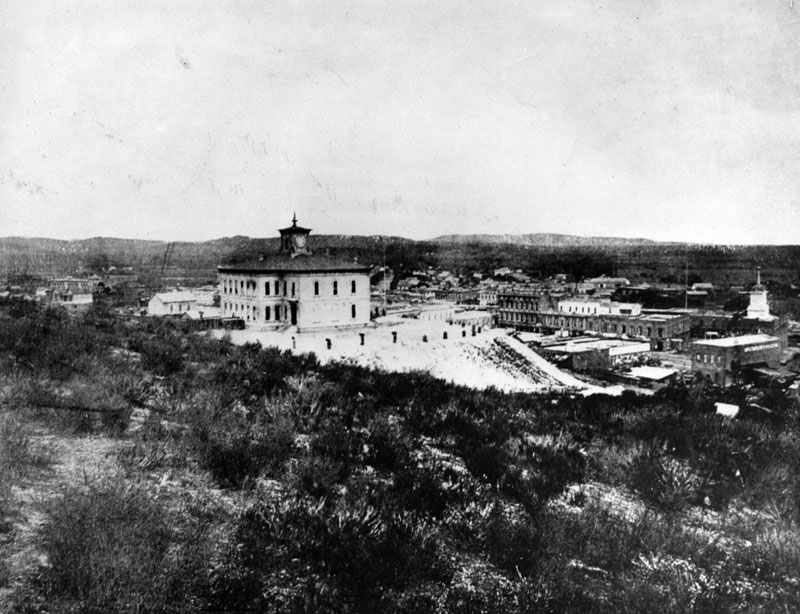 |
|
| (1873)* - Old Los Angeles High School, looking east from the hill on North Broadway at Court Street. The Temple block stands to the right of the school. Broadway, first known as Fort Street, was cut through the bushes in the foreground. |
Historical Notes Construction on Los Angeles' first public high school, (the Jesuit Loyola High School is older) began on July 19, 1872, at the former site of Central School on what was then known as Poundcake Hill, at the southeast corner of Fort Street (later Broadway), which the front of the school faced, and Temple Street, with the back of the school to New High Street (later Spring Street).^* |
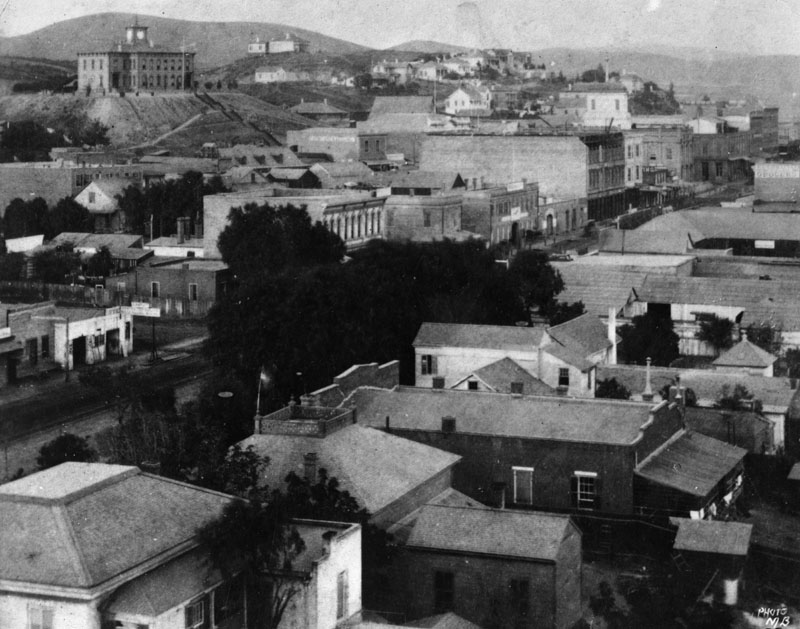 |
|
| (ca. 1875)* - View looking northwest from Main and 1st streets. Los Angeles High stands tall on top of "Poundcake Hill" in the distance. |
Historical Notes Los Angeles High School was one of the architectural jewels of the city, and was strategically placed at the summit of a hill, the easier to be pointed to with pride. One of the school's long standing mottos is "Always a hill, always a tower, always a timepiece." ^* |
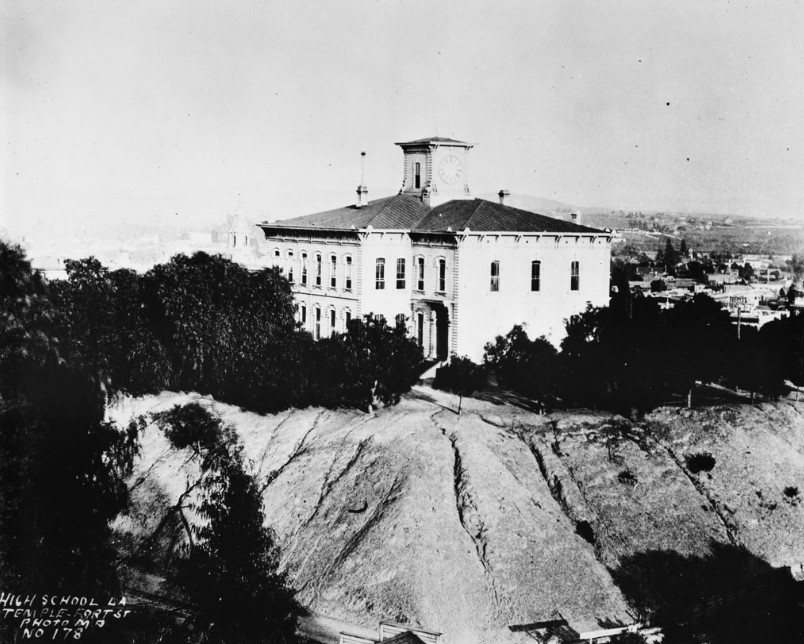 |
|
| (ca. 1878)^^* - View looking southeast showing Los Angeles High School at Temple and Fort Street on Poundcake Hill. In the haze just to the left of the school building you can just make out the clock tower of the Temple Block. |
Historical Notes The two-story wooden structure was so big and grand, the finest school south of San Francisco at that time, with classic lines and a tower with a clock in it, that people traveled from miles around to see it. The teachers liked the wide corridors, walnut banisters, generous windows and the transoms over the doors.^* |
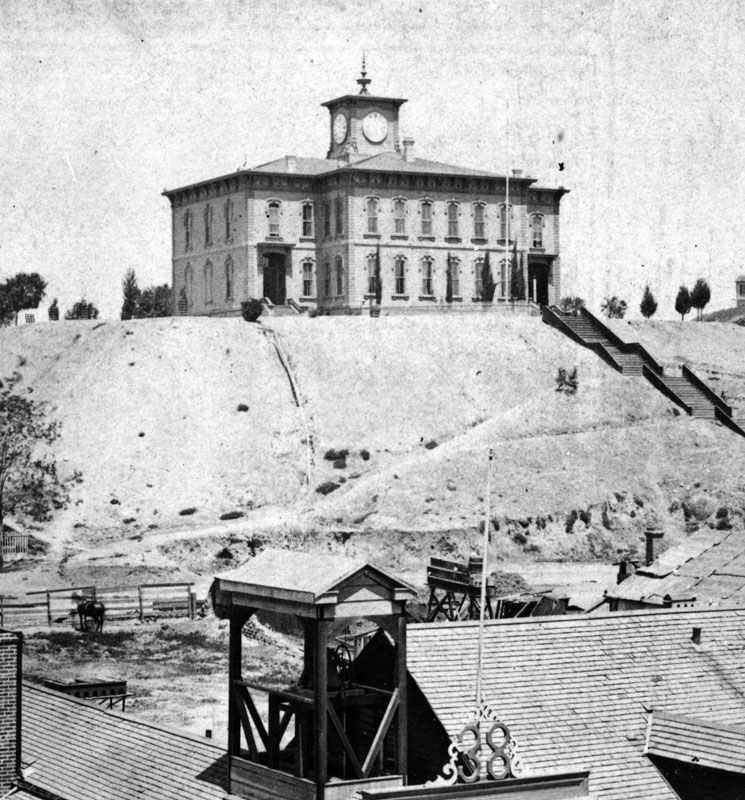 |
|
| (ca. 1870s)* - View showing the first Los Angeles High School on Poundcake Hill. A horse can be seen standing by a fence in the left foreground. |
Historical Notes The schoolhouse was completed at a cost of $20,000, in 1873. Nearby, in succession, was the Court House, the City Hall, the Jones-Lindley Market and the Post Office. The first principal was Rev. Dr. William T. Lucky (1821–1876) and the first graduating class, in 1875, consisted of seven students.^* |
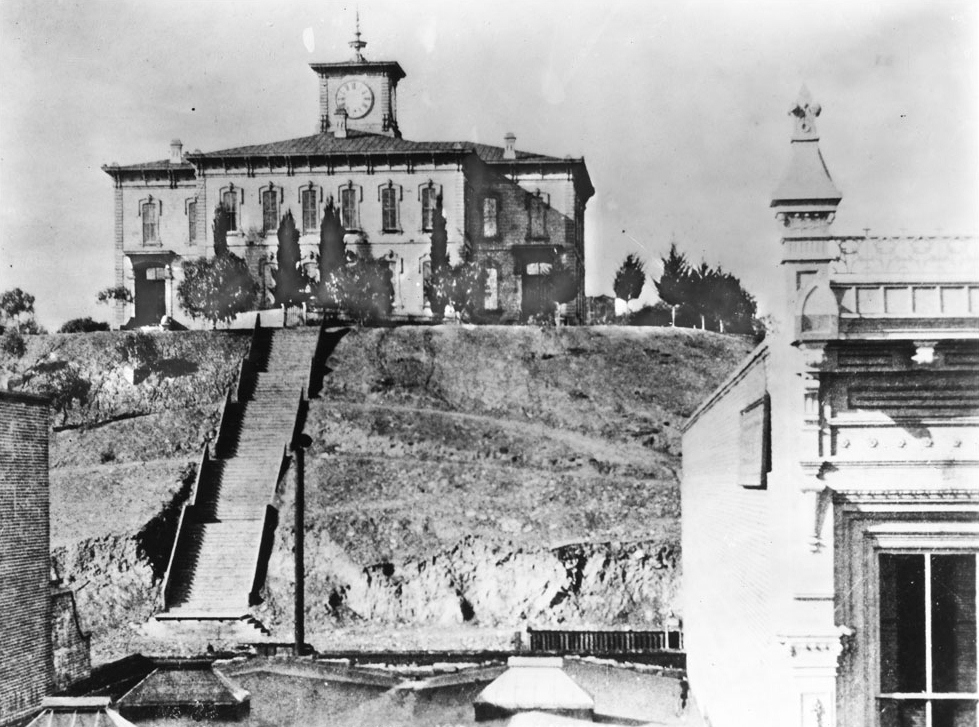 |
|
| (ca. 1880)^^* - View of Los Angeles High School from Temple Street sitting on top of 'Poundcake Hill'. A long flight of stairs can be seen going from the bottom of the steep hill to the top. |
Historical Notes In 1886, the decision was made to move the high school building to Sand Street (later California Street, now part of the Hollywood Freeway), just to the west of North Hill Street and below the south side of Fort Moore Hill, in order for the Los Angeles County Courthouse to be built on Poundcake Hill. The contractor, Mr. Hickam, said he could do the job with scaffolding, rollers, horses and workmen. But his bid turned out to be too low. He lost a considerable amount of money because of his elaborate preparations, including the high wooden trestle which carried the building over the intersection of Temple and Fort Street.^* |
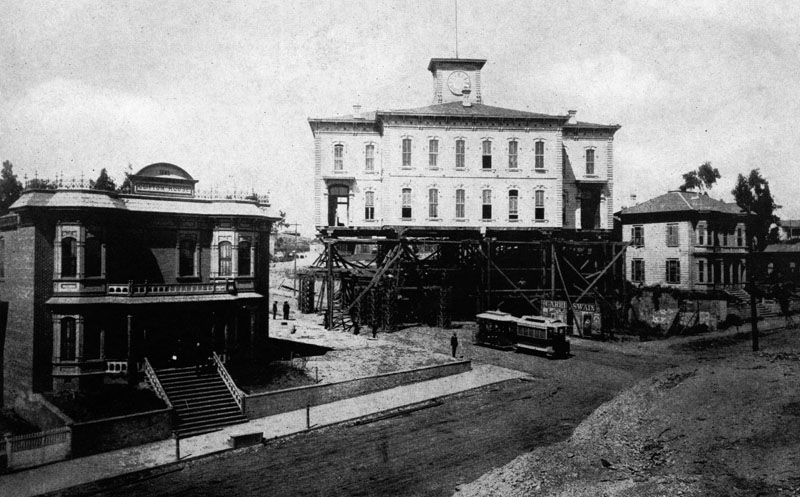 |
|
| (1886)* - View showing the Los Angeles High School building being moved over to Temple Street as a couple of people look on. A man standing at the corner of Temple and Broadway (formerly Fort Street) watches a double trolley traveling by, and two people can be seen exiting the Clifton House on the left. |
Historical Notes During the process of moving, the contractor managed to get the schoolhouse halfway up Temple Street when he ran out of money and left it right in the middle of the street. It was there for a good while. They jacked it up on scaffolding high enough for the Temple Street street cars to run under it.^* |
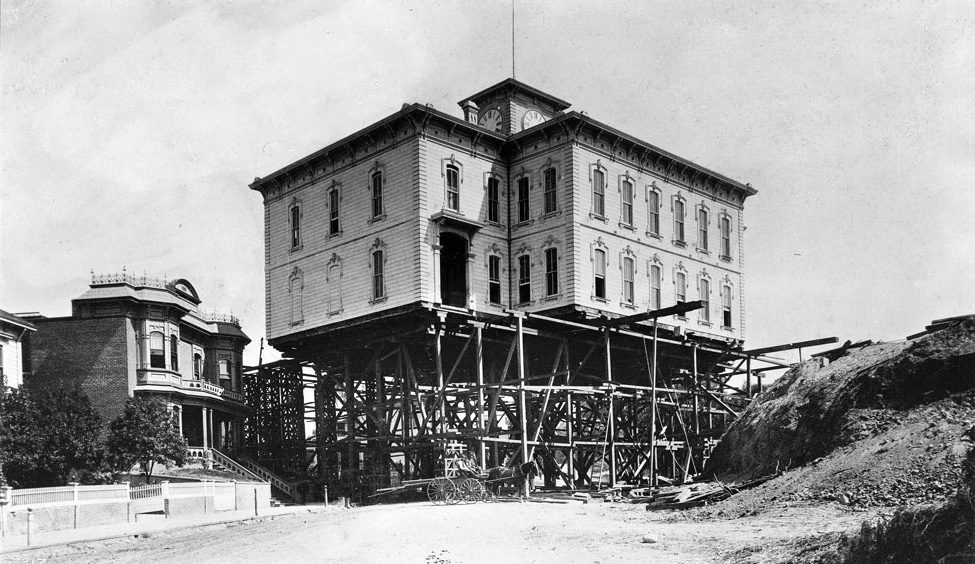 |
|
| (1886)* - Los Angeles’ first high school moved across the street from Poundcake Hill to clear space for a new county courthouse when it got stuck in the process due to the contracting running out of money. A horse-drawn wagon can be seen in the foreground. |
Historical Notes For a while, the building remained where the contractor crew left it, while a new grander high school was built atop Fort Moore Hill.^# |
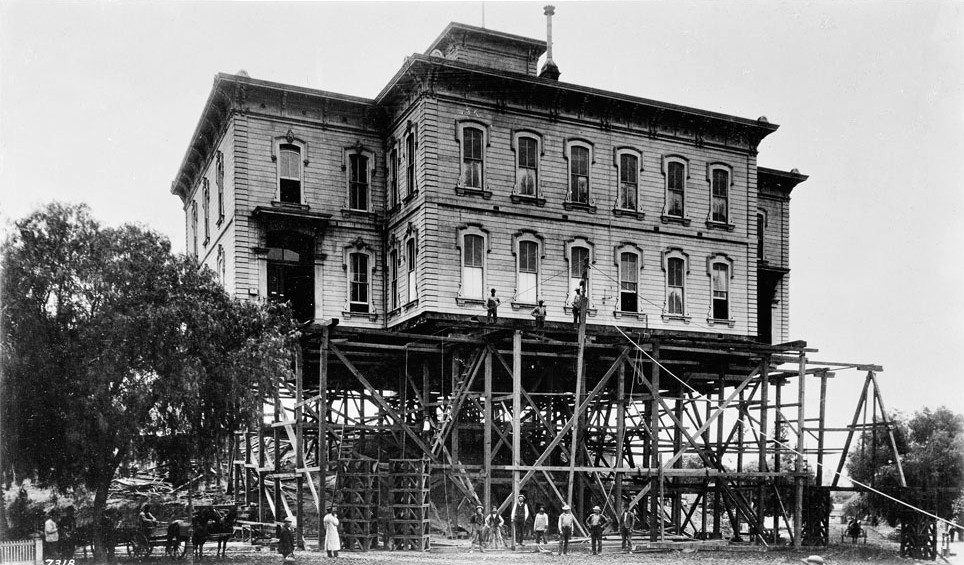 |
|
| (1886)^^* - Close-up view showing the Old Los Angeles High School building perched high above the street on scaffolding near the intersection of Temple and Broadway. The contractor left the structure in this state after cost overuns caused him to give up. |
Historical Notes Finally, they got the school building moved up to its new location on Sand Street, where Los Angeles High School students and faculty remained until the second high school, bigger and grander than the first, was built a few years later on top of Fort Moore Hill..^* |
Los Angeles High School (2nd location)
 |
|
| (1890)* - A view showing the newly constructed Los Angeles High School at its new location on Fort Moore Hill. |
Historical Notes Completed in 1891, the new Los Angeles High School replaced the original one that was built in 1872, at the former site of Central School on what was then known as Poundcake Hill, at the southeast corner of Fort Street (later Broadway). ^* |
 |
|
| (1890)^*# - Close-up view showing the front of Los Angeles High School shortly after it was completed, located on the conrer of Castelar and Rock streets. |
Historical Notes The new school was built at Castelar and Rock streets (North Hill Street and Fort Moore). The four-story red brick building had 40 rooms for its 400 students. It was the second Los Angeles High School to be built.* |
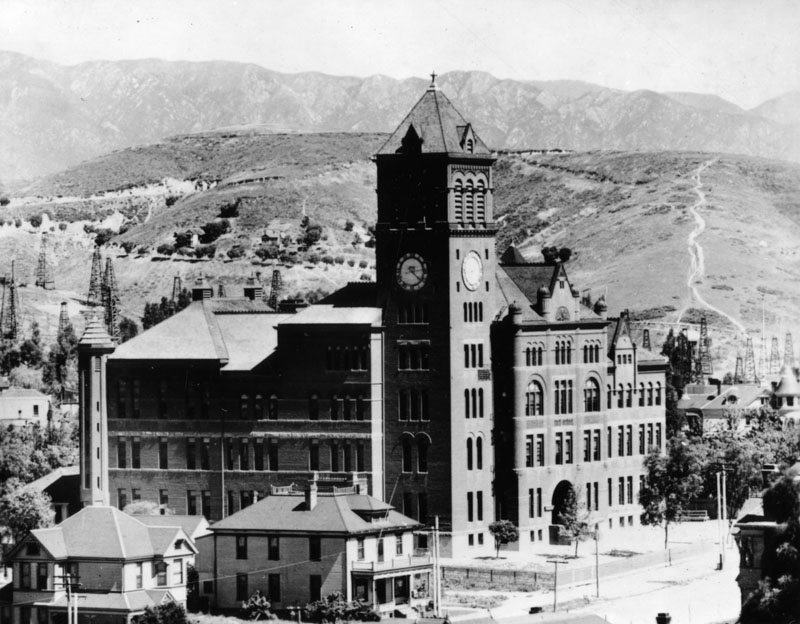 |
|
| (ca. 1901)* - View of Los Angeles High School, located on north Hill Street between California and Bellevue. Oil derricks, part of the Los Angeles Oil Field++, can be seen in the hills behind the school and to the left. |
Historical Notes The new Los Angeles High School building was enormous, especially for that time period. It was built on part of the site of the abandoned Fort Moore Hill Cemetery, the first Protestant cemetery in Los Angeles, which was spread over the slopes of the hill.^* ++Discovered in 1890, and made famous by Edward Doheny's successful well in 1892, the Los Angeles City Oil Field was once the top producing oil field in California, accounting for more than half of the state's oil in 1895. In its peak year of 1901, approximately 200 separate oil companies were active on the field, which is now entirely built over by dense residential and commercial development.*^ |
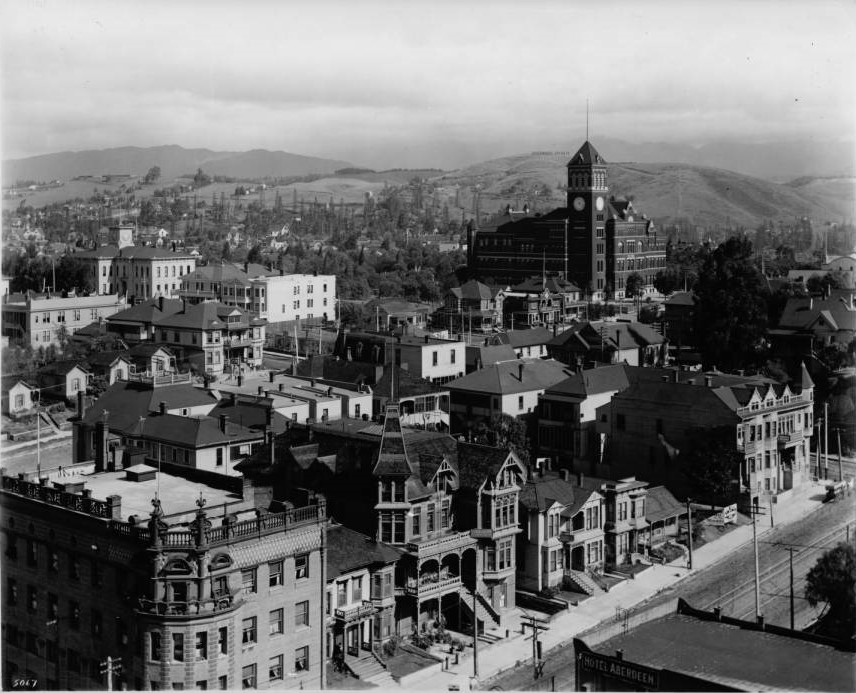 |
|
| (ca. 1905)^^* – Panoramic view looking northwest from the LA County Courthouse. Los Angeles High School stands tall in the background on Fort Moore Hill. The Temperance Temple building is seen in the lower-left located on the northwest corner of Temple and Broadway. The Broadway Tunnel is out of frame at right-center. |
Historical Notes Early buildings commissioned to house the Los Angeles High School were among the architectural jewels of the city, and were strategically placed at the summit of a hill, the easier to be pointed to with pride. One of the school's long standing mottos is "Always a hill, always a tower, always a timepiece." ^* |
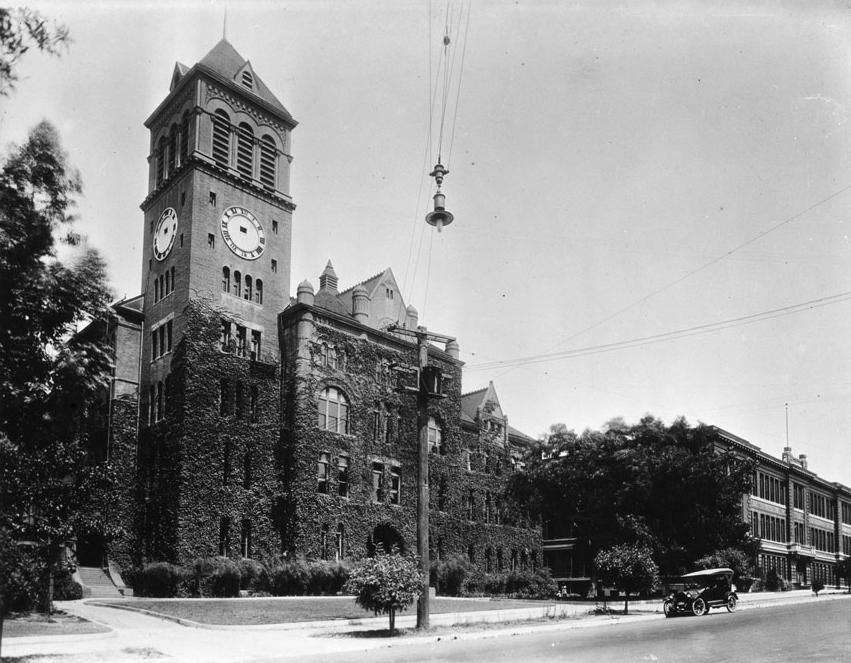 |
|
| (ca. 1910)^^* - View of Los Angeles High School, overgrown with vines. At left, the vines stop on the clock tower just beneath the clock, whose hands are missing. At right, a lone automobile is parked along the sidewalk near a second, three-story building. |
Historical Notes In 1917, Los Angeles High School moved to its current location at 4650 Country Club Drive (now West Olympic Boulevard), which incidentally is not on a hill.^* |
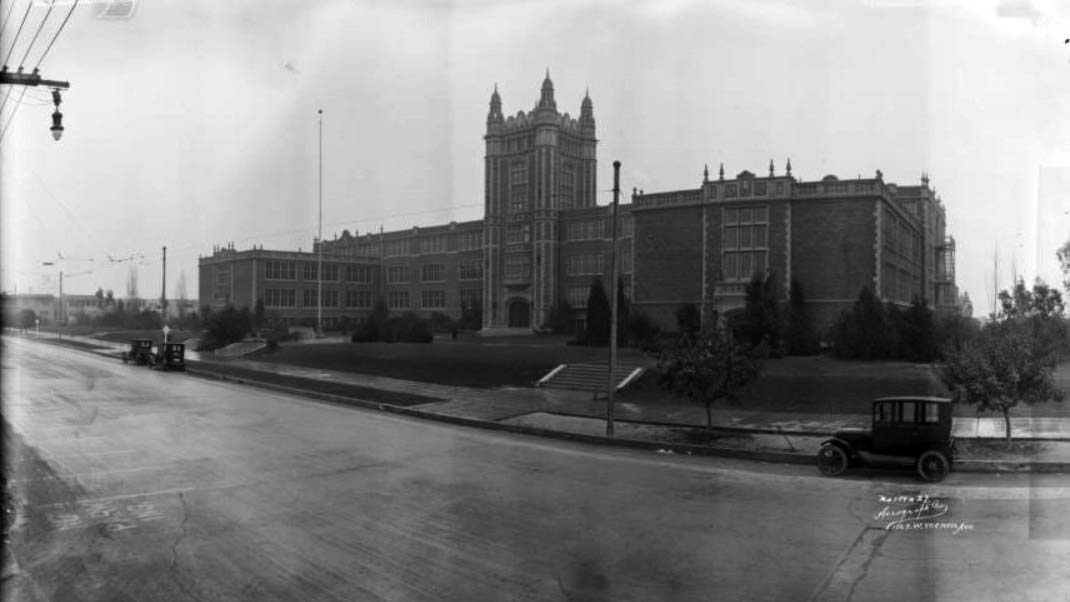 |
|
| (1924)^^* - View showing Los Angeles High School at its third location, built in 1917 and located at 4650 Country Club Drive (now Olympic Boulevard). The main building is three and a half stories, while the wings perpendicular to the street are two and a half stories, and the central tower is five or six stories. The street is empty except for three parked automobiles. |
Historical Notes Olympic Boulevard was originally named 10th Street for most of its length, except for a couple of shorter stretches, one of which was named Country Club Drive. In 1932, the entire length of the street, from East L.A. to Santa Monica, was renamed Olympic Boulevard for the Summer Olympics being held in Los Angeles that year.^* |
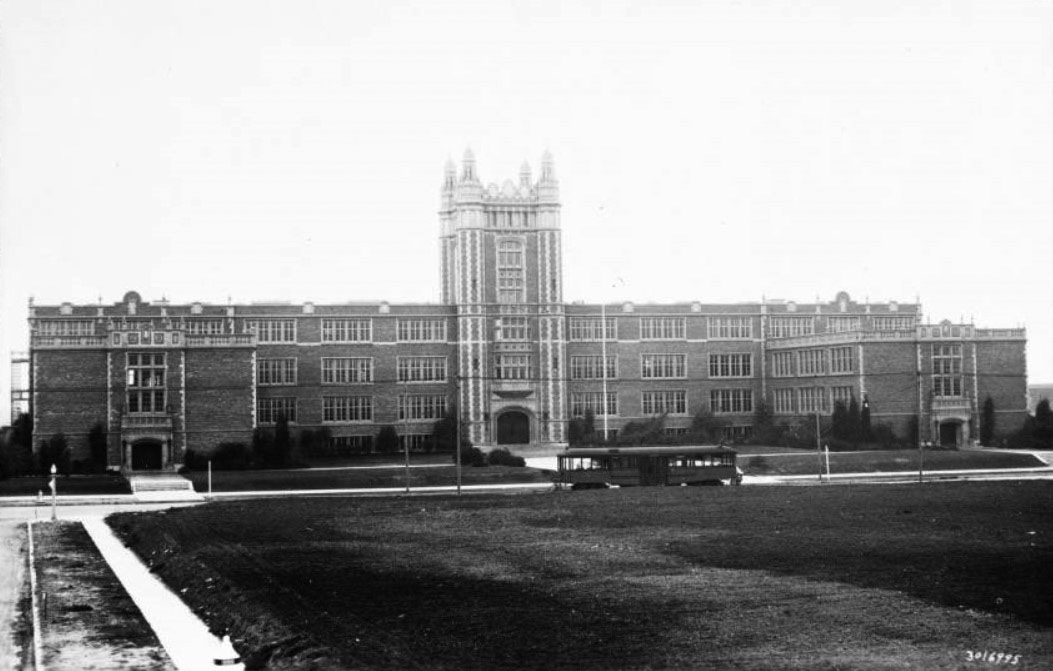 |
|
| (ca. 1925)^^* - View of Los Angeles High School with streetcar in front, as seen from what appears to be an empty lot across the street. The four-story brick building of the high school is shown at a distance in three sections: the main section of the building runs the width of the image and does not extend past four stories. At the center of this, a section of tower houses the main entrance, capped at its four corners by minarets. It adds an extra story. The third section is pictured at the far right and extends perpendicularly from the main building. It is three stories tall. |
Historical Notes To honor the graduates and under-graduates of the school who took part in the World War, in 1922 the students voted to buy the acreage across the street, a plot of ground approximately 315 by 350 feet, to be used as a memorial park. In 1923, the land was purchased by the student body and alumni association of Los Angeles High School, and deeded to the City of Los Angeles in commemoration of twenty alumni who died in World War I. Six years later, the city gave the Los Angeles Public Library the right to establish a branch on the site. In 1930, a library opened in the park (LA Public Library - Memorial Branch). The students of Los Angeles High School commissioned a stained glass window with the names of the twenty alumni and an inscription stating hope for peace among nations. The window, designed by the renowned Judson Art Studio, was inspired by those in the Parliament Building. #^^^ |
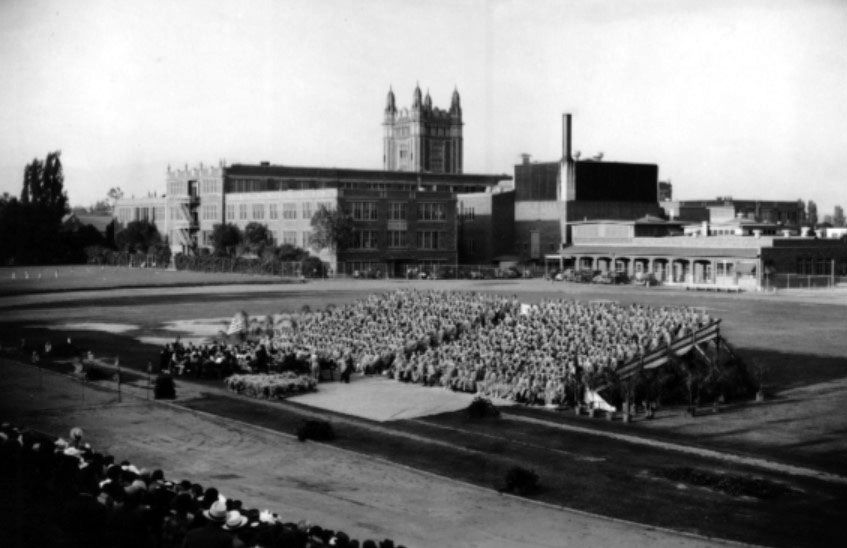 |
|
| (1940)^* - South view of Los Angeles High School, with graduating class of 1940 in foreground, 4650 W. Olympic Boulevard. |
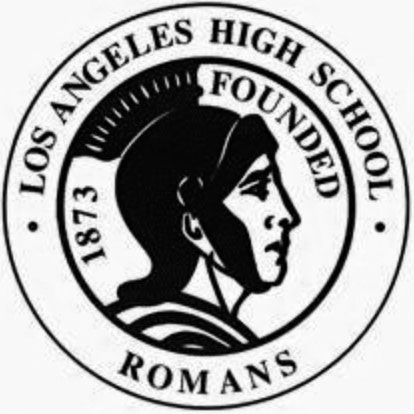 |
(2006)^* - Los Angeles High School logo. Team Name: Romans Colors: Blue and White
|
* * * * * |
St. Athanasius Episcopal Church
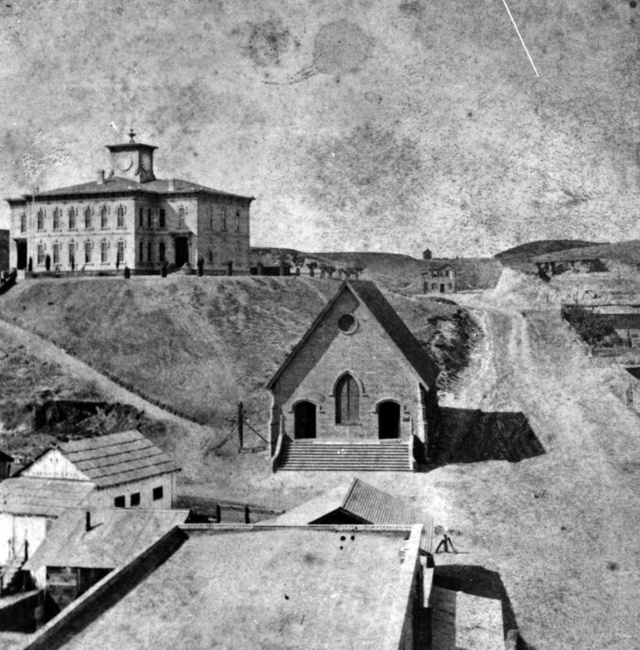 |
|
| (ca. 1874)^^* - View showing Los Angeles High School atop Poundcake Hill and St. Athanasius Episcopal Church (center), widely thought to be the first Protestant house of worship in Los Angeles. |
Historical Notes Built in 1864, St. Athanasius was the first Episcopal church in the City of Los Angeles. It was situated on the northeast corner of Poundcake Hill at Temple and New High Streets.^^* |
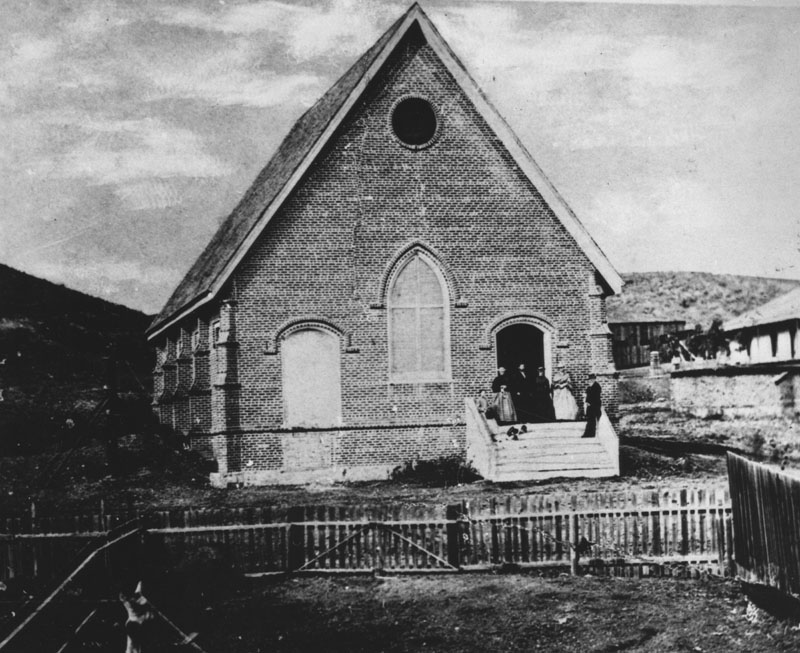 |
|
| (1879)* - Exterior view of St. Athanasius Episcopal Church showing several people standing by the front doorway. |
Historical Notes Caption on the photograph reads, "Photograph of Saint Athanasius Episcopal Church the first Protestant house of worship erected in Los Angeles in 1864. On S.W. corner of Temple and New High Streets. Rev. & Mrs. Messenger standing in doorway of the church." |
 |
|
| (1870s)^## - View looking northeast from the top of Poundcake Hill, where Los Angeles High School was located, showing the Downey Block (center) at Temple and Main streets. The building with the pitched roof in the foreground is St. Athanasius Episcopal Church. Acroos the street is the Temple Street Stables (lower-left). Also seen is the Temple Block at center-right. The Los Angeles River runs horizontally across the top of the photo and the wide street at upper left is Aliso Street where the 101 Freeway runs today. |
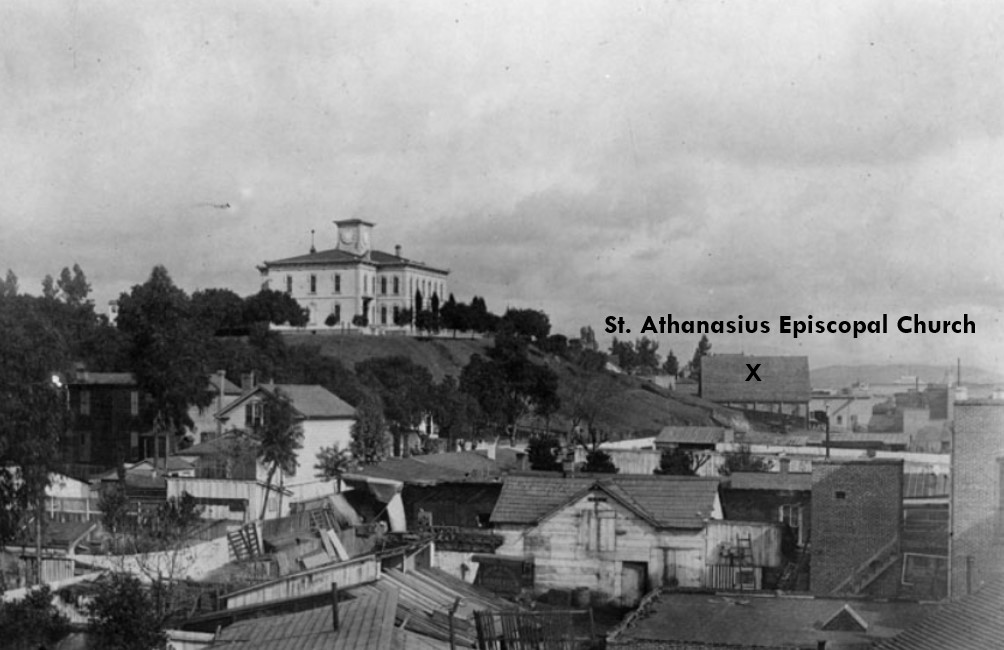 |
|
| (ca. 1883)* - View looking north showing Los Angeles High School on Poundcake Hill, taken from 1st and Spring Streets. Also seen is the profiile of Saint Athanasius Episcopal Church, marked with an X. |
Historical Notes At time of the above photo, St. Athanasius Episcopal Church had been renamed St. Paul's Church (1881).* |
 |
|
| (ca. 1884)* - View of an unpaved Temple Street, looking west as seen from the second floor of the Temple Block on Main Street. Horse-drawn carriages and wagons are parked along the street. In the right foreground is the Downey Block, housing the Crystal Palace, wholesale and retail sellers of crockery and china ware. Behind it is the Temple Street Stables. At left-center with ptiched roof and circular window is the St. Athanasius Episcopal Church located at the southwest corner of Temple and New High streets. Poles strung with electric/telephone wires are seen in the foreground. |
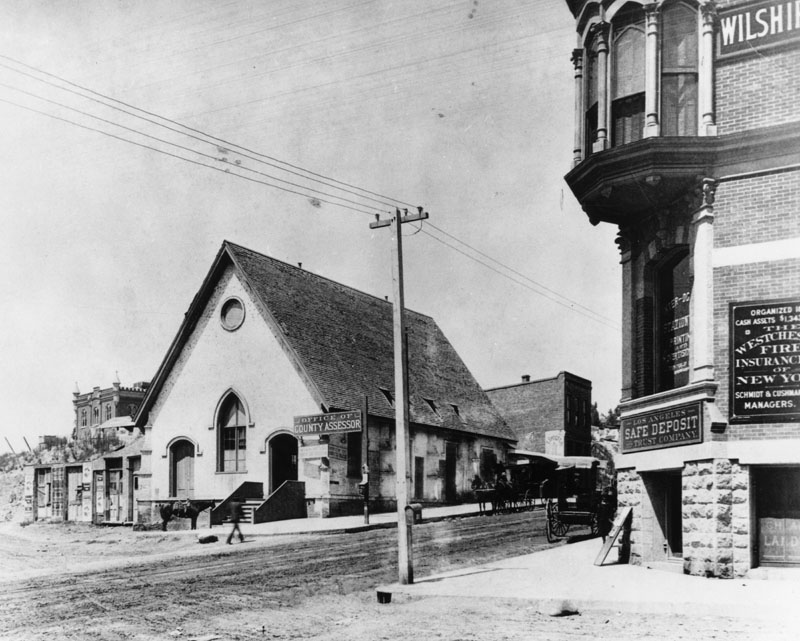 |
|
| (ca. 1884)* - Exterior view of the Los Angeles County Assessor's office, known originally as St. Athanasius Episcopal Church (St. Paul's), located on the southwest corner of Temple and New High Street. Built in 1864, St. Athanasius was the first Episcopal church in Los Angeles. |
Historical Notes In 1883, the church building was sold to Los Angeles County, and a new St. Paul's Church was built where the Biltmore Hotel now stands at Pershing Square.* |
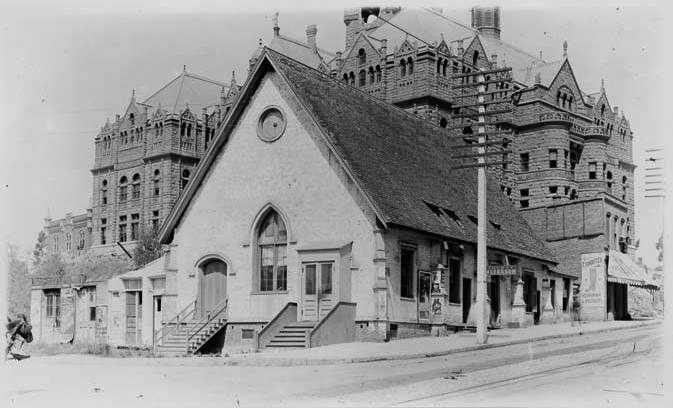 |
|
| (1891)^*# - View of the same building (originally the St. Athanasius Episcopal Church) shortly before its demise, with a clockless County Courthouse in the background. |
Historical Notes The original 1860s-era bell from St. Athanasius lives on at the Church of the Epiphany at 2808 Altura Street in Lincoln Heights.^*# |
* * * * * |
Antonio Maria Lugo Adobe
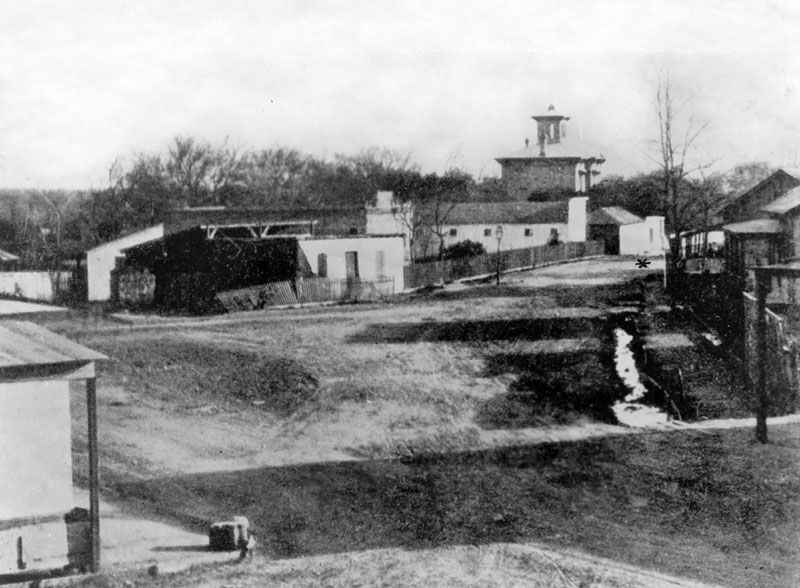 |
|
| (ca. 1875)* - Early view showing the Antonio Maria Lugo adobe, built in 1820, and located at San Pedro near 2nd Street. The Lugo adobe is indicated by a star (middle right). The large towered building seen in the center distance is the Wallace Woodworth residence. |
Historical Notes In 1810, when Antonio Maria Lugo was 35 years old and a corporal in the Spanish army stationed in Santa Barbara, he requested and was given his first land grant, the grant that included Bell Gardens. Shortly thereafter, he became mayor of Los Angeles.^#*^ |
.jpg) |
|
| (ca. 1885)^^* - Exterior view of the home of Don Antonio Mario Lugo located on San Pedro Street, near Second Street, Los Angeles. |
Historical Notes The Don Antonio Mario Lugo adobe was built in 1820. The single-story house has extended roof supported by beams at about every ten feet. A wooden fence encloses the perimeter to the right of the house. Trees are visible in the background. Picture file card reads: "1st house with wood floor?" ^^* |
* * * * * |
Los Angeles and Independence Railroad Depot
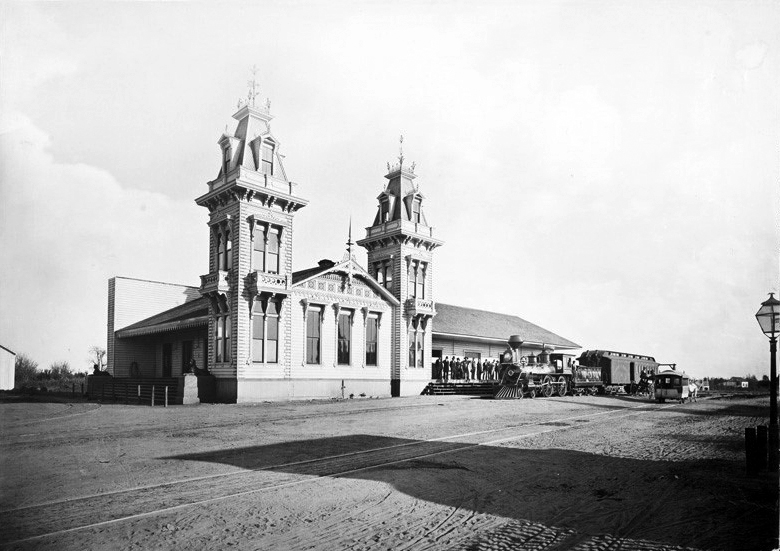 |
|
| (ca. 1875)^## – View of the Los Angeles and Independence Railroad Depot on San Pedro Street near Wolfskill Lane. There is a train stopped at the depot with several men standing on the platform. A horse-drawn wagon is also stopped near the train. |
Historical Notes The Los Angeles and Independence Railroad Company was incorporated in January 1875 with Francisco P. Temple, John P. Jones, Robert S. Baker, T. N. Park, James A. Pritchard, J. S. Slauson, and J. U. Crawford, as directors. Col. Crawford was the engineer and general manager. The 16.67 miles of track between Los Angeles and Santa Monica were privately built without government subsidies or land grants, all in a little over ten months - primarily using 67 Chinese laborers imported for the task. Right-of-way between Los Angeles and Santa Monica was given by local ranchers who were anxious to have access to a railroad. The line opened October 17, 1875, with two trains a day running between Santa Monica and Los Angeles; the fare was fixed at $1.00 per trip, freight at $1.00 per ton.^* |
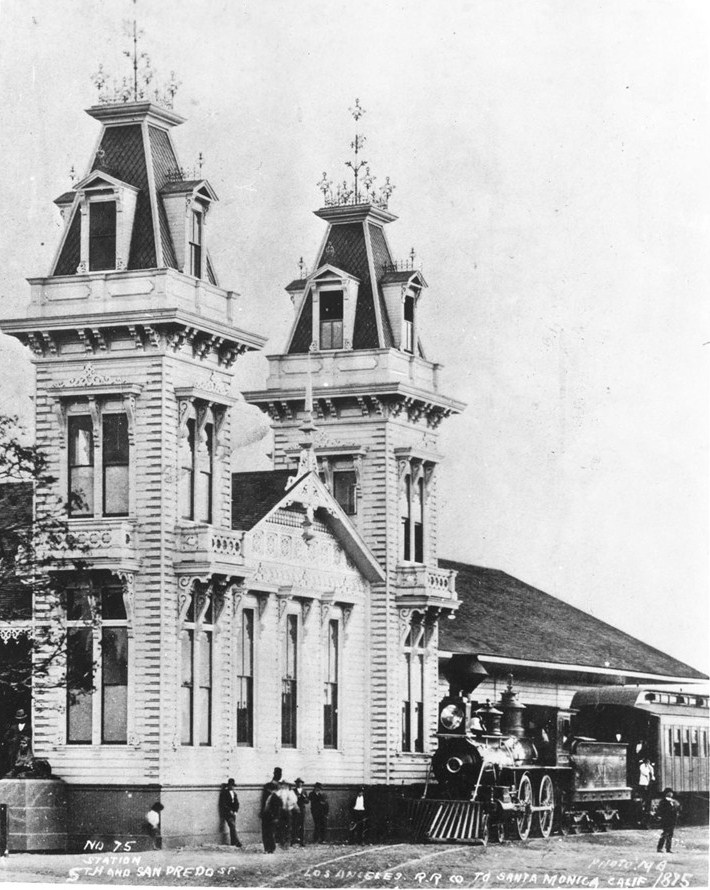 |
|
| (1875)^^* - View of a steam locomotive in front of the Los Angeles and Independence Rail Road Terminal at Fifth Street and San Pedro Street. Two lavishly decorated brick towers extend from the main building to either side of its entrance. |
Historical Notes The wood Victorian building has two three-story square towers with wrought iron work at their apexes, with dormer windows in the roofs of the towers and small decorative balconies on the second-story windows. A statue of a sphinx stands guard (on the left) next to several doors at the head of a wide set of stairs on the left side of the building (out of view).^^ |
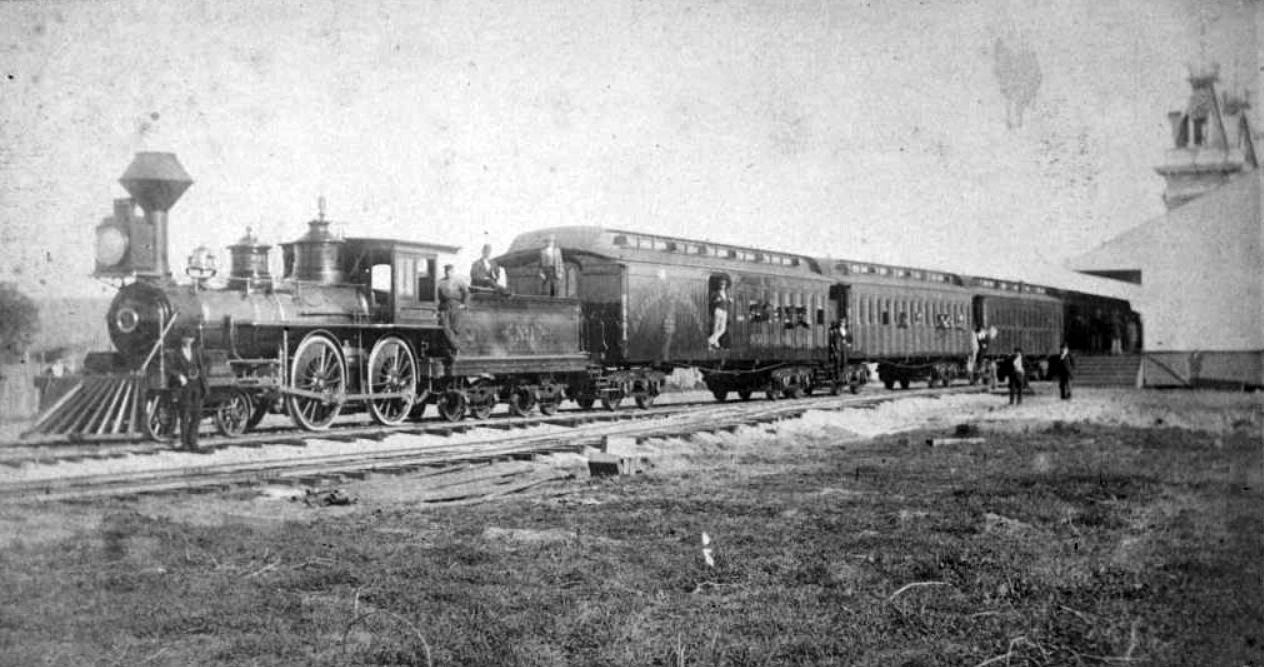 |
|
| (1876)#^ – View showing Locomotive No. 1 and passenger cars of the Los Angeles and Independence Railroad on train tracks next to the railroad's terminal at Fifth Street and San Pedro Street in Los Angeles. The train is full of passengers and is about to leave for Santa Monica. |
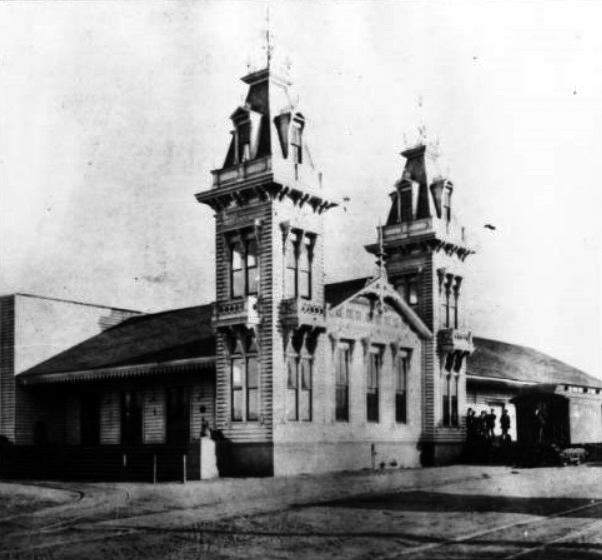 |
|
| (ca. 1877)^^ – Exterior View of the Los Angeles and Independence Railroad Depot, San Pedro Street and Fourth Street, south of Fifth Street. A group of about six people are gathered on the platform near the end of a rail car (one is on the car) on the right side of the building. |
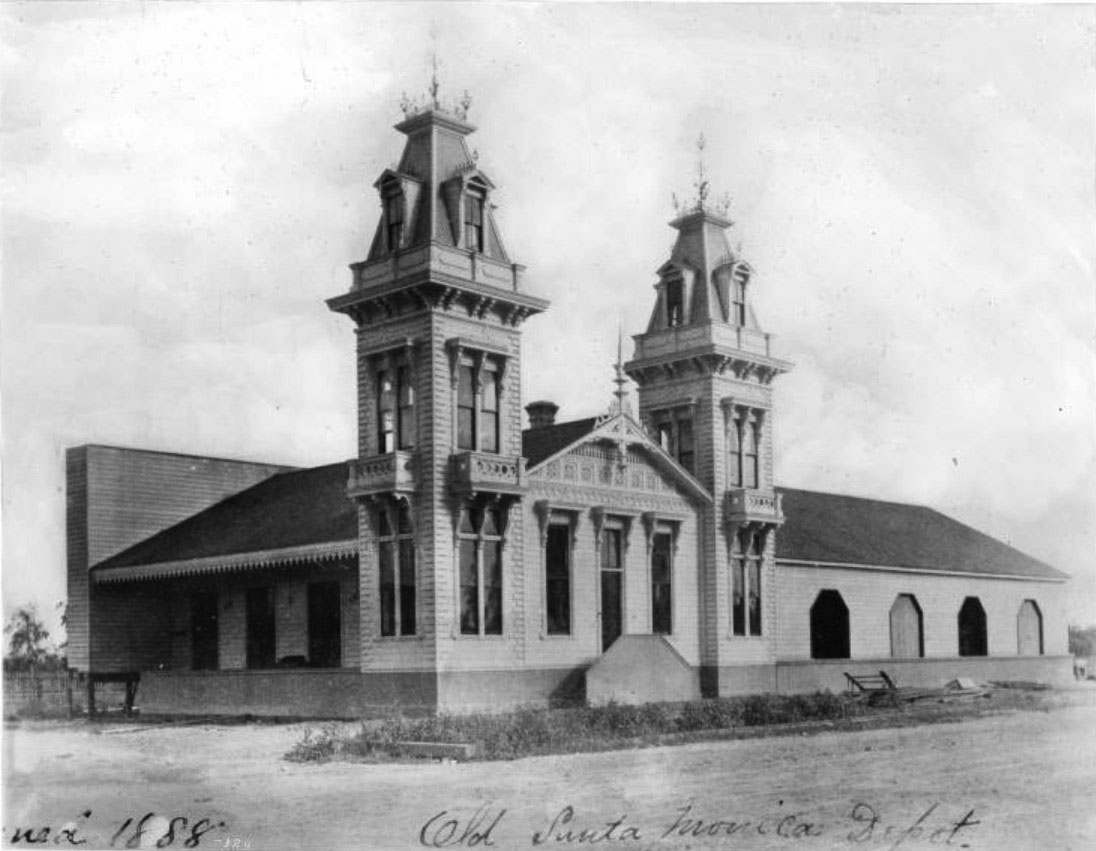 |
|
| (1888)^^* - View showing the Los Angeles and Independence Rail Road Terminal at Fifth Street and San Pedro Street. Writing at bottom of photo reads: “Old Santa Monica Depot” |
Historical Notes The railroad line, which extended to Santa Monica, was taken over by Southern Pacific, and the station was destroyed by fire in November, 1888.^^ The right-of-way was purchased by Los Angeles Metro in 1990 and is now used for the Expo Line light rail line. |
* * * * * |
LA's 1st Masonic Lodge
 |
|
| (1870s)* - View showing (from L to R): the Pico House, Merced Theater, and the Masonic Lodge. This was the "first business block on Main Street". |
Historical Notes Los Angeles Lodge No. 42 is the first Masonic Lodge established in Los Angeles, and the second oldest in all of Southern California after San Diego Lodge No. 35.+## |
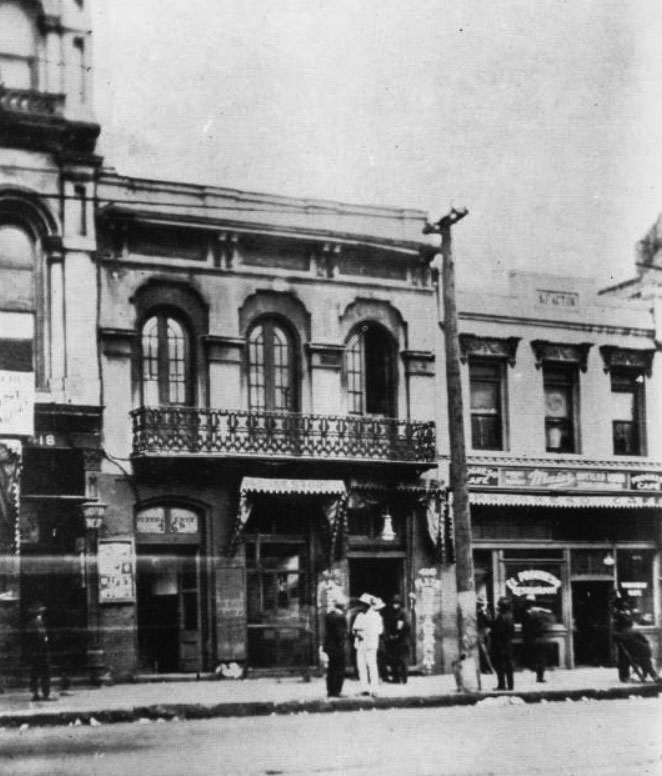 |
|
| (ca. 1885)^^*– View showing the first Masonic Lodge in Los Angeles, located at 416 ½ North Main Street. The lodge building is a two-story structure with a second floor balcony. There are three large French doors on the second story that open onto the balcony. The first floor has two doors flanking an awning covered window. Several pedestrians are standing in small groups on the sidewalk in front of the lodge. |
Historical Notes The first Lodge building was completed in 1858, and is where the Mason’s meeting place until 1868.+## |
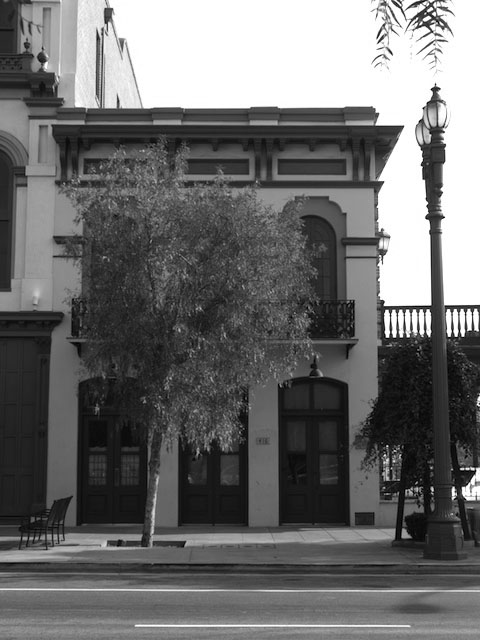 |
|
| (ca. 2006)+## - View showing the Old Lodge Building on Main Street as it apears today. |
* * * * * |
McDonald Block
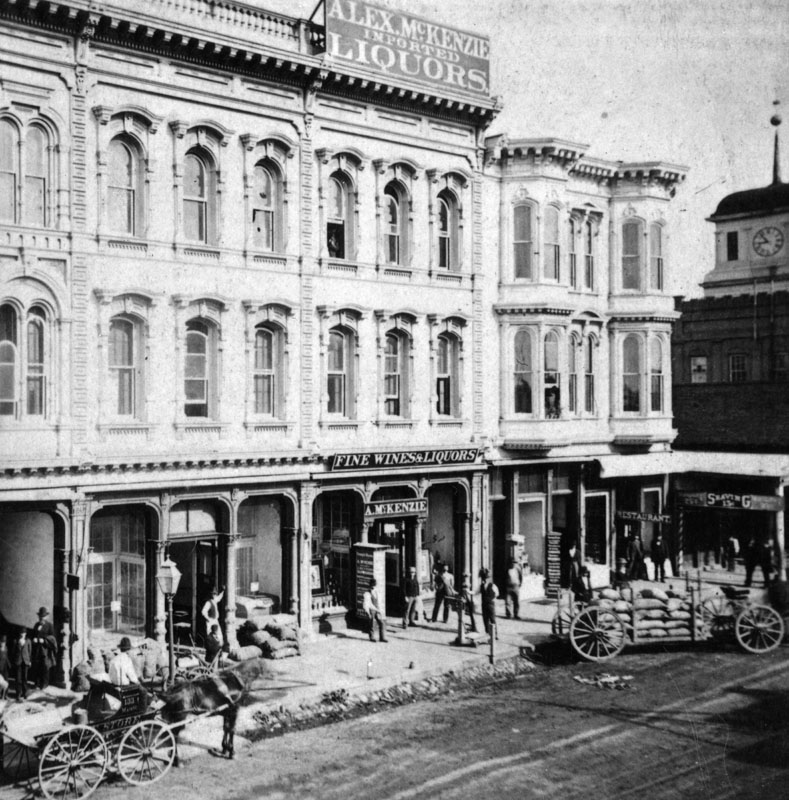 |
|
| (1876)* - Main Street between 1st and Court, Old McDonald Block, showing Alex McKenzie liquor store. John Temple's old courthouse building can be seen on the right. |
Historical Notes The first organizational meetings of the Los Angeles Athletic Club (LAAC) were held in the law offices of Judson, Gillette, and Gibson on the second floor of the old McDonald Block on Main Street in 1880. James B. Lankershim was the first president of the LAAC. He later became a leading developer of the downtown business district.*#^# |
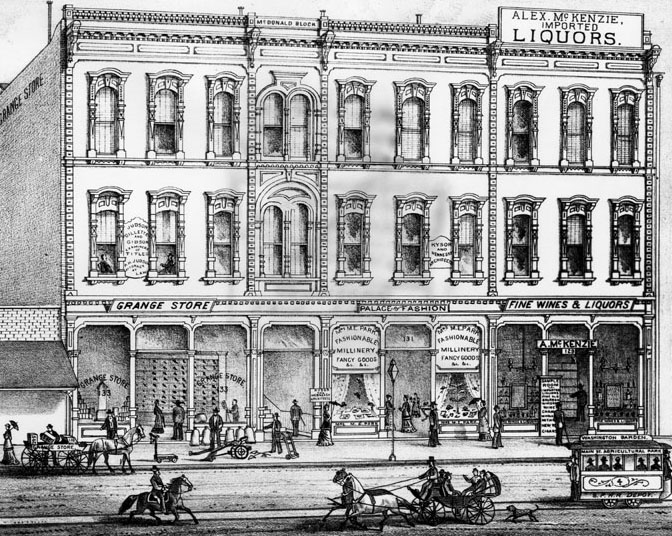 |
|
| (1880)* - Lithograph of McDonald Block building on Main Street, 1880. |
* * * * * |
Baker Block
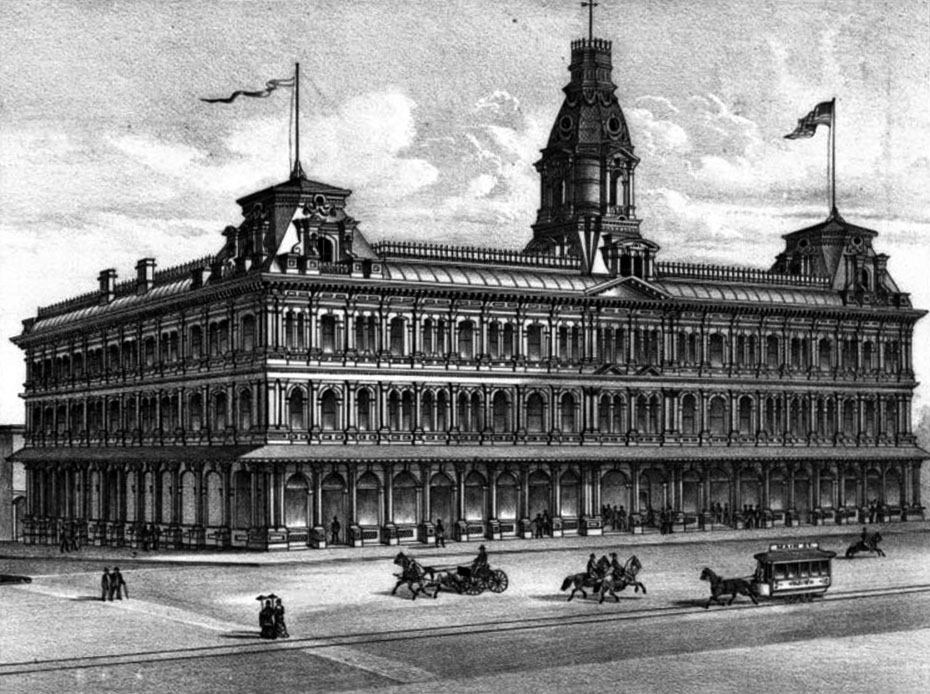 |
|
| (1880)^^* - Photograph of a lithograph of the Baker Block on the southeast corner of Main Street and Arcadia Street. The three-story building is a large rectangular building with short towers on the corners and massive domed tower at center. The building is Victorian style, with large arched windows on all three levels. |
Historical Notes The above lithograph was from Thompson and West's History of Los Angeles County, published in 1880.^^* |
 |
|
| (1880)* - Built on the former site of the residence of Abel Stearns, the Baker Block was prominent in Los Angeles. The telegraph office has a sign at the corner of the building. |
Historical Notes The ornate three-story Baker Block was completed in 1878 by Colonel Robert S. Baker. Located at the north end of the 300 Block of N. Main Street, Baker Block was long considered the best thing in town and an early microcosm of city life. Offices for lawyers, physicians and businessmen were on the second floor and on the top floor were the City's most costly and fashionable apartments. As a point of interest, Colonel Robert Baker married Abel Stearn’s widow, Arcadia Bandini de Stearns, in 1874 (three years after Stearn’s death in 1871). The Baker Block was built on the same site as the Stearns Adobe four years later. |
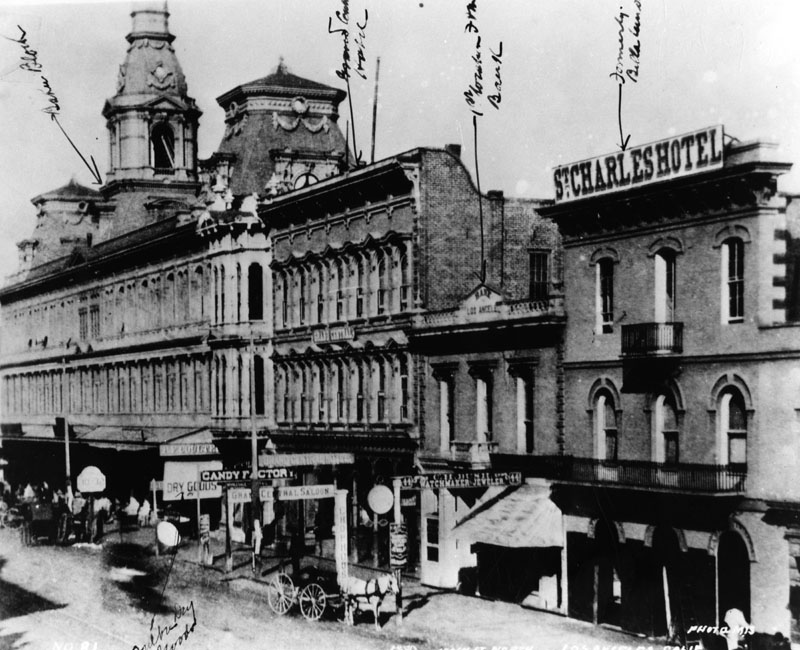 |
|
| (ca. 1880)* - View of North Main Street. Baker Block is on the left and the St. Charles Hotel, formerly the Bella Union Hotel, is on the right. |
Historical Notes At the time of its completion, Baker Block was reputedly the largest and most expensive structure to have been built south of San Francisco. Among other achievements, it is also believed to have been Los Angeles’ first steel-framed building, and it's first to have tiled floors. #^*# |
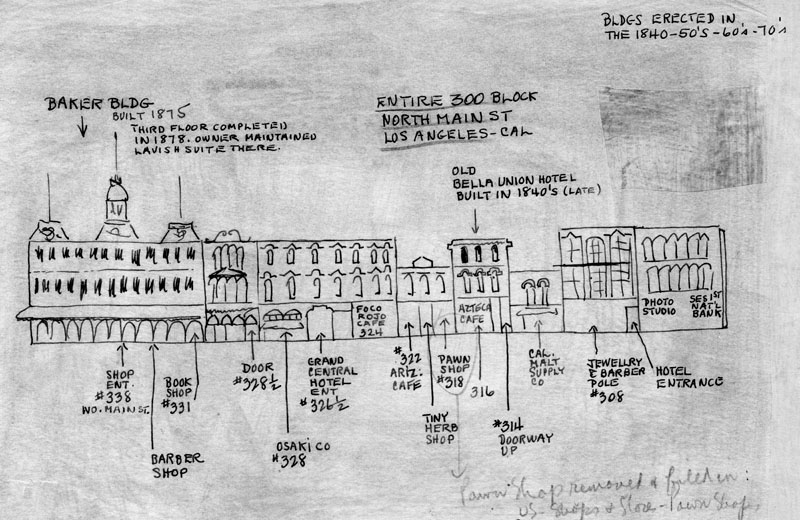 |
|
| (n.d.)* - Drawing of North Main Street, showing the location of the businesses in the entire 300 block, starting with the Baker Block on the left. The Baker Block was built in stages starting in the late 1840s through 1875. |
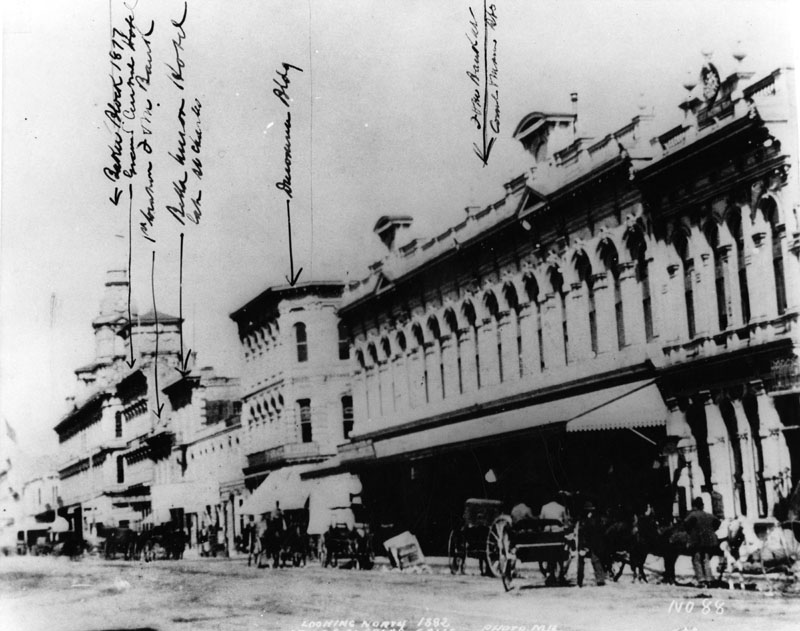 |
|
| (1882)* - View looking north on Main Street with buildings annotated. The Farmers and Merchants Bank opened October 29, 1882 in the Hellman Building. First National Bank, formerly Commercial Bank, was in the building on the right. The Baker Block is at the far left and the Ducommun Building can be seen at center-left of photo. |
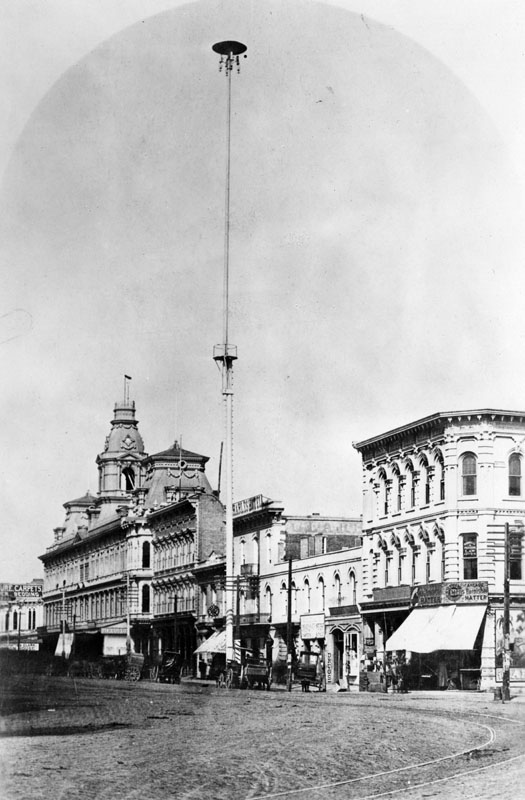 |
|
| (ca. 1882)**- One of the first of seven electric street lights installed in the City of Los Angeles at Main Street and Commercial Street in 1882. It stood 150 feet tall. Baker Block is on the left and the Ducommun Building on the right. |
Historical Notes Each of the 150-foot-high masts carried three carbon-arc lamps of three thousand candle-power. All seven lamps and a small power plant to provide the electricity were installed by C. L. Howland in 1882. In 1883, Howland and others formed the Los Angeles Electric Company.** Click HERE to see more in Early Los Angeles Street Lights. |
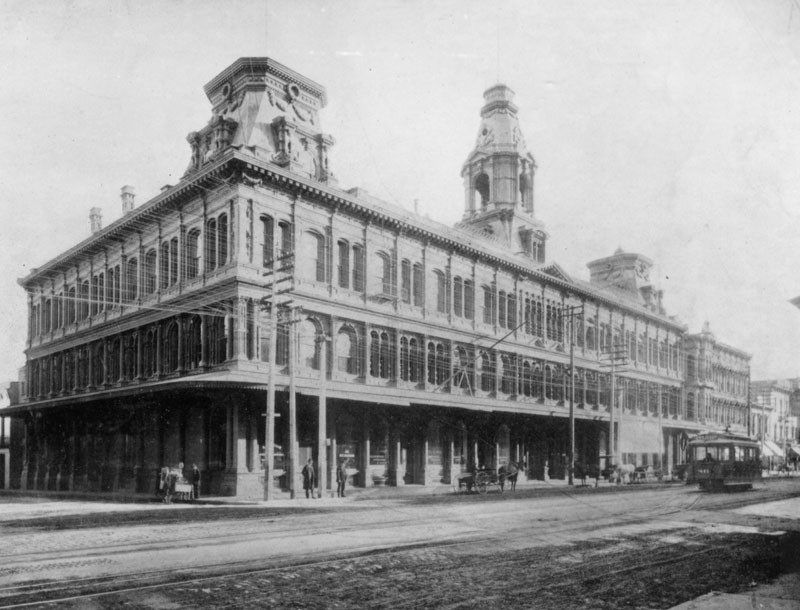 |
|
| (ca. 1890s)* - View looking southeast showing the Baker Block on the corner of North Main and Arcadia streets. |
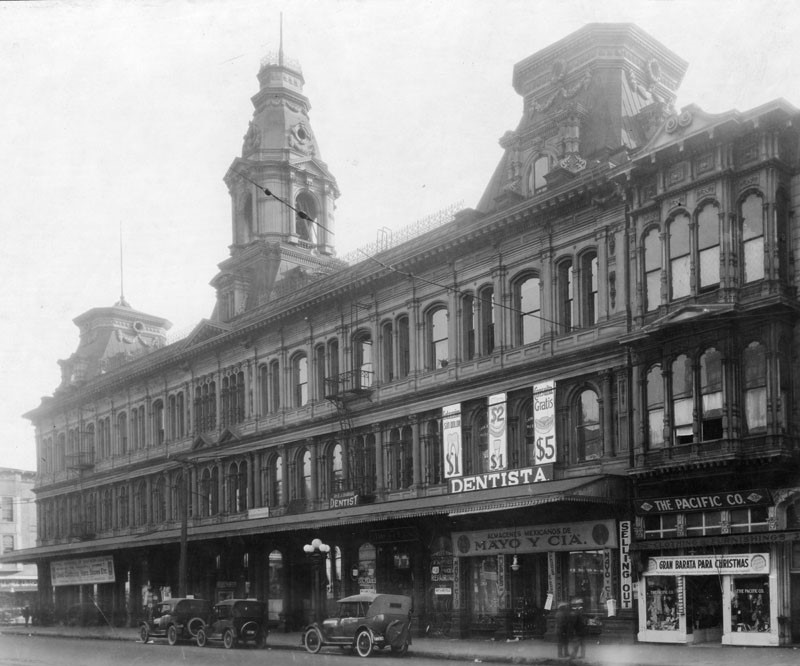 |
|
| (ca. 1920)* - View showing the Baker Block, located at 342 North Main Street at the corner of Arcadia Street (far left). |
.jpg) |
|
| (ca. 1930)^^* - Aerial view as seen from City Hall showing the Baker Block located at the north end of the historic 300 Block of N. Main Street. |
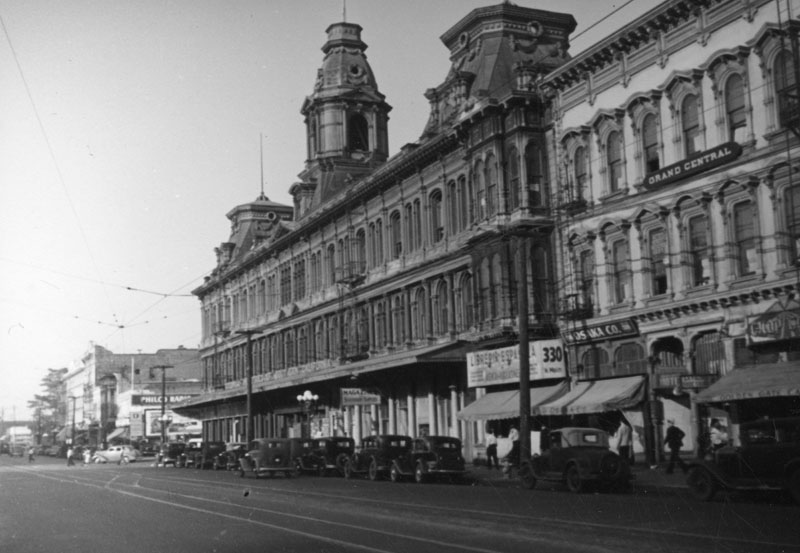 |
|
| (ca. 1930s)* - Looking across N. Main Street (foreground) towards the French Second Empire style Baker Block, on the southeast corner at Arcadia Street (lower left), and the Grand Central Hotel (right). Photo by Herman Schultheis. |
Historical Notes The Baker Block had lost much of its luster by the turn of the century, and by the time it was purchased by Goodwill Industries in 1919, it was all too clear that its days were numbered. As cruel fate would have it, the faded landmark was slated to give way to one of the most mundane projects in the 1930 Civic Center plan: a two-block extension of Aliso Street from Los Angeles Street to Broadway. #^*# |
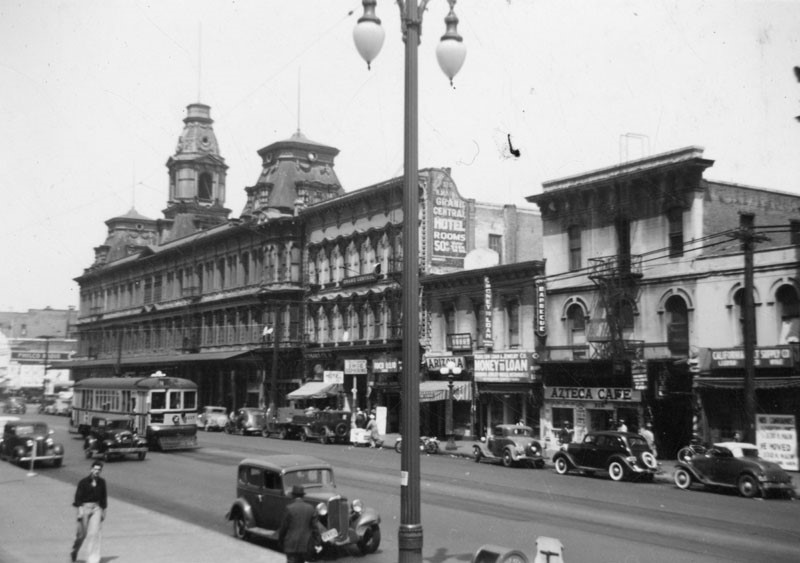 |
|
| (ca. 1940)* - View looking northeast showing the Baker Building (Block) and other buildings on the 300 Block of N. Main Street shortly before their demoliton. |
Historical Notes Despite plans to relocate the structure for another purpose, the city purchased the Baker Block from Goodwill in 1941 and demolished the building a year later. U.S. Route 101 now runs beneath where these buildings once stood.* |
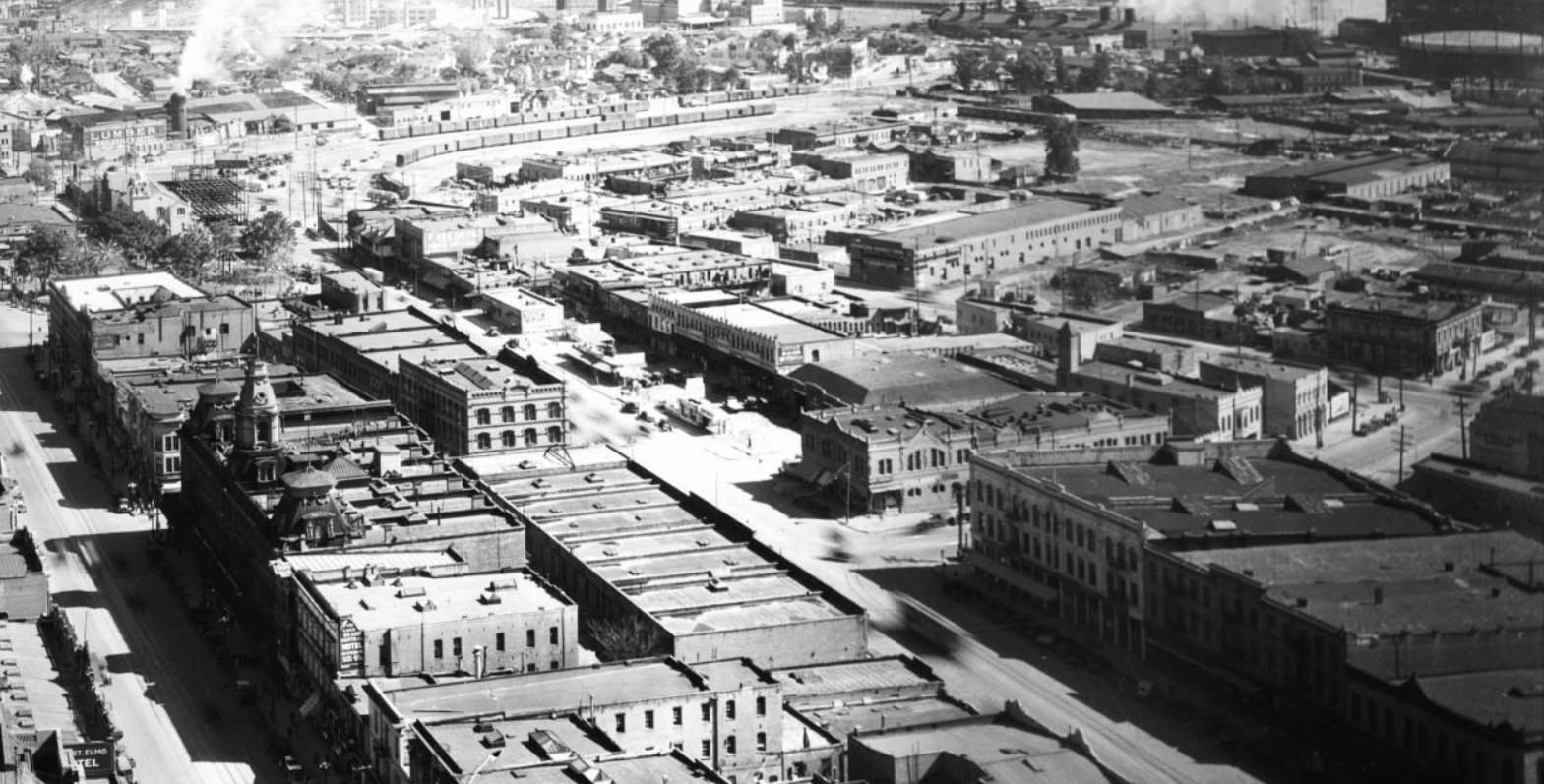 |
|
| (ca. 1930)^^* - View looking northeast from City Hall showing the old part of Los Angeles including the LA Plaza and Chinatown. At left can be seen the ornate Baker Building with its three towers located on the historic 300 block of N. Main Street. Los Angeles Street runs diagonally from lower-right to upper-left. Aliso Street runs from Los Angeles Street at center east and then turns diagonally up. Union Station wasn't completed until 1938 and would be located in the upper right of photo. |
Historical Notes In 1942, Baker Block and all the buildings on the 300 Block of N. Main Street were demolished to extend Aliso Street from Los Angeles Street to Broadway. Several years later the Hollywood Freeway (Route 101) would be constructed over this new Aliso Street extension. |
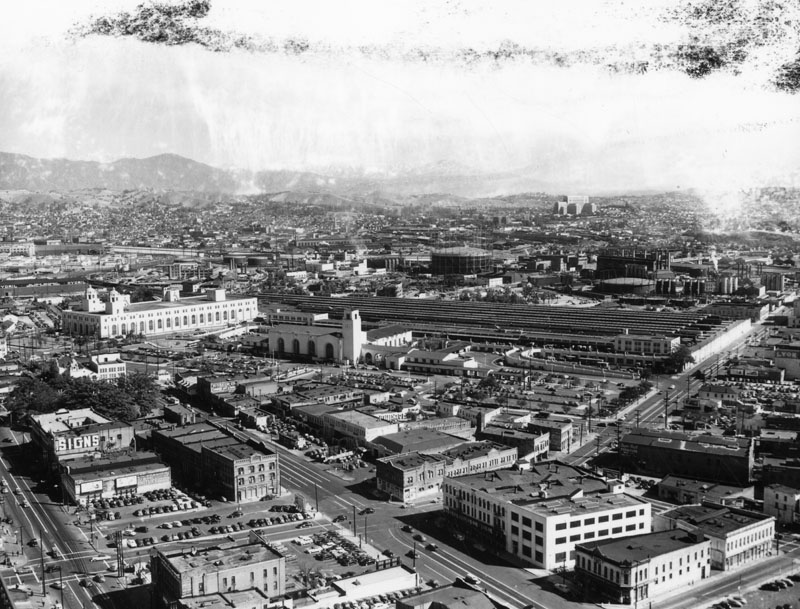 |
|
| (ca. 1951)* - Aerial view of Los Angeles near the Plaza after extension of Aliso Street. Union Station is seen at center and the LA Plaza at left-center. The 300 Block of N. Main Street, where the Baker Block once stood, is at lower left. It now consists of mostly parking lots and, of course, the new Aliso Street extension. |
Historical Notes In the early 1950's, the Hollywood Freeway (U.S. Route 101) would be constructed in line with Aliso Street. |
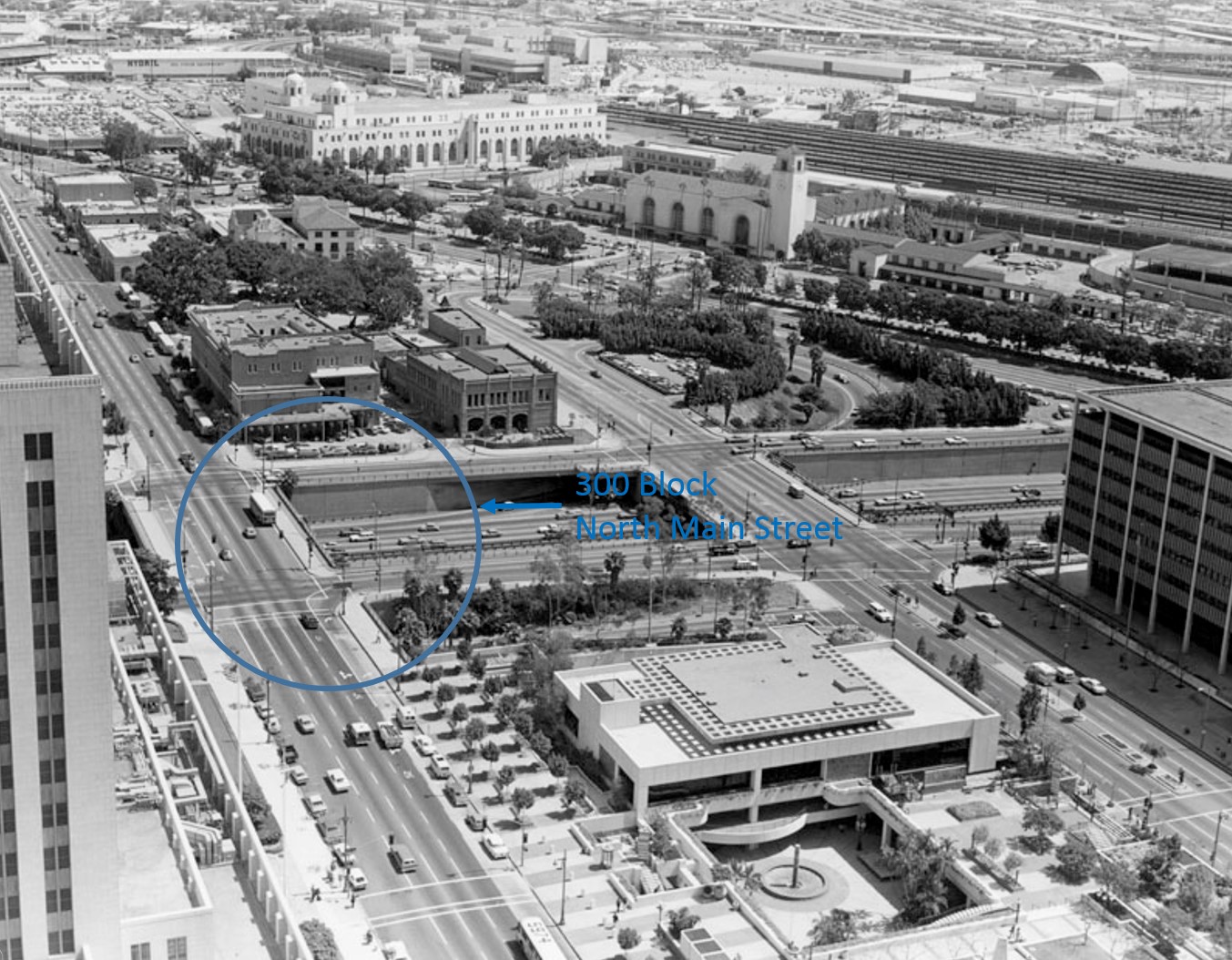 |
|
| (1970s)* - View from City Hall looking down toward the 300 Block of N. Main Street. The Hollywood Freeway (U.S. Route 101) now runs beneath where the Baker Block once stood. |
Historical Notes The Hollywood Freeway through downtown was opened in 1954. |
Then and Now
.jpg) |
|
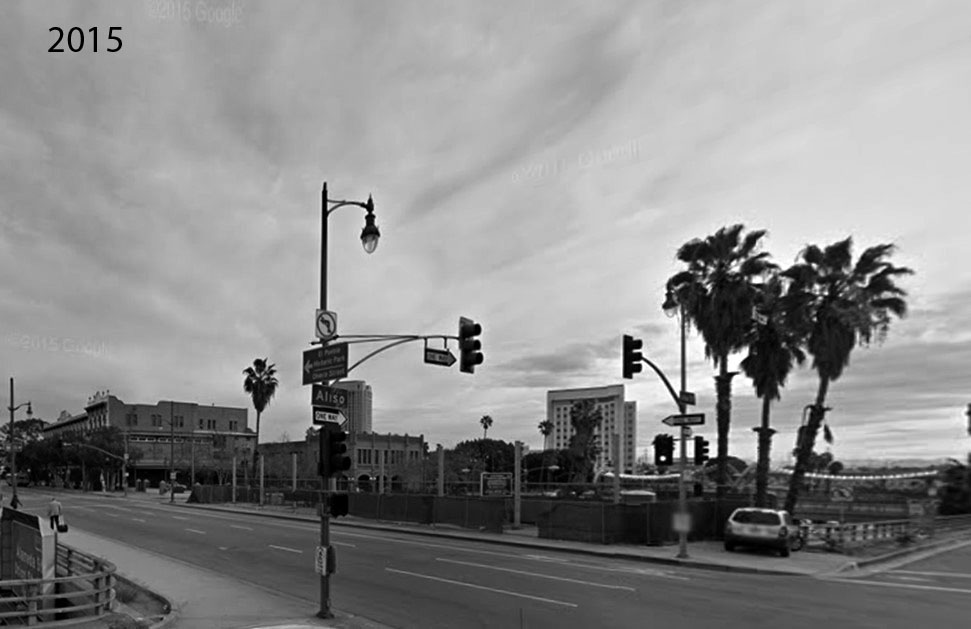 |
* * * * * |
Please Support Our CauseWater and Power Associates, Inc. is a non-profit, public service organization dedicated to preserving historical records and photos. We are of the belief that this information should be made available to everyone—for free, without restriction, without limitation and without advertisements. Your generosity allows us to continue to disseminate knowledge of the rich and diverse multicultural history of the greater Los Angeles area; to serve as a resource of historical information; and to assist in the preservation of the city's historic records.
|
For more Historical Los Angeles Views click one of the following:
For Other Historical Views click one of the following:
See Our Newest Sections:
To see how Water and Electricity shaped the history of Los Angeles click one of the following:
Water:
Power:
References and Credits
**DWP - LA Public Library Image Archive
* LA Public Library Image Archive
*# Mojave Desert.net: Remi Nadeau
#* Ancestory.com - Margarita Bandini Winston
#^ Huntington Digital Library Archive
^# KCET - The Lost Hills of Downtown Los Angeles
+^Old Los Angeles and Environs blogspot
*+ The Jews of Los Angeles: Urban Pioneers
#**OUTPOST – Preserving Historical Data by W. S. Broke
#++National Geographic: California Before the Stars Arrived
++#Flickr.com
**^LA Fire Department Historical Archive; Belmont Hotel Fire
^##California State Library Image Archive
^^#The Museum of the San Fernando Valley
*^#CSULB - A Visit to Old LA: Hamburger Dept. Store; Main Street
^**UCLA-DWP Library Collection: Map of the City of Los Angeles as it Appeared in 1850
^*#Noirish Los Angeles - forum.skyscraperpage.com; Temple Block; Melrose and Richelieu Hotels; Hollenbeck Residence
***Los Angeles Historic - Cultural Monuments Listing
*^*California Historical Landmarks Listing (Los Angeles)
*#^Picture Gallery of Los Angeles History
*#*Historic Hotels of Los Angeles and Hollywood (USC - California Historic Society): Bella Union Hotel; Belmont Hotel; U.S. Hotel
##* Boston Public Library: Flickr.com
###Denver Public Library Image Archive
^***Homestead Museum: Workman and Temple Family
^**^Wilmington Historic Society
*^^*Los Angeles Past: Temple and Main Streets, Los Angeles - Then and Now
^^**Flickr.com - Floyd B. Bariscale Photostream: Dodson Residence
*^**Paradise Leased: Arcadia Hotel
**^*Santa Monica Beach Stories
**^^Boyle Heights History Blog: Hollenbeck Park
^#*^LA Times: Amestory Building; Don Antonio Maria Lugo
^**#LMU Digital Collection: Arcadia Hotel
^^*#Jewish Museum of the American West: Jacoby Brothers
**#^LAPL-El Pueblo de Los Angeles Historical Monument Photo Archive
*#^#Los Angeles Athletic Club History
^#*^LA Times: Newmark Fountain
*#^^A House for Equal Justice - Judge Elizabeth R. Feffer
#^*#Urban Diachrony: East side of North Main Street south of Arcadia Street
#^^#Los Angeles County Bar Association: Courthouse Clock
^##^Los Angeles Downtown News.com: A True Soap Opera
##^*Publicartinla.com: Bella Union Hotel Site
#***LAUSD.net; LA Memorial Library
#*^*Photos of Vintage Los Angeles: Facebook.com
#*^^Flickr.com: Views of Los Angeles
^* Wikipedia: Abel Stearns; Pío Pico; Workman-Temple Family; Jonathan Temple; Los Angeles Herald-Examiner; Charles Maclay; Los Angeles High School; Cathedral of Saint Vibiana; John Edward Hollenbeck; Foy House; Isaias W. Hellman; Isaac Newton Van Nuys; Wells Fargo; Los Angeles Plaza Historic District; Harrison Gray Otis; Harris Newmark; Los Angeles Athletic Club; The Church of Our Lady the Queen of Angels; Los Angeles and Independence Railroad; Phineas Banning; UCLA; History of UCLA; Garvanza, Los Angeles; Highland Park; Ozro W. Childs; Ducommun; James H. Dodson Residence; Domingo Amestoy; History of Los Angeles Population Growth; Spring St. School; Fort Moore; Los Angeles High School; Harris Newmark
< Back
Menu
- Home
- Mission
- Museum
- Mulholland Service Award
- Major Efforts
- Board Officers and Directors
- Positions on Owens Valley and the City of Los Angeles Issues
- Legislative Positions on
Water Issues
- Legislative Positions on
Energy Issues
- Recent Newsletters
- Historical Op Ed Pieces
- Membership
- Contact Us
- Search Index